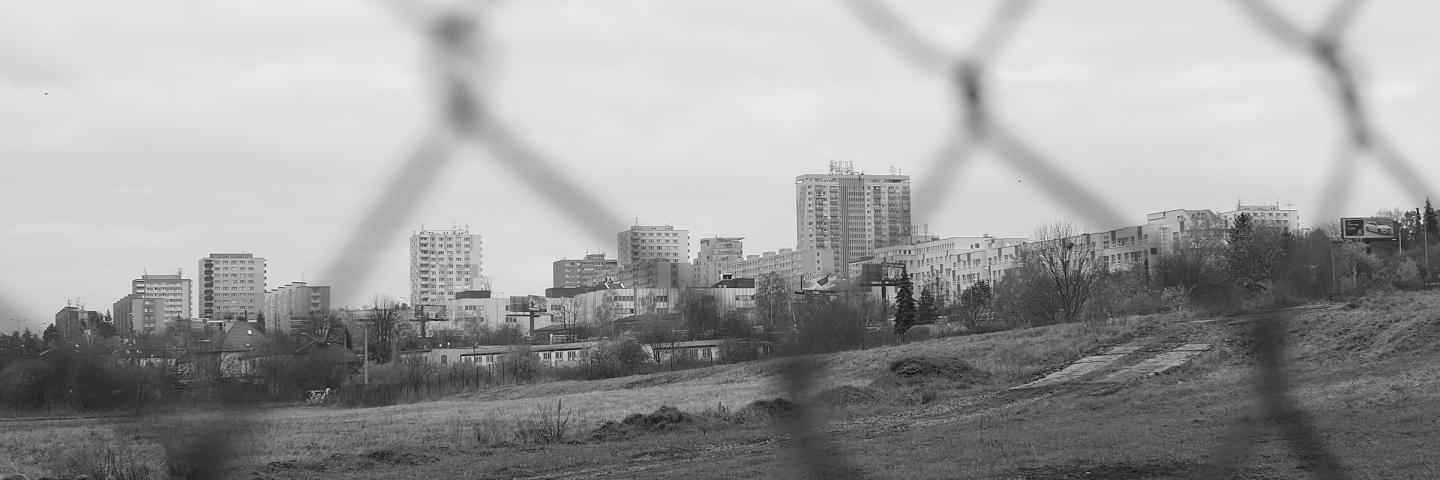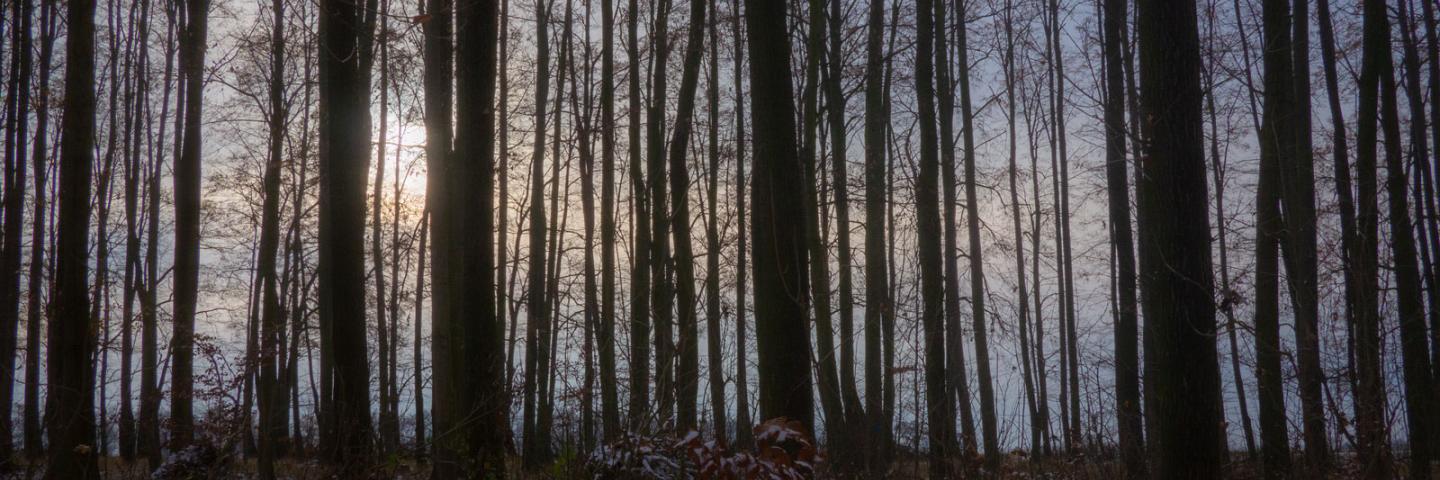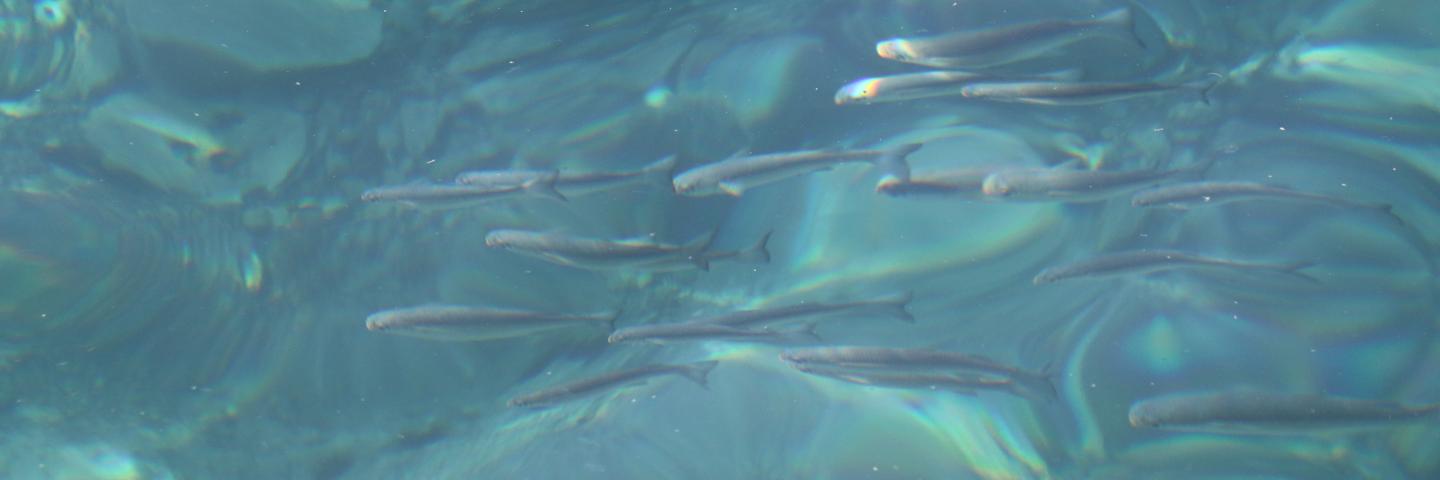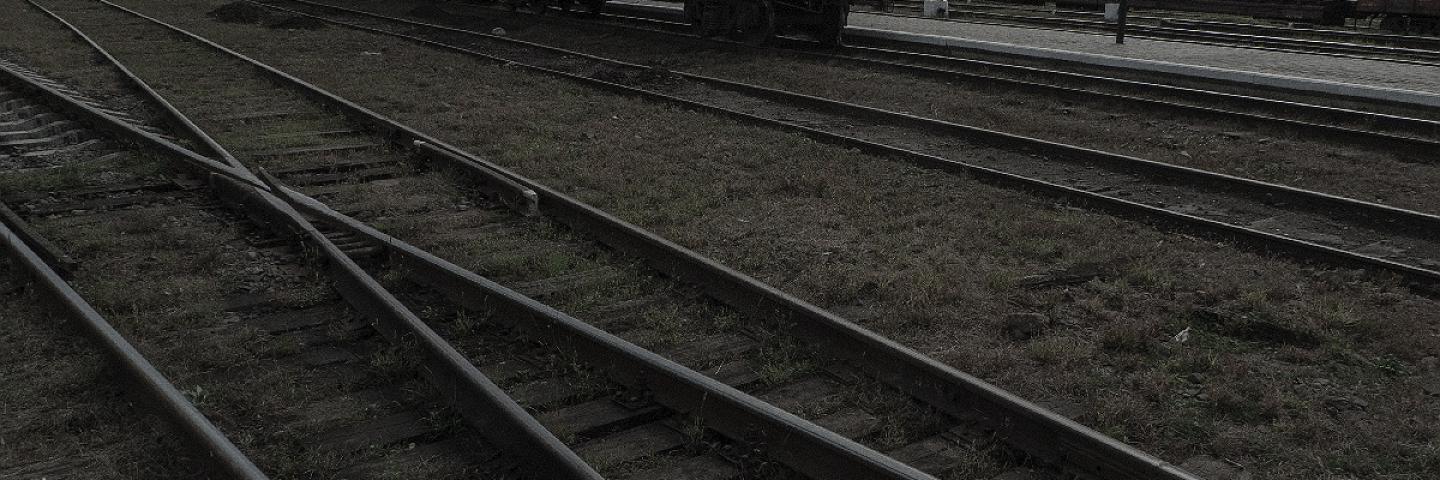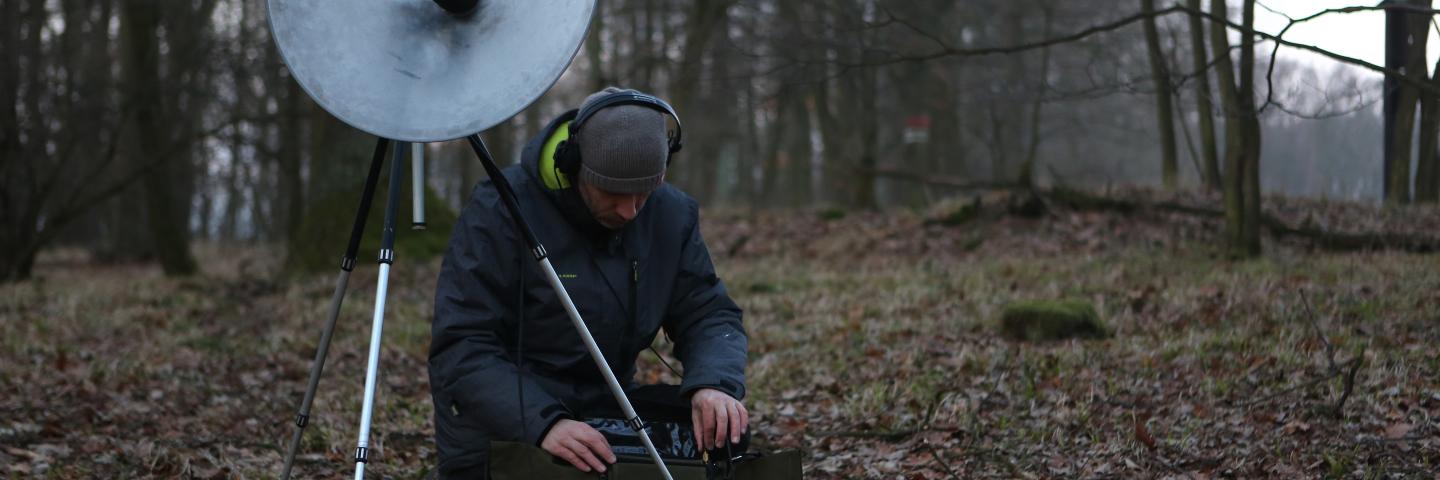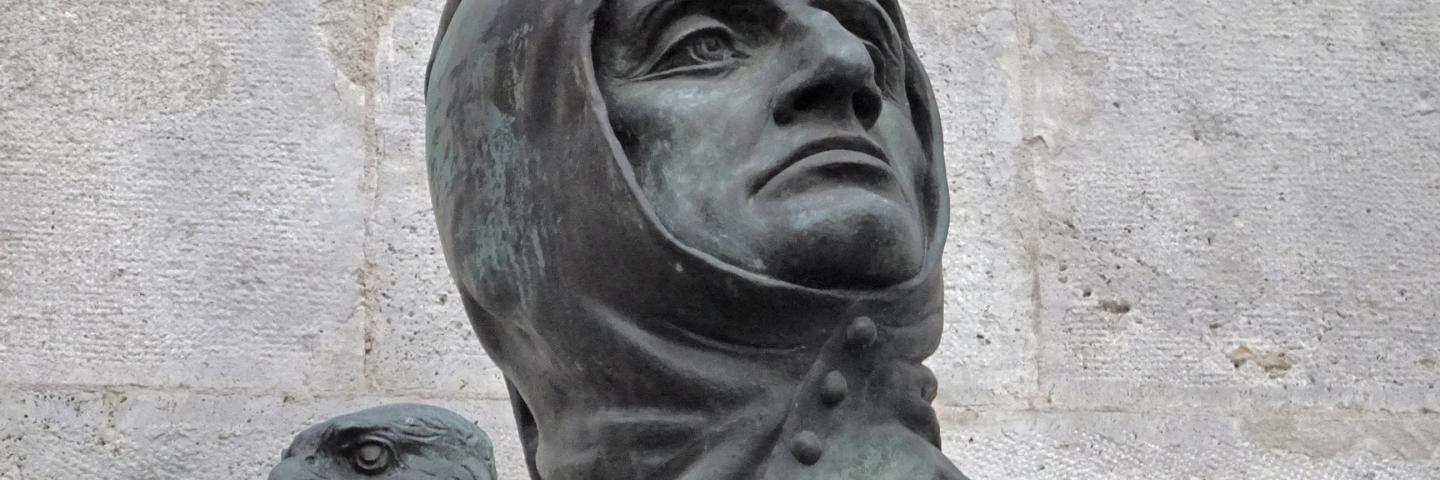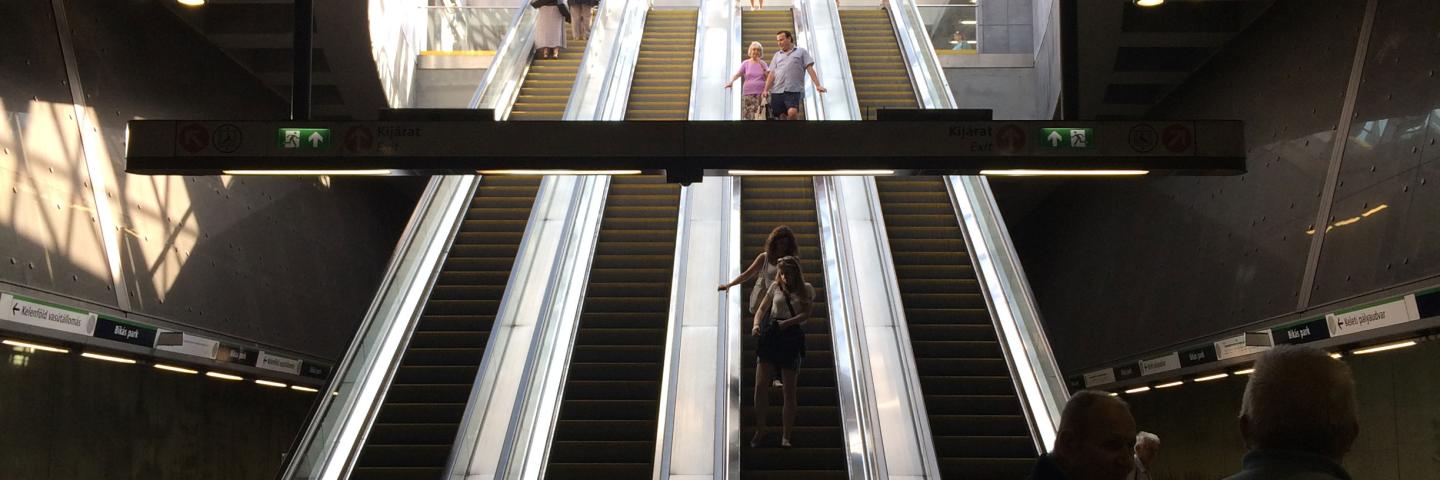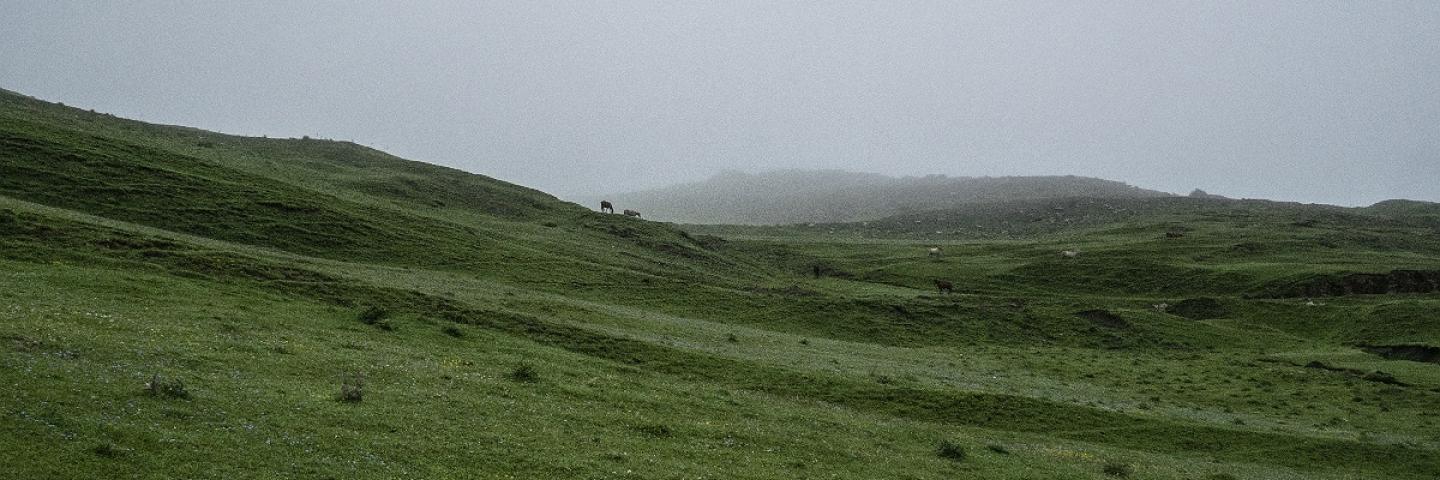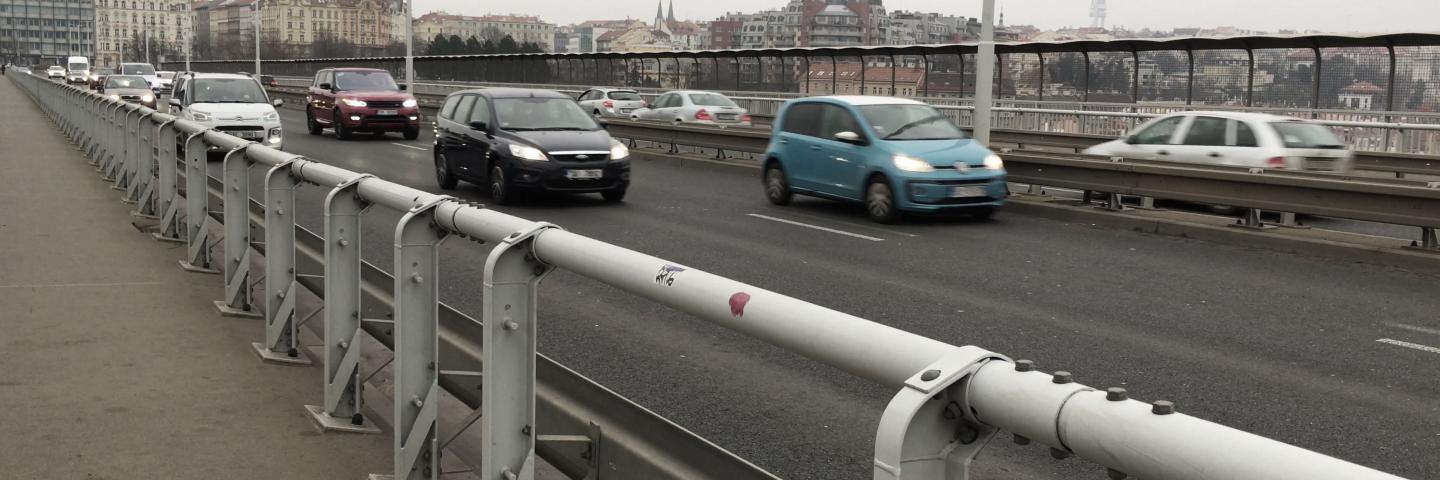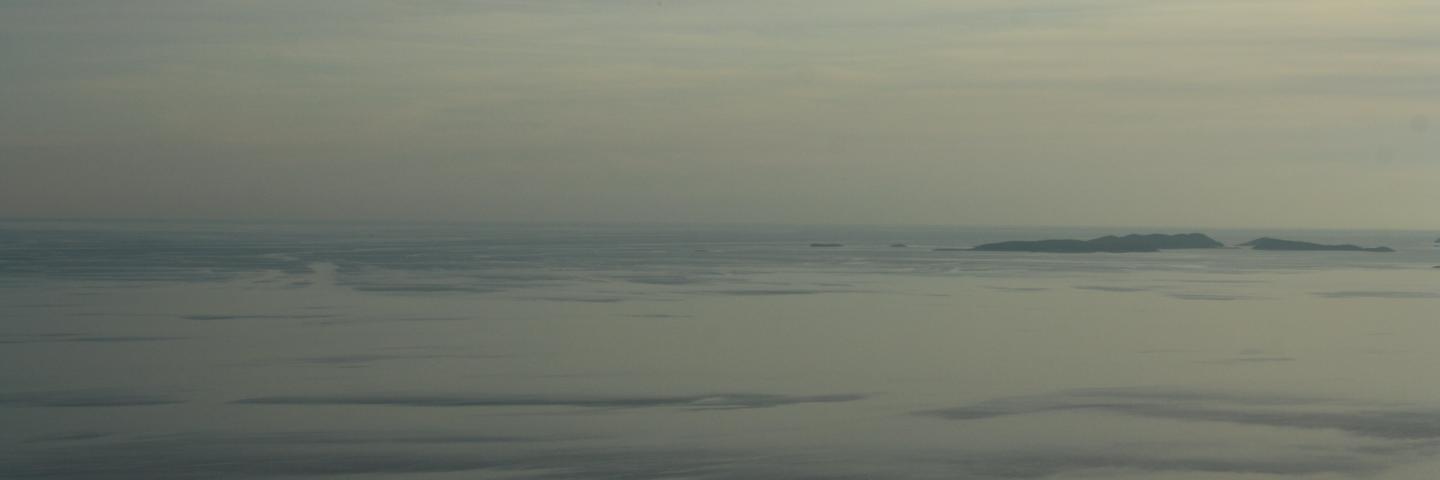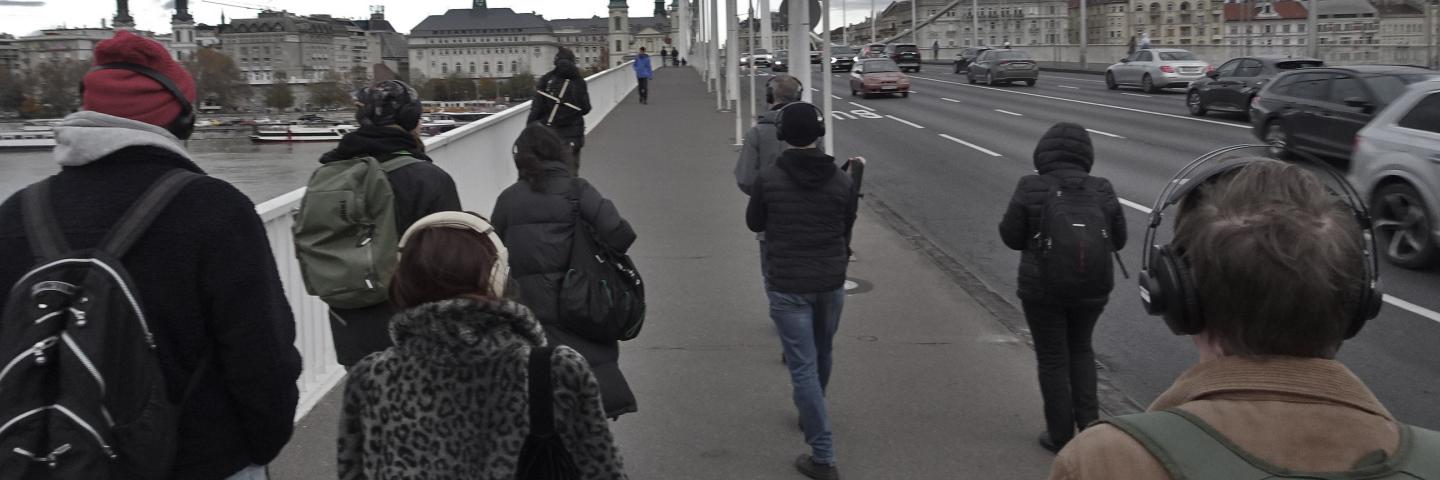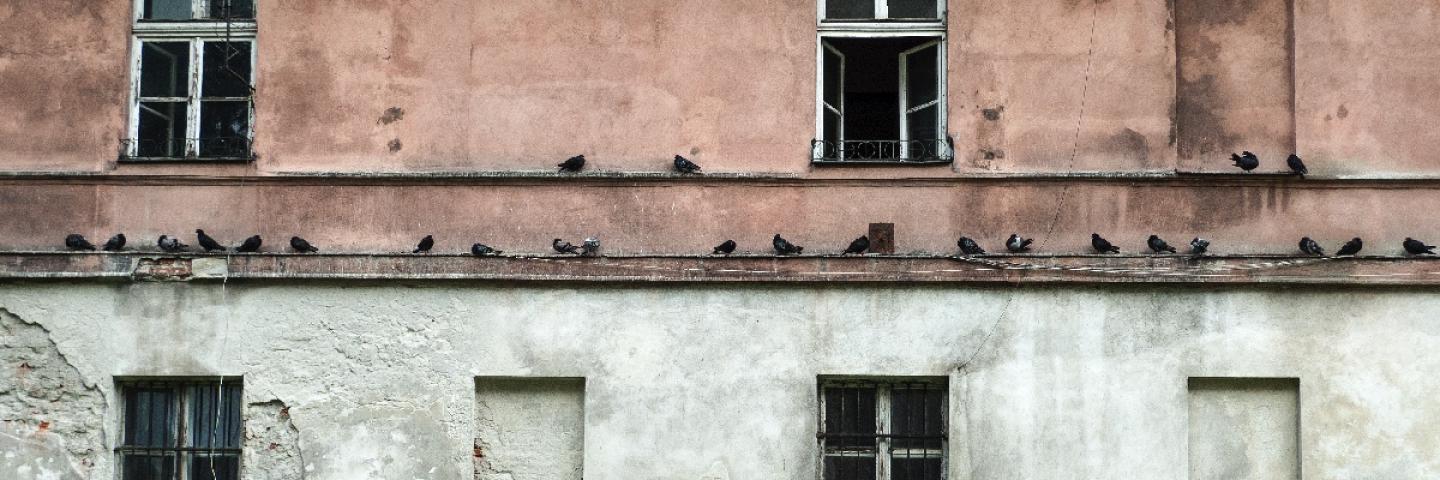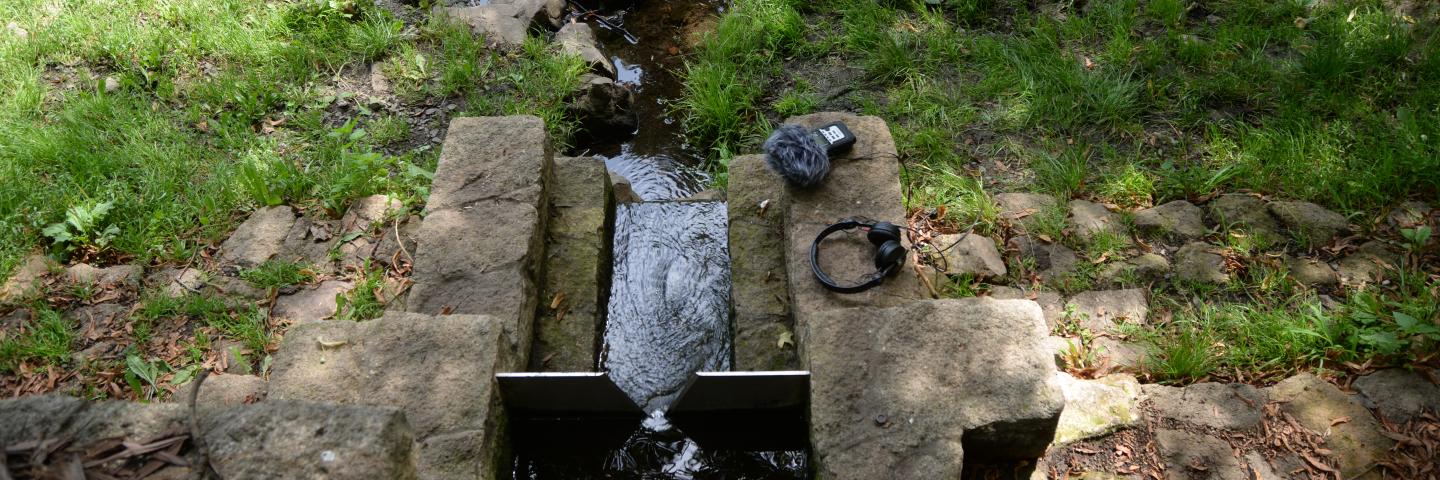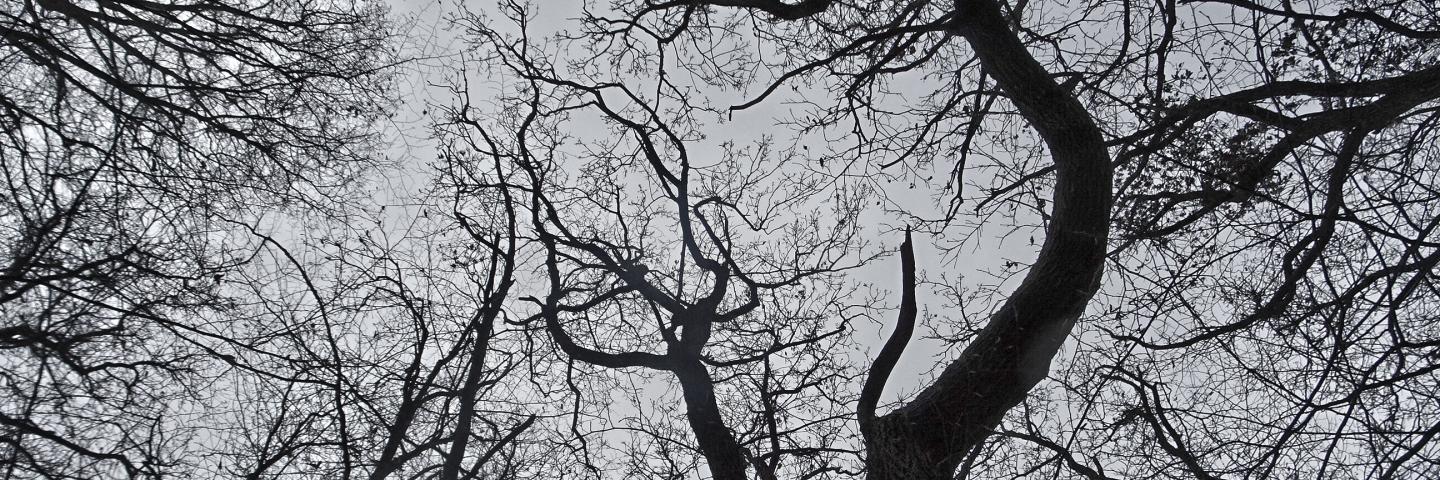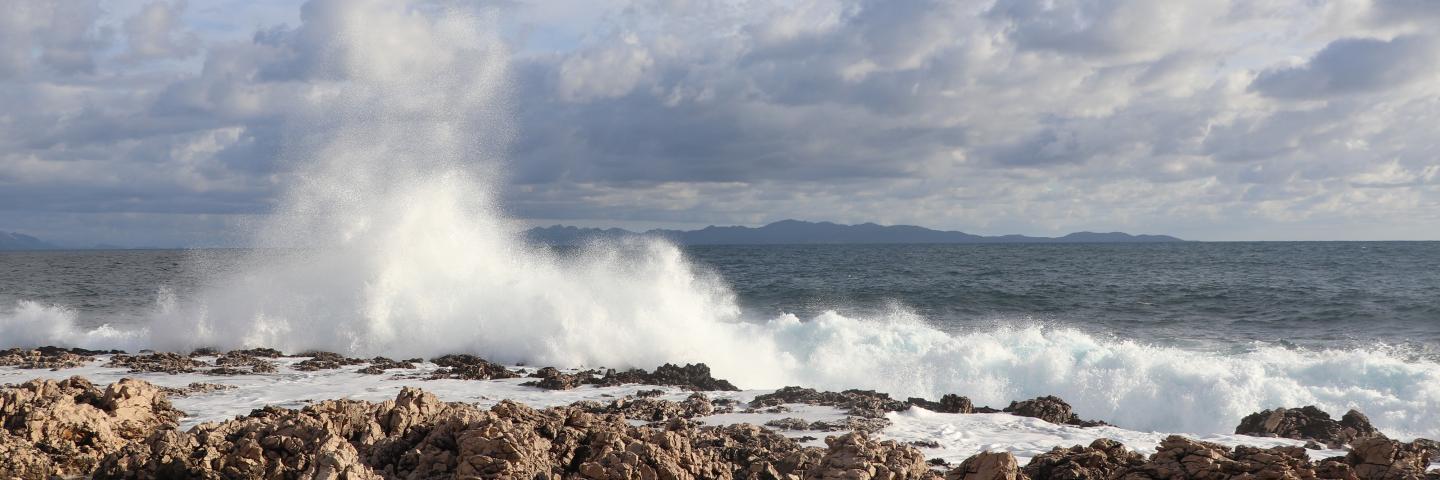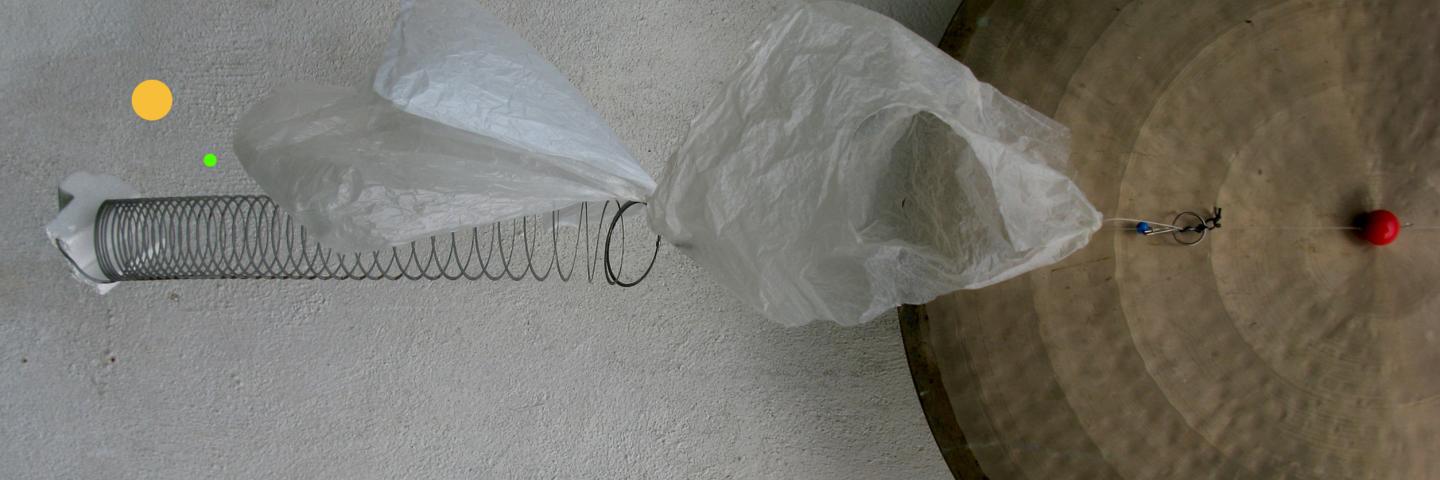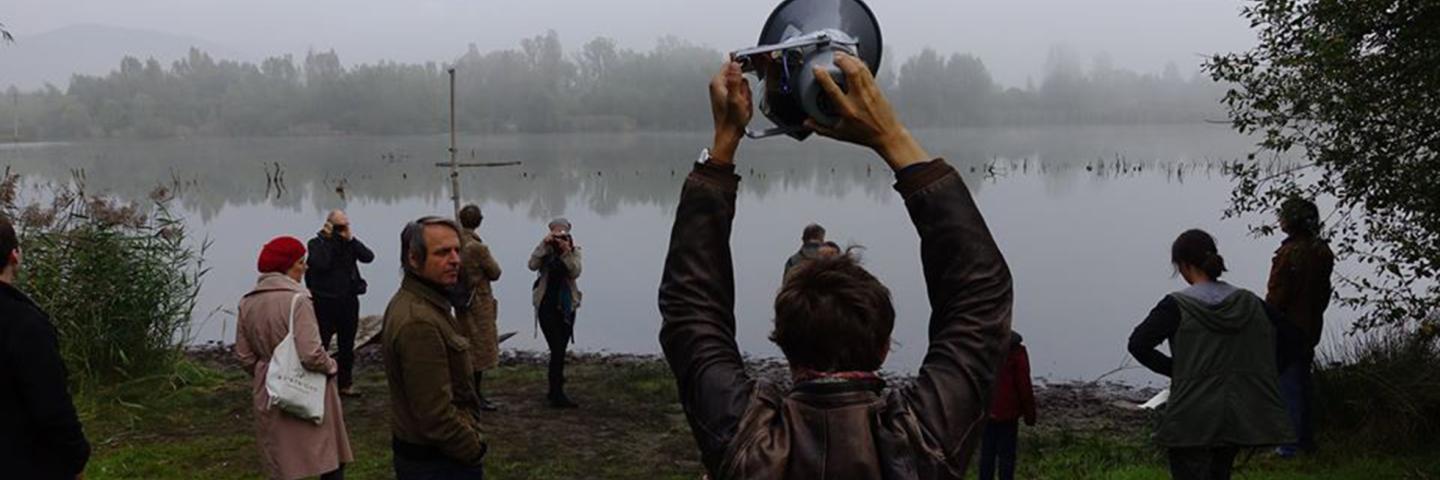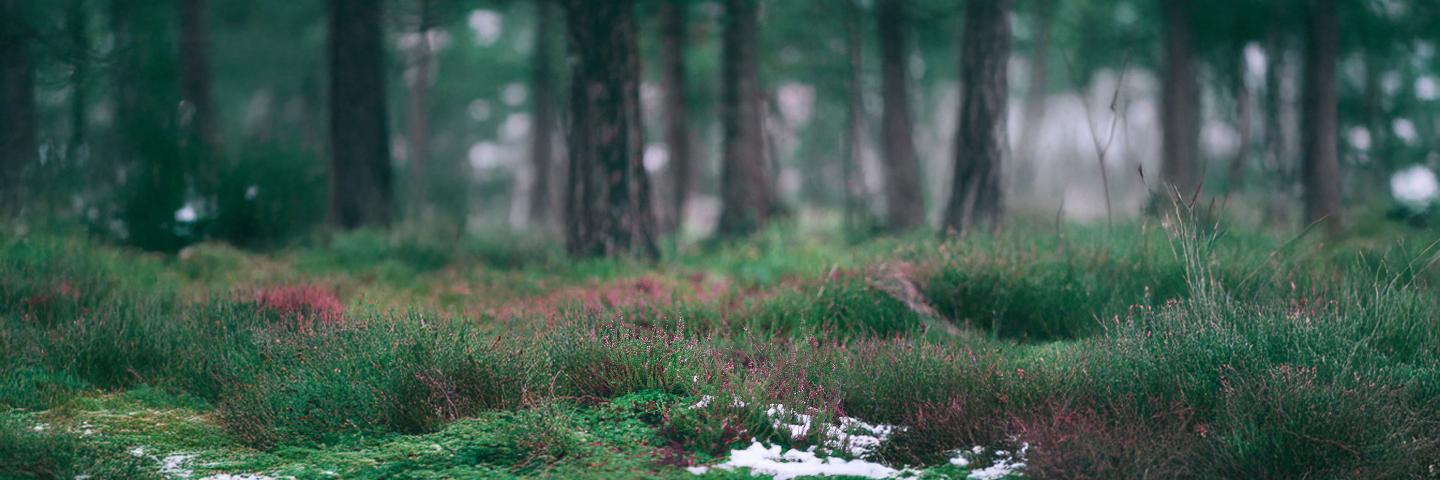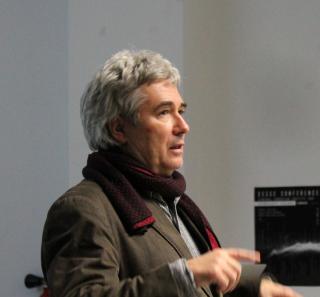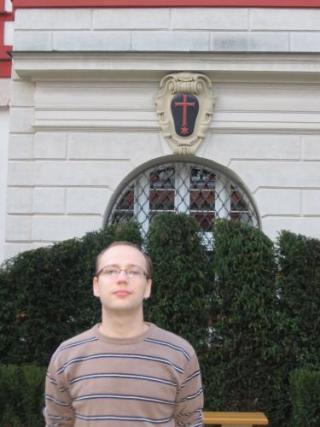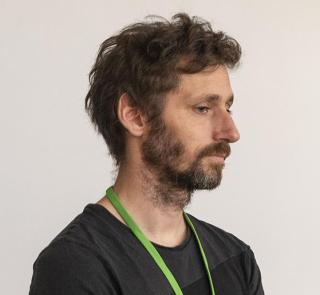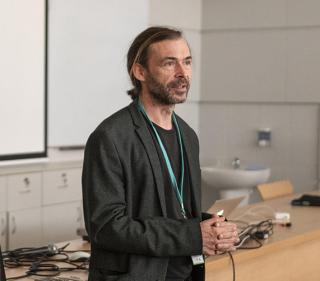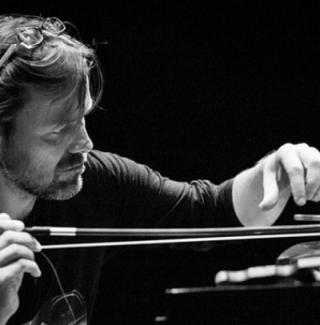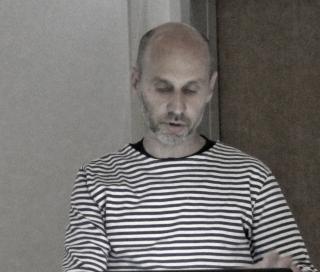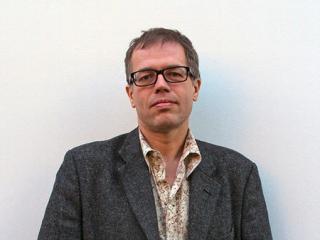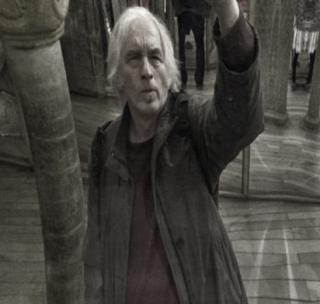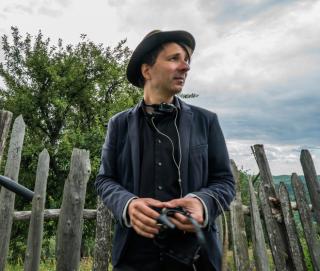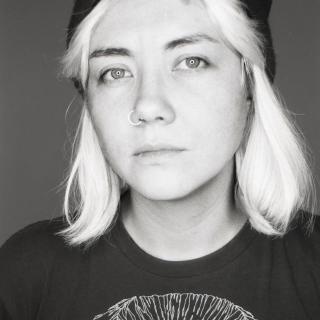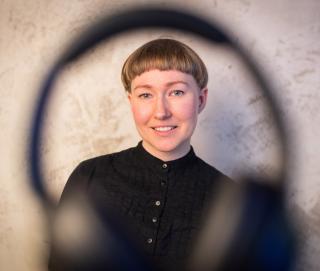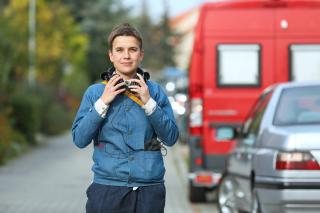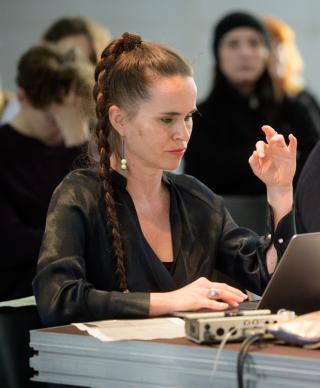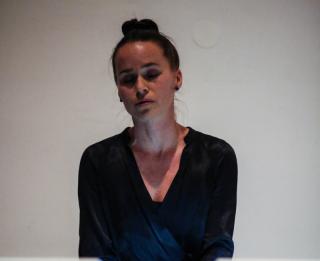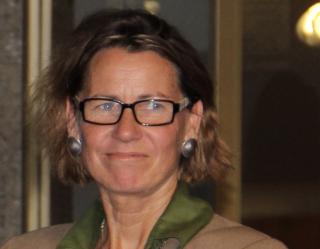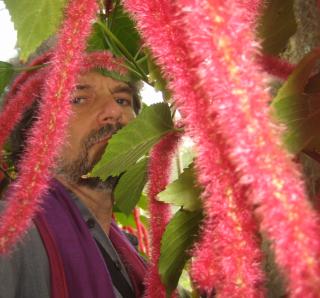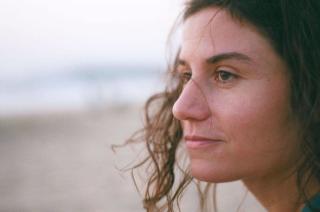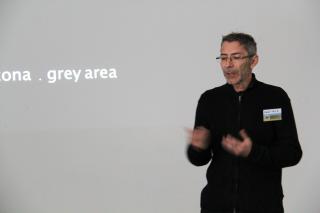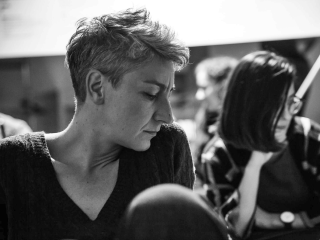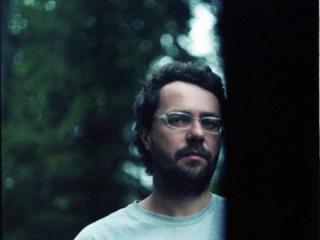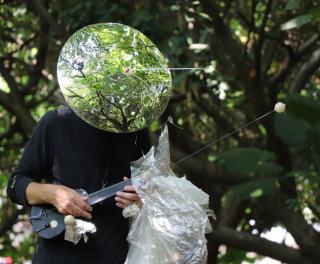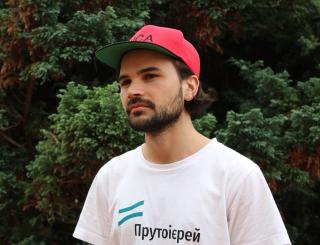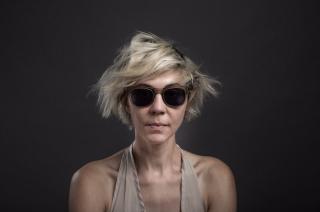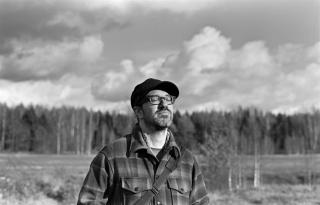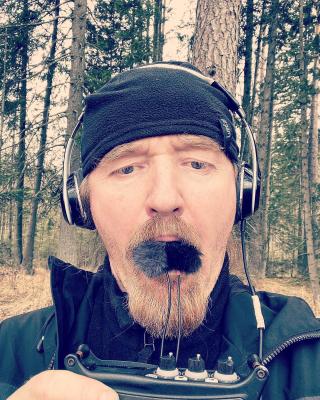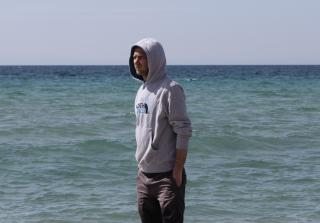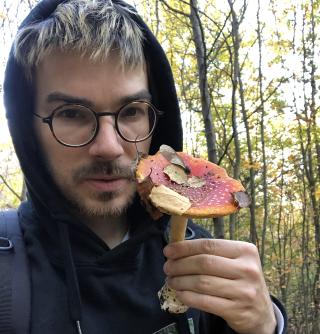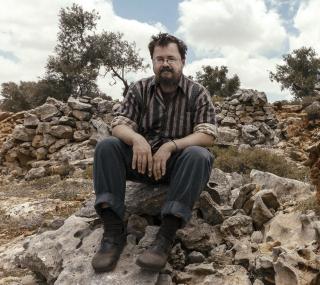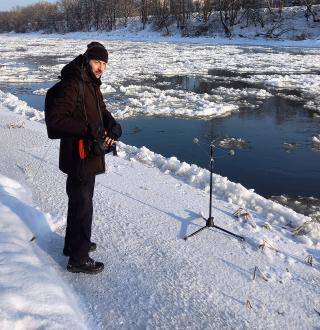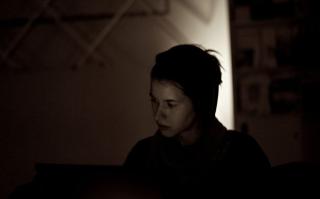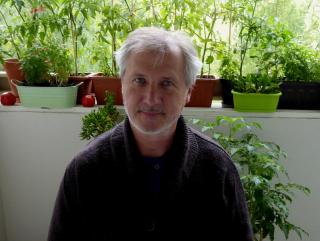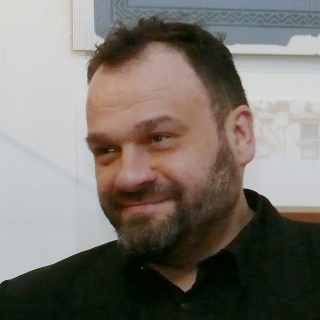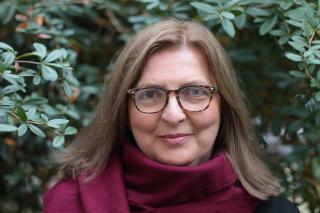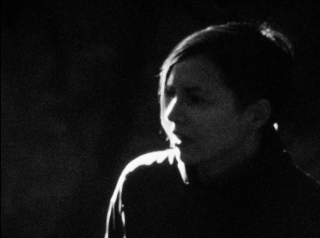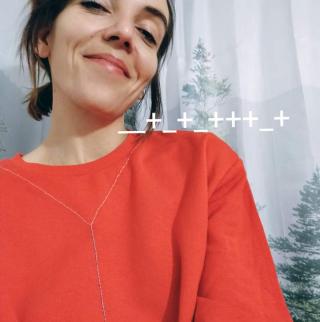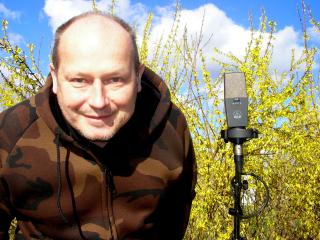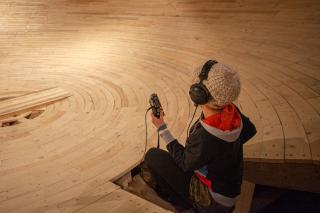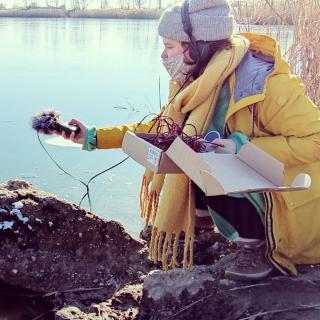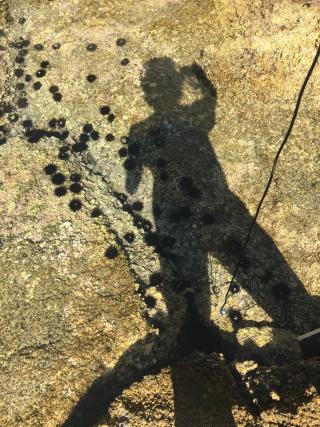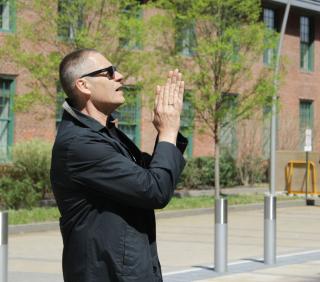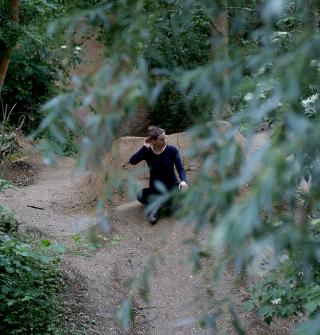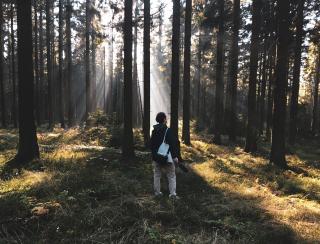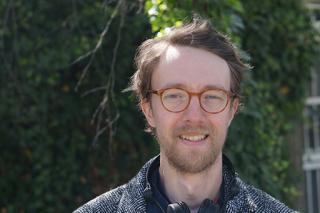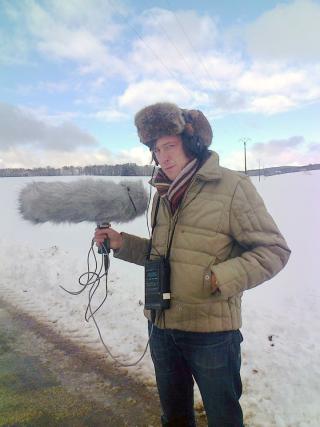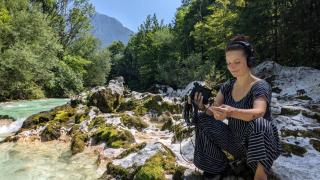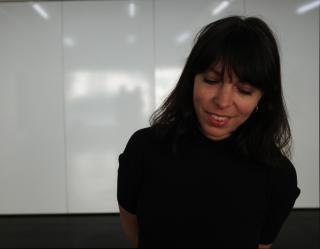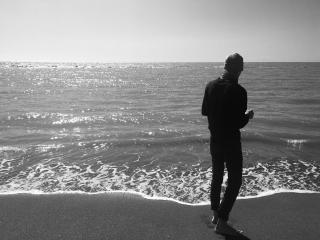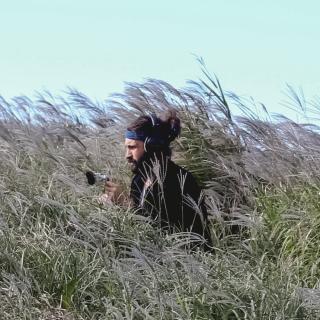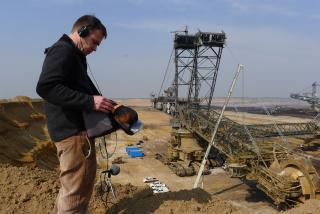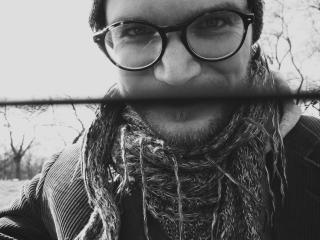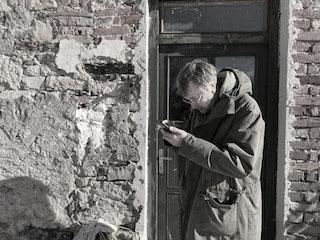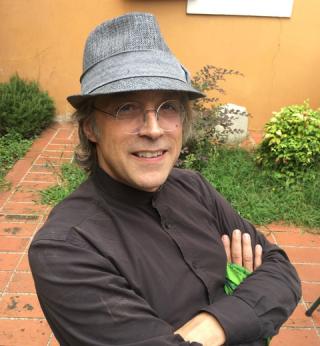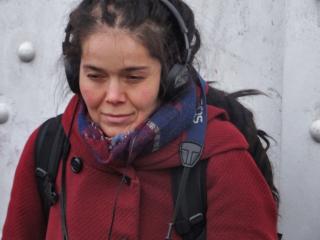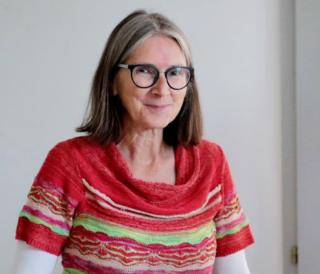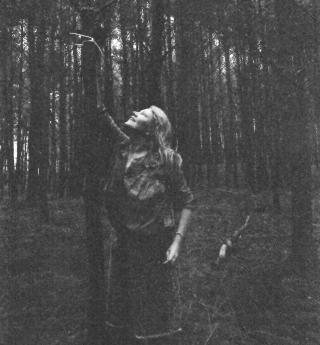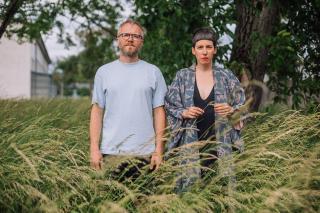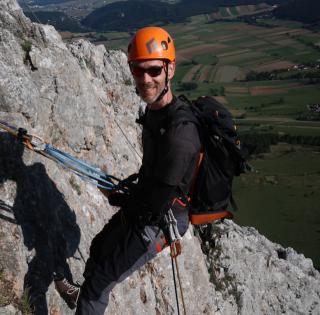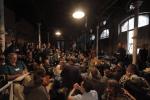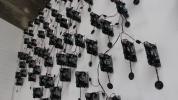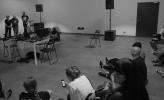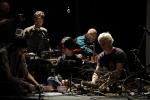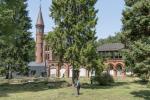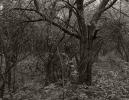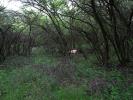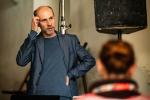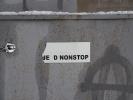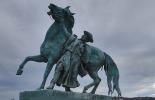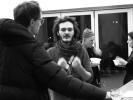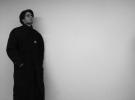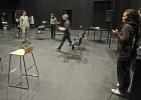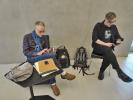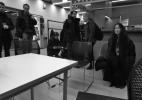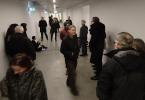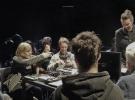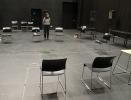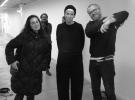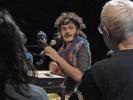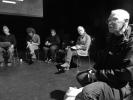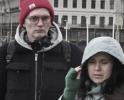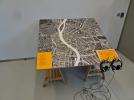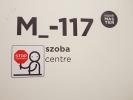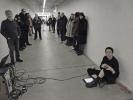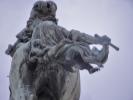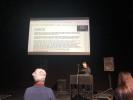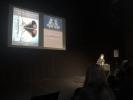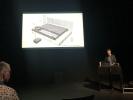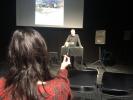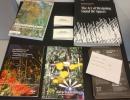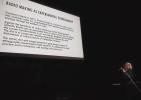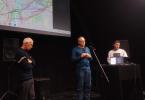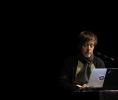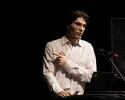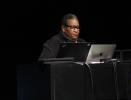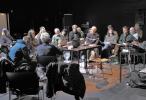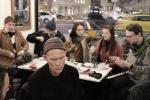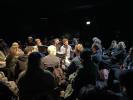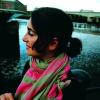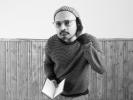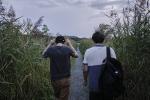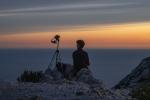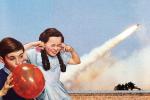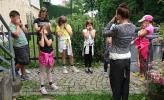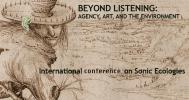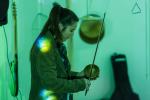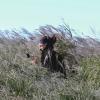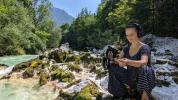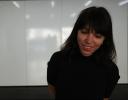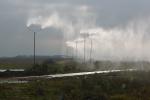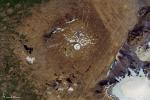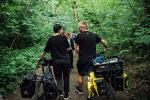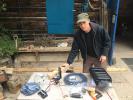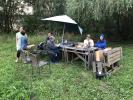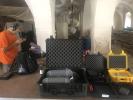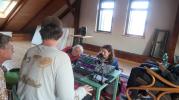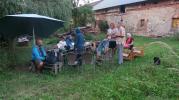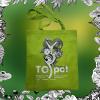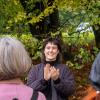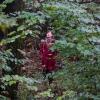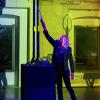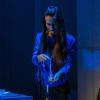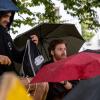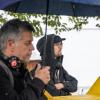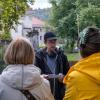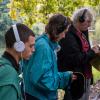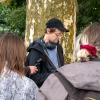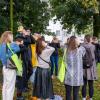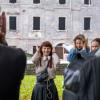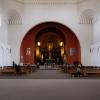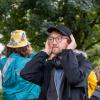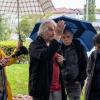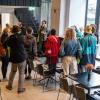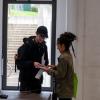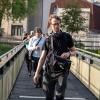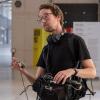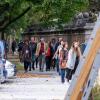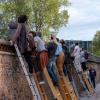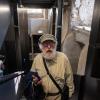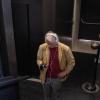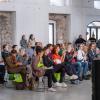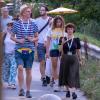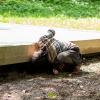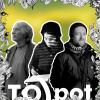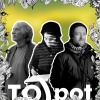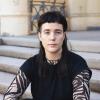SPATIAL sommer lab

We invite you to the second edition of the summer laboratory of spatial sound in North Bohemia! SPATIAL sommer lab take place from 5 to 29 July 2024 at the National House in Ústí nad Labem and at the cultural and residential centre Löblhof & Artgrund in Staňkovice.
Thanks to collaboration with OTTOsonics, Tangible Music Lab, ZiMMT, IEM Graz, spæs - Lab Berlin, FUD a FF UJEP, SVITAVA - transmedia art lab,
we can offer quality educational content, open network of experts and artists and bring a unique program to the participants.
The SPATIAL consists of:
♨ a three-week residency for artists selected through an open call
♨ a symposium on spatial sound open to the public
♨ ambisonic concert MELUSINES presenting the outcomes of the residency on 27.7.
𝙎𝙋𝘼𝙏𝙄𝘼𝙇 𝙨𝙘𝙝𝙚𝙙𝙪𝙡𝙚
7.7. Listening to place: Staňkovice / Magdaléna Manderlová (workshop, Staňkovice, registration required);
8.7. Crafting sound in space / Jakob Gille(workshop, National House);
9.7. Ambisonics impulse response measurement and auralization / Manu Mitterhuber (workshop, National House, registration required);
10.7. Sound in gardens / Jan Krtička (workshop, Staňkovice);
11.7. Nothing to hear / Jan Burian (workshop, National House, registration required);
12.7. Phenomenological topology of localization within sonic environments / Martin Nitsche (lecture, National House);
17.7. Grapes – 3D audio control. A tool for creative live spatializing / Felix Deufel (hands-on session,Staňkovice, registration required);
18.7. Mazetools to motion / Jakob Gruhl (hands-on session, Staňkovice, registration required);
19.7. Out of the box: sound installations in 4 landscapes / Jiří Y. Suchánek (lecture, National House);
20.7. Spatial audio instruments / Enrique Tomás (lecture, National house, registration required);
22.7. Multichannel performance with digital devices / Francesco Corvi & Daniele Fabris (hands-on session, National House);
23.7. DIY hardware quadraphonic mixing / Jan Hrubeš (hands-on session, National House);
24.7. Ontology of noise / Vít Pokorný (discussion, National House);
27.7. MELUSINES - Ambisonics concert.
Löblhof is located approximately 20 minutes by car from Ústí nad Labem, for public transport look for connections to the stop 'Staňkovice, rozcestí; district Litoměřice.
Participation in the lectures is free of charge, although registration is required for some.
You can register by sending an email with the subject line "SPATIAL registration" to
𝙥𝙝𝙤𝙣𝙤𝙣.𝙘𝙧𝙚𝙬@𝙜𝙢𝙖𝙞𝙡.𝙘𝙤𝙢, mentioning which workshops and lectures you wish to attend.
We thank the Cultural Center of the city of Ústí nad Labem and Löblhof & Artgrund for their support and cooperation. The project is financially supported by the Ústí Region, the Ministry of Culture of the Czech Republic, Arts and Theatre institute within the SoundCzech program. This work was created with the financial support of the European Union. The views expressed here can in no way be considered as the official position of the European Union.
more info:
Csaba Hajnóczy (1957) is a musician, composer, musicologist, and teacher at Moholy-Nagy University of Art and Design Budapest, living and working in Budapest. He was the main initiator and organizer of the CESSE – Conference #1. His recent artistic interest is field recording based composition and the use of spatial sound systems. Since 2013 he has given numerous talks and workshops in the field of acoustic ecology, including soundwalks, in Hungary, Poland, Belgium, Turkey. Csaba participated in the Architecture and Senses in Plasy, 2017 and in all following CENSE events.
I see it as a possibility to develop projects and interactions among individuals, associations and universities in the region to make it part of the worldwide flow of the ecology of sound and related art.
Sławomir Wieczorek PhD, graduated in cultural studies and musicology. He is a lecturer at the Institute of Musicology at the University of Wrocław. Member of the Soundscape Research Studio , editorial staff of the journals: Res Facta Nova and Polish Soundscape Journal . Author of the book On the musical front: socialist realist discourse on music in Poland 1948–1955 (Wrocław University Press 2014), co-editor of the book Sounds of War and Peace. Soundscapes of European Cities in 1945 (Peter Lang Verlag 2018). His interests focus on the history of twentieth-century music and soundscapes. Slawek was the main organizer of the third CENSE conference The Second Life of Recorded Sounds in Wroclaw October 2020.
Jan Krtička (1979) is an audiovisual artist and teacher. In his work, he often works with elements of aurality, concepts and topography. Krtička graduated in sculpture at the Faculty of Visual Arts at the Technical Univerisity in Brno. His doctoral thesis (from the Faculty of Art and Design at the University of Jan Evangelista Purkyně in Ústí nad Labem) focused on theories and critical aspects of documentation in art. Krtička is interested in the context of landscape and often engages with the contingency of nature and the determinancy of the human. He was together with Pavel Mrkus the main initiator and organizer of the conference Mundus Murmurans dedicated to Acoustic Ecology in Ústí nad Labem.
Csaba Hajnóczy (1963) je hudebník, skladatel, muzikolog a učitel na univerzitě Moholy Nagy v Budapešti, kde také žije a pracuje. Hlavní iniciátor a organizátor první konference CESSE. Věnuje se komponovaní s využitím terénních nahrávek a prostorovým zvukem. Od roku 2013 přednáší a vede dílny na téma akoustické ekologie, včetně zvukových procházek v Maďarsku, Polsku, Belgii, nebo v Turecku.
Vidím CENSE jako možnost rozvíjet projekty a interakce mezi jednotlivci, sdruženími a univerzitami v regionu, abychom se stali součástí celosvětového proudu zvukové ekologie a souvisejícího umění.
Jan Krtička (1979) je pedagog a umělec, ve své tvorbě používá často zvuk a klade důraz na koncept a prostorové uspořádání. Studoval sochařství na FaVU v Brně a v disertační práci, kterou obhájil na Fakultě umění a designu Univerzity Jana Evangelisty Purkyně v Ústí nad Labem se soustředil na teoreticko-kritickou polohu uměleckého díla a jeho dokumentace. Zajímá se o krajinu a dokumentaci lidských zásahů v krajině, využívá plánovanou náhodu a čerpá z mnohotvárností přírody ve spojení s lidským elementem. Byl hlavním koordinátorem konference v Ústí nad Labem.
Sławomir Wieczorek, PhD, působí jako pedagog na Institutu Musikologie při Vratislavské univerzitě. Je členem Soundscape Research Studia a editor časopisů: Res Facta Nova a Polish Soundscape Journal. Vydal knihu On the musical front: socialist realist discourse on music in Poland 1948–1955 (Wrocław University Press 2014), spolueditor knihy Sounds of War and Peace. Soundscapes of European Cities in 1945 (Peter Lang Verlag 2018). Zabývá se dějinami hudby dvacátého století a výzkumem zvukových krajin. Organizoval třetí CENSE konferenci The Second Life of Recorded Sounds ve Vratislavi v roce 2020.
Pavel Mrkus (1970) is an audiovisual artist who makes use of digital moving images and sound often in relation to specific space. He graduated from the Academy of Arts, Architecture and Design in Prague. His later study of Religious Studies at the Charles University in Prague together with experience of four years teaching position at Toyama City Institute of Glass Art in Japan lead him to unique mixture of cultural paradigms within his work. He participated in many group and solo shows around world. Together with Daniel Hanzlik they established Time-Based Media studio at Faculty of Art and Design at J. E. Purkyne University in Ústi nad Labem. Pavel together with Jan Krtička was the initiator and organizer of the second CENSE gathering — Murmurans Mundus conference in Ústí nad Labem, 2019 and the co-editor of the antology Sound and Enviroment.
Pavel Mrkus je umělec a pedagog absolvent pražské VŠUP. V roce 1991 absolvoval stáž na Polytechnic University, Stoke on Trent v Anglii a studoval na Evangelické teologické fakultě v Praze. je držitelem ocenění Honorable Mention a Silver prize. Vyučoval v Japonsku a USA, společně s Danielem Hanzlíkem založili ateliér Time-based media na UJEP v Ústí nad Labem. Spolu s Janem Krtičkou inicioval a organizoval druhou CENSE konferenci Mundus Murmurans v Ústí nad Labem.
Július Fujak (1966) is a scholar, a semiotician of music, experimental composer and multi-instrumentalist. Currently, he lectures at Department of Cultural Studies at the Faculty of Arts, Constantine the Philosopher in Nitra (since 2007). His compositions and intermedia projects were performed and broadcasted in many countries of Europe, USA, and China. He has organised for twenty years the international series and festivals of contemporary, unconventional music and intermedia art Hermes’ Ear in Nitra and PostmutArt.
Having just a joy & insight in sound: as unconventional composer/comproviser ocreating various musical-sonic situations (in field recordings including), and as semiotician/aesthetic scholar reflecting existentially semantic, cultural and socio-political dimensions of sonic environments.
Július Fujak je dramaturg medzinárodního cyklu současné nekonvenční hudby Hermovo ucho v Nitře, mezinárodního intermediálního festivalu PostmutArt (zvukobraz-gestotext) v Nitrianské galerii. Jako člen Kreatívneho tímu projektu Kandidatúry Mesta Nitra na titul Nitra EHMK 2013 byl autorem jeho ideového rámce, tzv. Multimosta kultúr(y) EHMK 2013. Člen Medzinárodní sémiotické společnosti (ISSS), člen poroty medzinárodní soutěže Českého rozhlasu Bohemia Prix 2010 – sekce Radio Art, Poděbrady, člen redakčního okruhu relacie Ex-tempore Rádia Devín. Od roku 2005 člen redakčního okruhu časopisu o současném umění a kultuře Vlna a od roku 2014 člen vědecké rady časopisu P-e-r-f-o-r-m-a-n-c-e (Esthétique de la performance et des arts du spectacle, Université Paris 1 Panthéon-Sorbonne).
Tomáš Šenkyřík (1972) is a musicologist with interest in field recordings, in acoustic ecology and in discovering musical structures in nature. He likes listening to nature without noise pollution, especially fragile and quiet sounds. From 1999-2008 he worked in the Museum of Romani culture as an ethnomusicologist. He is a member of association Skupina, an artist group interested in field-recordings, soundscape, oral & aural history, acoustic ecology. Tomáš is living and working in Židlochovice, a town south of Brno, Czech Republic. He is the founder of soundscape.cz. Tomáš participated in the Soundworms gathering in Plasy, in Cesse conference in Budapest, and in Mundus Murmurans conference in Ústí nad Labem.
Over the past five years, I have basically never had the chance to record the dawn chorus without aircraft pollution.Yet the very moment of awakening, when night merges with the beginning of the day, is fascinating.
Tomáš Šenkyřík (1972 v Přílepích) je hudebník a muzikolog se zájmem o terénní nahrávky, akustickou ekologii a objevování hudebních struktur zvukového prostředí. Fascinuje ho hledání hudebních struktur v dialogu mezi přírodními a mimopřírodními zvuky. Rád naslouchá přírodě bez hluku, zejména křehkým a tichým zvukům. V letech 1999–2008 pracoval v Muzeu romské kultury jako etnomuzikolog, nyní pracuje a žije v Židlochovicích. Je členem uměleckého kolektivu pro terénní nahrávky, zvuky, orální a sluchovou historii a akustickou ekologii Skupina. V roce 2018 založil portál o zvukové krajině jižní Moravy. Zúčastnil se konference CEESE v Budapešti a všech dalších setkání.
Za posledních pět let se mi v podstatě nepodařilo natočit začátek zpěvů svítání bez leteckého znečištění. Přitom právě moment probouzení, kdy se noc protne se začátkem dne, je fascinující.
Boris Klepal (1966) is a journalist and music writer, interested in music and in sound itself. Klepal is a regular correspondent of a music journal HIS Voice, Economic Newspaper (Hospodářské noviny) and portal Aktualne.cz. Since January 2020 he works as an editor in chief of musicological revue Opus musicum. He is open to add a new topics to Opus musicum and one of them is an acoustic ecology (or soundscape studies). Visit the Soundcloud link for his field recordings. Also link to his radio show about sounds of Brno and their influence on Leoš Janáček (created with Miloš Štědroň).
If you want to know the state of the world, you should listen carefully. The sound delivers the most fleeting and accurate news.
Miloš Vojtěchovský (1955) je kurátor, historik umění, audiovizuální umělec, kritik, pedagog, vydavatel experimentální hudby. Kurátor NG v Praze, dramaturg výstavního prostoru Školská 28. S Peterem Cusackem založil projekt sonicity.cz věnovaný psychogeografii a zvukovým krajinám Prahy. Kurátor české sekce projektu Soundexchange. Spolupracoval na přípravě a programu symposia a festivalu vs. Interpretation. Iniciátor projektu Na pomezí samoty. Další projekty zahrnují například: Deep Space Gateway, Soundworms Ecology Gathering, 2017, a Architecture and the senses, 2018.
Myslí si, že naší hlavní povinností je pokusit se teď alespoň zmírnit devastaci planety a životního prostoru, protože za to neseme - jako jednotlivci i jako živočišný druh - zodpovědnost. Když už se asi nepodaří změnit ekonomický systém, alespoň životní styl.
Miloš Vojtěchovský (1955) is a curator, art historian, and audiovisual artist. In 1992 he founded the Hermit Foundation, later the Center for Metamedia in Plasy Monastery. Together with Peter Cusack started up the ongoing project Favourite Sounds of Prague sonicity.cz. He curated the Czech section in the international networking project Soundexchange and co-curated the symposium and festival vs. Interpretation held in Prague, 2016 by the Agosto Foundation and the Frontiers of Solitude project - 2015 - 2017. Other project include: Deep Space Gateway, Soundworms Ecology Gathering, 2017, and Architecture and the senses, 2018. Participated in symposia in Budapest, Ústí nad Labem and Ljublana.
He thinks that we are obliged to try almost everything, to affect the current economical system and to challenge the destruction of environment, we are - as the human race and as individuals - responsible for. At least we could at least try to change our lifestyle?
Lloyd Dunn or ( nula.cc ) is a founding member of the intermedia and experimental group the Tape-beatles, and editor and publisher of several small-press zines, such as PhotoStatic and Retrofuturism. Beginning in the 1980s, he has worked in a range of media, including 16mm film, video, audio, press, and works for the web. He studied linguistics and film and received an M.F.A. in art from the University of Iowa. Dunn is the author of the filecast project nula.cc, comprising hours of sound works, and hundreds of photographs, as well as texts, which often reflect his frequent travels. Individual ‘filecasts’ consist of assemblages of sound, images and words which are freely available for download. Since 2001, Dunn has lived and worked in Prague.
Lloyd Dunn (narozen 1957 v Iowě) je zakládajícím členem intermediální a experimentální skupiny Tape-beatles a zakladatelem, vydavatelem a redaktorem několika nízkonákladových časopisů, jako například PhotoStatic a Retrofuturism. Od začátku 80. let pracuje s řadou médií, včetně 16mm filmu, videa, audia, tisku a webových aplikací. Studoval lingvistiku, magisterské studium zakončil na katedře filmu, fotografie a intermédií na University of Iowa. Lloyd Dunn je autor filecastového projektu nula.cc, obsahujícího desítky hodin zvukového, stovky obrazového a textového materiálu, který vznikl většinou během jeho častých cest. Jednotlivé soubory jsou asambláží zvuků, obrazů a slov a autor je nabízí volně ke stažení, případně k dalším úpravám. Od roku 2001 žije a pracuje v Praze.
Michal Kindernay (1978) is an intermedia artist, curator and performer, working and living in Prague. His audio-visual installations interconnect visual art, cinema, technology and science, reflecting ecological issues through various technological approaches in relation to nature environment. His works include audiovisual performances, interactive installations or experimental documentary or music compositions. He is one of the founders of non profit organization yo-yo and the initiator or RurArtMap project. He was one of the curators of Školská28 gallery in Prague. He works for the Agosto Foundation, teaches in Prague College and was teaching in Centre of Audiovisual Studies in Film and TV School of Academy of Performing Arts. As an organizer or artist he was involved in many international projects and participated in all CENSE conferences since 2018.
Michal Kindernay je intermediální umělec, performer a kurátor. Jeho audiovizuální instalace propojují oblasti a nástroje umění, technologie a vědy. Často se dotýká témat ekologie a skrze aplikování technologických přístupů ve vztahu k přírodě reflektuje problematiku environmentálních otázek. Jeho práce zahrnují videoperformance a interaktivní instalace, intermediální a dokumentární projekty a hudební zvukové kompozice. Je spoluzakladatelem umělecké organizace yo-yo, iniciátorem projektu RurArtmap, byl členem kolektivu galerie Školská 28 v Praze. Jako pedagog působí v rámci nového magisterského programu na Prague College a externě v Centru audiovizuálních studií FAMU v Praze.
Polina Khatsenka is a new media artist from Belarus. Dominant part of her artworks is based on a wide variety of aspects of sound, such as sonic environment, field-recordings, electroacoustic music and spatial sound. Living and studying arts in Usti nad Labem, she fostered the knowledge in the field of multichannel audio formats and electronic music during a study exchange at Media and Design Faculties at University of Applied Sciences in Düsseldorf in 2018. Polina is currently getting her Master’s degree at Faculty of Art and Design, Time-based media studio, Jan Evangelista Purkyně University, Czech Republic.
Polina Khatsenka je umělkyně z Běloruska pracující s novými médii. Důležitá součást jejích děl vychází s různých aspektů zvuku jako zvukové prostředí, terénní nahrávky, elektroakustická hudba a prostorový zvuk. Žije a studuje v Ustí nad Labem, kde se v ateliéru Time Based Arts při FUD UJEP zaměřuje na problematiku multikanálových instalací. Studovala na stážích na Media and Design Faculty Univerzity aplikovaných věd v Düsseldorfu a na Akademii umění a designu v Linci.
Iva Polanecká (1990) je audiovizuální umělkyně, která se zajímá o neviditelné oblasti světa. Její vztah k přírodě, který se snaží divákovi sdělit, se zrcadlí ve vnitřních a niterných pocitech člověka. Abstrahuje danou skutečnost, avšak pořád zanechává prostor pro imaginaci lidské mysli. Je absolventkou ateliéru Time-Based Media na Fakultu umění a designu v Ústí nad Labem, kde se také dva roky podílela na programu a chodu Domu umění Ústí nad Labem Fakulty umění a designu UJEP. Působí spolu s Martinem Markem a Polinou Khatsenko v ústeckém kreativním kolektivu Phonon, žije a pracuje v Praze. Zúčastnila se konference CEESE a spoluorganiace konference Mundus Murmurans.
Ráda nalouchám přírodě, zvukem a časem který jsem prožila poslechem jsem objevila nejrůznější prostředí.
Iva Polanecká (1990) is an artist from Czech Republic, based in Prague and the Giant Mountains (Krkonoše), Czech Republic. Iva graduated from Interactive Media and Time-base media at the Faculty of Art and Design, J. E. Purkyně University, Ústí nad Labem where she collaborated as well in the program of exhibitions of the House of Art. Iva is part of Phonon, an artist group interested in soundscape, deep listening and sonic dreaming (with Polina Khatsenko and Martin Marek). Her artistic practice is engaged with the context of environmental change, perception and interpretation of the sound environment grounded in listening practice and field recordings. She is inspired and interested in the sonic environment, acoustic ecology and deep listening. Her works often takes form as spatial site-specific installations, performance or work with objects and concepts in the installation and sound compositions which are composed of field recordings and music. Iva participated in CESSE conference in Budapest, 2018 and co-organized the 2nd CENSE conference Mundus Murmurans in Ústí nad Labem.
I like listening to nature, through sound and time spent listening I discovered a variety of environments.
Brane Zorman (1962) je skladatel, zvukový a rozhlasový umělec, kurátor a producent, žije a pracuje v Ljublani. Ve své práci zkoumá možnosti zpracování, prezentace, vnímání, porozumění, polohování, manipulace se zvukem a nové koncepce vztahů mezi zvukem a prostorem. Využívá analogové i digitální technologie a techniky, jeho práce se pohybuje mezi oblastí hudby, multimédií, prostoru a obrazu. Použivá sofistikované i jednoduché nástroje, strategie, metody, dynamické a interaktivní modely interpretace, zvukové, elektronické a audiosochy. Společně s Irenou Pivko vede Institut pro sučasné umění CONA, zřizující například radioCona, Frequency Flux projekty, atd. Působí také jako kurátor série ZVO.ČI.TI (so.und.ing), zvukových výstav, je vydavatel autorských knih, atd.
Brane Zorman (1962) is composer, intermedia artist, sound man-i-pul-ator, producer living in Ljublana. Has composed music for theatre, dance, multimedia and newmedia sound pieces, as well as released several soundtrack CDs and EPs for various labels. He composes music for film, TV and radio commercials. His achievements include the first DTS surround encoded soundtrack for a theatre performance in Slovenia, the first DTS surround CD release in Slovenia. He has an interest in special sound design, effects and sound sculptures – soundscapes, as well as live surround sound projects and events in various public spaces. He collaborates with different intermedia artists as Irena Pivka with her he founded the CONA - Institute for contemporary art processing. Brane and Irena participated in the CESSE and Mundus Murmurans conferences.
Šárka Zahálková (1982) is a curator, cultural manager and artist, living and working in Pardubice. She is interested in the topic of art in relation to public space, whether in physical or figurative terms. Her art range includes drawing, time-based media, installations, sound art and community oriented participative projects. She is a co-founder and member of the Offcity Association and since 2018 she has been the Program Director of the Pardubice City Gallery. She studies PhD program — Visual Arts — on the Academy of Fine Arts in Prague and is the Fulbright – Masaryk Alumna (New York, USA). Šárka participated the the Mundus Murmurans conference in Ústí nad Labem.
Conscious listening to me is a path to higher sensitivity.
Šárka Zahálková(1982) je kurátorka, kulturní manažerka a výtvarná umělkyně, zabývá se tématy souvisejícími s uměním jako nástrojem společenské změny a uměním ve veřejném prostoru. Spoluzaložila a vede projekt Offcity z. s., který je součástí nadregionálního i mezinárodního diskursu v kontextu práce s veřejným prostorem. Absolvovala studia galerijního managementu a výtvarných umění (animovaná tvorba), jednoroční program „Commissioning and Curating Contemporary Public Art“ na Valand Academy, University of Gothenburg, Fulbright-Masarykovo stipendium pro neziskový sektor v NYC, USA a několik dalších zahraničních tvůrčích i kurátorských stipendií. Od roku 2019 je doktorandka Akademie výtvarných umění v Praze. Je členkou Spolku Skutek.
Naslouchání je pro mě cestou k vyšší citlivosti.
Petra Kapš alias OR poiesis (1975) weaves her work among the arts of sound, radio, chrono-spatial poetry, poetic performance, books and reflection. Aside from the ethereal features of sound, she focuses on the physical presence of the body. She extends the word, her core medium, with sonic spheres of sonorous poetry. Kapš is interested in aural memory and the deep time of the body. Incorporating an (a)syntemporal presence through the digital sphere, she researches the possibilities of intimate radio and is concerned with the void ear of the internet listener. Her sound/radio/book works are located solitudes. Petra participated in the Soundworms gathering, Architecture and Senses, in the Cesse, conference in Budapest, and Second life of Recorded Sounds conference in Wroclaw 2020, Beyond Listening symposium in Budapest 2023 and Opot festival in Ljublana, 2024.
My main axis spins around modalities of silence and the aural / vibrational / resonant conditions of the planet and its matter / substances. We have bodies and with them the most magnificent sensory organism - the only one we truly possess but severely neglect to rely on the processed data. My concerns are intertwined with the anthropogenic noise, with its virtual-augmented aspects, and the concrete ones, generated by the infrastructure that is deeply embracing the crust of the earth. Regarding global warming and human narcissistic pathological behaviour / actions I would like to promote attuned listening. In my artistic practice I try to develop ways to attune with entities that surround me.
Petra Kapš alias OR poiesis (1975, Slovinsko) je zvuková umělkyně a básnířka, žije v Mariboru. Kombinuje umění zvuku, rozhlasu, chrono-prostorové poezie, poetické performance, textu. Vedle pomíjivosti zvuku se zaměřuje na tělesnost. Jejím hlavním výrazovým prostředkem je slovo, rozšířené do oblasti sonické poezie. Zajímá se o sluchovou paměť a o hluboký, fyzický čas. Užíváním (a)synchronické přítomnosti v digitální sféře rozpracovává koncept intimního rozhlasu. Zabývá se také vyprázdněností sluchu internetového posluchače. Její zvuky/rozhlas/knihy a díla jsou lokalizované momenty samoty. Petra se zúčastnila setkání soundworms, architektura a smysly, CESSE, a Second Life of Recorded Sounds ve Vratislavy.
Můj hlavní zájem se dotýká osy modalit ticha a zvukových / vibračních / rezonančních vlastností planety a její hmoty / látek. Tělesnost nám umožňuje používat smyslový organismus - to jediné, co skutečně máme, a čemu přitom navěnujeme pozornost. Bojím se antropogenního hluku, pronikajícího z infrastruktury, která hluboko prostoupila povrch planety, jeho virtuálních i hmotných aspektů. Pokud jde o globální oteplování, nebo o narcistické patologické chování / jednání lidstva, podporuji prožitek soustředěného naslouchání. Svým uměním se snažím dosáhnout stavu, ve kterém bych s entitami, které mě obklopují byla v rovnováze.
Manja Ristić (1979) graduated at the Belgrade Academy of Music, then awarded at the Royal College of Music, London. As a classical solo and chamber musician as well as a composer and an improvising musician Manja performed all across Europe and in the US, involving collaborations with established conductors and performers, multimedia artists, visual artists, poets, theatre and movie directors. Manja’s sound related research beside contemporary performance in the field of instrumental electro–acoustics, is focused on interdisciplinary approach to a sound art, field recording as well as experimental radio arts. Manja is founder of the Association of Multimedia Artists Auropolis, that by her guidance developed distinctive number of cultural events, international projects, cultural conferences and educational modules in the fields of scene and multimedia arts. Published poet and a sound theory researcher, she also signs number of theatre and movie productions as author, composer and performer. Manja participated at the founding CESSE Conference in Budapest, 2018. Works and lives on the coast of island of Korčula, Croatia and is member of the organinisation of Grey Zone / Siva zona.
Manja Ristič (1979) je autorka skladatelka a performerka divadelních a filmových produkcí, publikuje poezii a působí jako výzkumnice na poli zvukové teorie. V Bělehradě absolvovala studium na Hudební akademii, studovala na Royal College of Music v Londýně. Jako interpretka, skladatelka a improvizátorka vystupovala v Evropě a v USA, spolupracovala s dirigenty a hudebníky, multimediálními a vizuálními umělci, básníky, divadelními a filmovými režiséry. Manja se vedle instrumentální elektroakustické hudby zaměřuje na výzkum související se zvukem a na interdisciplinární přístupy ke zvukovému umění, na terénní nahrávky a na experimentální rozhlasovou tvorbu. V roce 2004 založila Asociaci multimediálních umělců Auropolis, kde od té doby vznikla řada kulturních akcí, mezinárodních projektů, kulturních konferencí a vzdělávacích dílen scénického a multimediálního umění. Pracuje a žije na chorvatském ostrově Korčula, kde spolupracuje s projektem Siva zona.
Barbara Benish (1958) is an artist, curator, writer and farmer. She moved from Los Angeles to Prague as a Fulbright scholar and stayed. Her artwork has been shown in hundreds of international exhibitions in Europe and the US. Benish is Founding Director of Art Dialogue, a Czech NGO which runs ArtMill, an eco-art center in the Czech countryside. She is a Fellow at the Social Practice Arts Research Center at University of California Santa Cruz, and an Advisor to the UN Safe Planet Campaign.
Opening this aural sense, as well as oral, tactile, and olfactory, is part of the physical experience that exposes our bodies to pain and pleasure, reconnecting them to the environment around us. In this way the traditional optical engagement of the visual arts is expanded to embrace a more vibrational, meta-physical experience. Perception is directly connected to political and social activity, to which my work is deeply committed as we navigate the end of the Anthropocene, and seek to repair human-induced violence against the Earth.
Barbara Benish (1958) je umělkyně, kurátorka, spisovatelka a farmářka. Původně z Los Angeles, začátkem 90let přesídlila do Prahy. Vystavovala na mnoha mezinárodních výstavách a její práce jsou součástí stálých sbírek. Benish je zakládající ředitelkou české nevládní organizace Art Dialogue (2004), v centru ArtMill, na českém venkově se zaměřuje na udržitelné umění, pořádá výstavy, workshopy a rezidenční programy. Byla poradkyně pro umění, vzdělávání a osvětové kampaně programu OSN Safe Planet, vystupovala na řadě konferencí a podílela se na legislativě problematiky znečištění prostředí plasty a transformačního vzdělávání. Benish se zabývá propojením současného umění a zemědělství.
Percepce je součástí politického a sociálního rámce, kterému se ve své práci věnuji a otevřít se smyslu sluchu, řeči, hmatu a čichu, je zkušenost, která vystavuje naše těla bolesti i potěšení a propojuje nás s okolím. Dnes se blížíme závěru epochy antropocénu a snažíme se násilí člověka páchané na Zemi napravit.
Jeff Gburek (1963) is a sound artist, composer, instrument builder, field recordist & blogger, based in Poland. As a guitarist born in the USA, after studying gamelan music in Bali and Java, explored improvisation as percussionist, and built his own hybrid world music free noise junkyard percussion set with oscillators and shortwave radios. Over the course of the last few years, the works have been focused on soundscapes, horspiel, spoken-word, text, voice experiments, themes of ecology and climate change. He has had artistic residencies in Berlin, Lyon, Amsterdam (STEIM), Darmstadt, Brussels. Until the recent pandemic he's been a frequent traveler of Eastern Europe and the Balkans recording folk music and sonospheres, which he publishes primarily on his netlabel Akashic Records. Jeff attended the conference Mundus Murmurans in Ústí nad Labem.
Listening for what's crawling between the walls, looking for the unseen, reflecting on the accent of the unheard, the marginal, the innocent obscenity, going a few extra steps out of my way, wondering what that really means, enabling interfaces with the ineffable, abiding by the life of small things, learning from others, enjoying chaos, finding clues to how it all fits together, forcing nothing to be.
Jeff Gburek (1963) je zvukový umělec, hudební skladatel, konstruktér hudebních nástrojů, fonograf a blogger, žije a pracuje v polské Poznani. Jako kytarista a perkusionista studoval hudbu na Bali a Javě, potom se věnoval improvizaci a pro taneční divadlo sestavil vlastní hybridní bicí soupravu vybavenou oscilátory a krátkovlnnými rádio vysílači. V posledních letech se zaměřuje hlavně na nahrávnání zvukových krajin, rozhlasové hry, experimenty s mluveným slovem a textem, zabývá se otázkami ekologie a klimatických změn. Původně z USA, jistou dobu pobyl na stipendiích v Berlíně, Lyonu, Amsterdamu (STEIM), Darmstadtu a v Bruselu. Do vypuknutí pandemie cestoval po východní Evropě a Balkáně a nahrával lidovou hudbu a zvukové krajiny. Své práce zveřejňuje především na internetovém vydavetelství Akashic Records. Účastnil se konference Mundus Murmurans v Ústí nad Labem.
Naslouchat všemu, co se plazí mezi stěnami, hledat neviditelné, vnímat akcenty neslyšitelného, okrajového, nevinné obscenity, postoupit o pár kroků dál, přemýšlet, co to vlastně znamená, umožnit rozhraní s nevyslovitelným, ctít život malých věcí, učit se od ostatních, užívat si chaosu, nacházet vodítka k tomu, jak to všechno do sebe zapadá, nutit se k tomu být nic.
Saša Spačal (1978) is a postmedia artist, living in Ljubljana, Slovenia, working at the intersection of living systems research, contemporary and sound art. Her work focuses primarily on the posthuman continuum, where human beings exist and act as one of many elements in the ecosystem and not as sovereigns. Therefore abandoning the Cartesian system of classification and accepting the fact that the field of technology has expanded not only from hardware to software but also to wetware resulting in hybrid phenomena inscribed in mechanical, digital and organic logic. Her work was exhibited and performed at venues and festivals such as Ars Electronica Festival, Prix Cube Exhibition, Transmediale Festival, etc and was awarded Prix Ars Electronica Honorary Mention and nominated for Prix Cube. Saša attended the conference The Architecture and Senses in Plasy 2018.
Photo: Kalsey Heyden
“My artistic research focuses on entanglements of environment-culture continuum and planetary metabolisms. By developing technological interfaces and relations with an organic and mineral soil agents I try to address the posthuman condition that involves mechanical, digital and organic logic within bio-politics and necro-politics of our times.“
Saša Spačal je postmediální umělkyně. Žije v Ljublani a ve svých pracích propojuje výzkum biosystémů a současné audiovizuální a zvukové umění. Navrhuje a konstruuje nástroje a vytváří multimediální instalace propojující technologie s biologickými systémy. Vystavovala a vystupovala na festivalech jako jsou Ars Electronica, Prix Cube, nebo Transmediale Festival, atd. Její práce byla oceněna cenou Prix Ars Electronica Honorary Mention 2015, byla nominována na cenu Prix Cube 2016. Saša se zúčastnila konference Architektura a smysly v Plasech, 2018.
foto: Kalsey Heyden
"Ve svém uměleckém výzkumu se zaměřuji na neustálou propojenost prostředí, kultury a planetárního metabolismu. Rozvíjením technologických rozhraní a vztahů organických a minerálních půdních látek se snažím vyjádřit podstatu posthumánní existence, zahrnující současnou mechanickou, digitální a organickou logiku biopolitiky a nekropolitiky.“
Saša Spačal je postmedijska umetnica, ki dela na presečišču raziskovanja živih sistemov, sodobne in zvočne umetnosti. Njeno delo se fokusira predvsem na postčloveško stanje, kjer človeška bitja obstajajo in delujejo kot eden izmed elementov v ekosistemu in ne kot suveren. S tem se opušča kartezijanski sistem in sprejema dejstvo, da se je področje tehnologije razširilo ne samo od strojne na programsko opremo, ampak tudi do mokre opreme, od koder posledično izvirajo hibridni pojavi mehanske, digitalne in organske logike delovanja. Njena dela so bila predstavljena na številnih mednarodnih prizoriščih, med njimi Ars Electronica Festival, Prix Cube Exhibition, Transmediale Festival, etc. Prejela je tudi Častno omembo na Ars Electronica Prix in bila nominirana za Prix Cube.
“Moje umetniško raziskovanje se osredotoča na prepletenost kontinuuma med okoljem in kulturo preko planetarnega metabolizma. Z razvijanjem tehnoloških vmesnikov in odnosov z organskimi in mineralnimi akterji poskušam obravnavati postčloveško stanje, ki vključuje mehansko, digitalno in organsko logiko znotraj biopolitike in nekropolitike našega časa.”
Darko Fritz / Gray Zone (1966) is artist, curator and researcher, living and working in Zagreb and Korčula. His work bridges over the gap between contemporary art, media art and network culture, taking up topics such as the glitch, error, and surveillance and uses different media as graphic art, photography, video, internet, etc. He is a critical observer of technology that changes the society, but he has also worked on a series of projects in which he used untypical media. His curatorial work and research on New Tendencies and early digital art has earned international acclaim with exhibitions at HDLU, Zagreb, Neue Galerie, Graz, ZKM, Karlsruhe and Akbank, Istanbul. He started the research “The beginning of digital arts in the Netherlands (1955 – 1980)”. Fritz is founder and programmer of the Grey Area – a space for contemporary and media art. Member of professional organizations HDLU (visual arts), ULUPUH (design), and AICA (art criticism).
Darko Fritz (1966) je kurátor a teoretik, žije a pracuje v Záhřebu a na Korčule. Zabývá se od 80 let průzkumem užití technologie v kultuře. Jeho práce překlenují prostor mezi současným, mediálním uměním a síťovou kulturou, zajímají ho témata jako jsou chyba a dohled. Používá různá média a je kritickým badatelem technologií, ovlivňujících společnost, Pracoval na sérii projektů, kde používal netypická média (regulace tramvajové dopravy nebo zahradnické instalace, překračování obsahu z digitální oblasti). V roce 2010 zahájil výzkum „Začátky digitálního umění v Nizozemsku (1955 - 1980)“, pro který získal grant od Mondriaan Fonds. Fritz v roce 2006 založil a je dramaturgem programu Sivé zóny (Šedá zóna) - prostoru pro současné a mediální umění na ostrově Korčula. Člen profesních organizací HDLU (vizuální umění), ULUPUH (design) a AICA (výtvarná kritika).
Anamaria Pravicencu studied sculpture and sound art at Ecole Nationale Supérieure des Beaux-Arts in Paris, and in 2001 received a scholarship at the School of the Art Institute in Chicago, Sound Department, supported by LVMH. Interested in working with space in site specific situations, her artistic practice was initially favoring architectural interventions and sound installation, and through the SÂMBĂTA SONORĂ program and the SEMI SILENT podcast platform, she increasingly presented sound compositions and performances. For SEMI SILENT, Pravicencu works also as a producer for pieces by Romanian artists and her own. In 2018, Pravicencu opened a program of individual and collective sound art residencies, SONIC FUTURE RESIDENCIES, whose productions are presented to the public through the SEMI SILENT podcast platform and public listening sessions.
Anamaria Pravicencu je zvuková umělkyně, zakladatelka a organizátorka řady hudebních a kulturních iniciativ v Rumunsku, žije a pracuje v Bukurešti. Mezi projekty, na kterých se podílí, jsou například asociace “La moitié pleine“, zaměřená na výzkum a vzdělávací programy současného umění, na experimentální hudbu zvuk a komiks. Platforma pro experimentální poslech Sambata Sonora. Součástí těchto aktivit jsou zvukové a hudební výzkumné laboratoře, experimentální rádio a studijní program o zvukovém umění. SEMI SILENT je podcast a vydavatelství a sdružuje rumunské i zahraniční zvukové umělce a experimentátory, organizuje koncerty současné hudby a zvukového umění a rezidenční pobyty. Od roku 2018 Anamaria Pravicencu organizuje také rezidence SONIC FUTURE RESIDENCIES pro jednotlivce a skupiny.
Gerard Lebik (1980) is a improviser, sound artist, composer and curator, living in Wroclaw. He explores different sources and research methods on audible and percepcion field, focuses on such phenomenas as time, space, and sound waves. Lebik intrests genres and issues such as electroacoustics, noise, sine waves, binaural sound, radio art, post-conceptualism, and sonic relation in architecture and urban context. In 2007 graduated with Wroclaw Academy of Music. Since 2015 artistic director and curator in Sanatorium Of Sound – festival exploring experimental and new music held in Sokołowsko, near the Czech Polish border.
Gerard Lebik (1980) je improvizátor, zvukový umělec, skladatel a kurátor. Prozkoumává různé zdroje a metody výzkumu v oblasti slyšení a vnímání, zaměřuje se na jevy jako jsou čas, prostor a zvukové vlny. Lebika zajímají žánry a oblasti, jako jsou elektroakustika, hluk, sinusové vlny, binaurální zvuk, rozhlasové umění, postkonceptualismus a akustika architektury a města. V roce 2007 absolvoval Vratislavskou hudební akademii. Od roku 2015 je umělecký ředitel a kurátor festivalu experimentální a nové hudbu Sanatoriu zvuku, který se koná v Sokołowsku, poblíž česko polských hranic.
Slavek Kwi (born in Czechoslovakia, lives in Ireland) is a soundartist, composer and researcher interested in the phenomena of perception. He has a longstanding fascination with sound-environments, that oscillate between sound and interdisciplinarity. His audio-based situations are created mainly from site specific recordings, resulting in subjective reports for radio broadcast, ‘cinema for ears’ for multi-channel playback, sound installations integrated into the environment and performances. From the early nineties he has operated under the nick Artificial Memory Trace. He facilitates experimental sound workshops with autistic children and those with learning disabilities, he emphasises extensive listening and the stimulation of creativity through observation and the support of natural tendencies.
I am perpetually tuning in any given sound situation, looking perpetually for balance of energy in between I (as singular entity) and “the other” (as multiplicity, everything else). Is this symbolical for practical applications?
Slavek Kwi (narodil se v Československu, žije v Irsku) je zvukový umělec, skladatel, cestovatel a výzkumník, zabývá se fenomenologií vnímání, studuje zvuková prostředí a možnosti "elektroakustické zvukomalby. Komplexní zvukové situace skládá z terénních nahrávek, které prezentuje například formou subjektivních rozhlasových vysílání, “biografu pro uši”, nebo prostorových kompozicí pro multikanálové zvukové systémy. Věnuje se tvorbě zvukových instalací, propojených s prostředím a někdy doplněných performancí. Zajímá ho také volná hudební improvizace jako součást sociální praxe, využití prostoru, času a fyzických objektů jako potenciálních hudebních instrumentů. Začátkem 90let založil značku Artificial Memory Trace. Pracuje jako arteterapeut a vede zvukové dílny pro děti.
Snažím se být neustále nalazen na každou zvukovou situaci a pokouším se dosáhnout energetické rovnováhy mezi “já” a “vše co je kolem”. Je to v praktickém smyslu symbolické řešení?
Zhan Pobe (Yaroslav Pobezhan) je kulturní manažer, kurátor, umělec a zvukový nadšenec, zakladatel a koordinátor nezávislé umělecké skupiny DZESTRA v ukrajinském Černovci. Spolu se svým týmem a partnery začal od roku 2012 několik kulturních a uměleckých projektů jako je filmový klub, platforma pro lektory a kulturní dialog, rozvoj veřejných prostor atd. V posledních projektech se zaměřují na okolí řeky Prut a na zvukový potenciál řek, včetně zpojení umělců do širšího povědomí o péče o životní prostředí: kulturní integrace řeky do centra města Černovce PRUT znovu, zvukové rezidence v oblasti řeky Zvuky Prutu a platforma pro virtuální zvukové zážitky a online rezidenční program RIVERSSSOUNDS.
Anna Kvíčalová (1986) is a historian of science, religion and the senses. She studied in Brno, Amsterdam and Berlin; between 2013 and 2017 she was a member of the research group Epistemes of Modern Acoustics at the Max Planck Institute for the History of Science in Berlin. She is the author of Listening and Knowledge in Reformation Europe (Palgrave, 2019) and other texts on sound, hearing and acoustics. Currently she is the leader of the research project The Second Sense: Sound, Hearing and Nature in Czech Modernity at the Centre for Theoretical Study (Charles University & the Czech Academy of Sciences) in Prague.
Historical articulations of aurality show us the listener emerging from complex relations with the resonating, ever-changing world. Thinking with sound in arts and sciences may contribute creatively to exploring, permeating, and redrawing the modern boundaries between the human and the non-human, culture and nature, or subjects and objects, the boundaries we have come to see as fixed.
Anna Kvíčalová (1986) je historička vědy, náboženství a smyslů. Studovala v Brně, Amsterodamu a Berlíně; 2013 až 2017 byla členkou výzkumného kolektivu Epistemes of Modern Acoustics na Institutu dějin vědy Maxe Plancka v Berlíně. Je autorkou publikace Listening and Knowledge in Reformation Europe (Palgrave, 2019) a dalších textů o zvuku, slyšení a akoustice. V současné době vede výzkumný projekt The Second Sense: Sound, Hearing and Nature in Czech Modernity v Centru pro teoretická studia (Karlovy Univerzity a České akademie věd) v Praze.
Historické podoby aurality ukazují posluchače jako součet složitých vztahů s rezonujícím, neustále se měnícím světem. Myšlení se zvukem v umění a vědě může přispět ke zkoumání, překračování a překreslování moderních hranic mezi lidským a ne-lidským, kulturou a přírodou nebo subjekty a objekty; hranic, které jsme si uvykli považovat za dané..
Martyna Poznańska (1984) is a transdisciplinary artist working primarly with multimedia installations. Intrigued by the processes of transformation and decay she has been exploring the symbiotic relations between human and non-human beings during her fieldtrips to the last primeval forest in Europe in Bialowies, attending to her own body as a connective tissue from within the environment. She exhibited and performed internationally: at Akademie der Künste, Aperto Raum, Konsumverein Braunschweig, Unsound Festival, HKAPA, Dance Bridges Festival, Art Sonje Centre in Seoul, and has worked with artists such as Hans Peter Kuhn, or Peter Cusack. Martyna holds a magisterium degree in Spanish Philology (JU, Krakow, 2010), she completed a Sound Art course at the University of the Arts, London and studied with prof. Hans Peter Kuhn at the Universität der Künste Berlin obtaining a Master of Arts title in 2016. Martyna lives and works in Berlin, Białystok and London.
Martyna Poznańska (1984) je transdisciplinární umělkyně, pracuje hlavně s multimediálními instalacemi. Zajímají ji procesy transformace a rozpadu. Během terénních výprav do Bielověžského pralesa zkoumala symbiotický vztah lidských a mimolidských bytostí a pomocí vlastního těla se spojila s prostředím lesa. Vystavovala a vystupovala například v Akademie der Künste, Aperto Raum, Konsumverein Braunschweig, Unsound Festival, HKAPA, Dance Bridges Festival, Art Sonje Center v Soulu, spolupracovala s umělci jako jsou Hans Peter Kuhn nebo Peter Cusack. Martyna vystudovala španělštinu v Krakově, absolvovala obor zvukového umění na University of the Arts v Londýně a studovala u prof. Hans Petera Kuhna na Universität der Künste v Berlíně, kde získala v roce 2016 magisterský titul. Martyna žije a pracuje vstřídavě v Berlíně, Białystoku a Londýně.
John Grzinich (1970, US/Estonia) has worked since the early 1990s as an artist and cultural coordinator with various practices combining sound, moving image, site-specificity, and collaborative social structures. He has performed and exhibited in North/South America, Europe and Japan and his compositions have been published on a host of international labels. The focus of his work in recent years has been to combine sound and listening practices with various media to challenge age old anthropocentric perceptions of the world we inhabit. He lives in Estonia and apart from his personal artistic practice, coordinates activities for the artist-run organization MoKS. He is currently a visiting Associate Professor of New Media in the Faculty of Fine Arts at the Estonian Academy of Arts and a visiting professor of Sound Design at RISEBA University in Riga.
What is field recording?
This is a question I’ve been asking myself ever since I realized that “field recording” was something of a viable genre for many working with sound. Before hearing the term “field recording” (and I’ll throw in Phonography), I never thought much in making a distinction between working in or out in the field. I recorded what I wanted and where I wanted (and still do). While some view it as a recording technique for any place other than the studio, others seem dedicated to the cause and strive to reach new levels of purity. The spectrum of approaches is wide from scientific ‘nature recording’, and commercial ‘relaxation environments’ (some may know the interesting ‘environments’ series from the 70s) to weekend hobbyists who simply like to get out and record sounds they like.
Yannick Dauby makes and important point in his description of “Field recording and phonography” as to why we who record sounds in the field are shaping the sound as much as we are simply capturing it: “The couple microphone/headphone acts as a filter and an enhancer for perception. The use of these tools is absolutely not neutral: the choices of the place and the moment, the gestures, the technical limitations and the zoom/macro effects of the microphone affect the result of the recording. The recordist makes a series of decisions in his practice, and these decisions are related to his own subjectivity.”
Numerous other in depth perspectives on the practice have emerged in recent years, I suspect due to the availability and ease of use of digital technology. People like Aaron Ximm Quiet American and Ernst Karel have been long term proponents of creative uses of field recordings and seem to have inspired many through their output. As the “field recording” bug spreads I suspect we may see ever more variations and mutations on what this is about. As for listening to field recordings it’s a fertile matter for another post.
Like any term, the definition is open to interpretation. The artist Jez Riley French has opened up the discussion with his ‘four questions series regarding sound artists/musicians and their use of “field recording” in their work. However, Jez seems to have moved his website and in the process, removed the four questions series, so I’ve reposted my answers below:
JrF: when & why did you become interested in field recording?
JG: If I really think about it, its hard to say. I’ve had access to tape recorders since I was a kid and I was always fascinated by the process of recording sounds and playing them back. There is something inherently moving in using recorded sound as a form of sensory feedback. While in high school I distinctly remember recording a thunderstorm on my boom box. Despite the awful quality I used to listen to that recording and reflect on what it was that made me want to preserve that natural experience. There was something different about trying to capture sonic events in the world outside of human control. In the beginning its usually about recording ones voice then trying to bang on things, to make “music”. But simply by recording yourself making noise that doesn’t always mean its “music”. Any produced sound is first a seed for some form of reflective activity and if the noise develops into a coherent form or simply even a reason continue the activity, then we might be looking at music which for me is more of a social phenomenon. I prefer to use the term ‘sound capturing’ rather than ‘field recording’ (which stems from a technical description rather than an instinctual activity), because of the ephemeral nature of sound and the need to include the element of human decision in the act of recording. So we have the ‘self’ and the ‘field’, or rather internal and external domains where a unique form of exchange happens via the medium of sound along with the technical means to mediate that exchange. The field is entered and one chooses to use one sense over another. Hearing becomes the tool for a deeper form of listening, the metaphor we know as a form of reflective thinking.
So the story continued that every time I had access to a portable recorder I was drawn to ‘the field’, to tunnels, forests, lakes, buildings, obsolete structures and areas of random debris. The field is an open system where sound cannot be controlled but rather explored and contributed to. Its the unkown elements, the small surprises and everyday discoveries that keep me going out and listening for more. I’ve always said about my compositions that the closer you listen, the more you will hear. But in fact that is my very approach to the sounding world in general. From the microscopic events of insect behavior to the cosmological planetary cycles, there is an endless field in which to play and hear.
JrF: how do you use your field recordings in your own artistic output?
JG: My recording of field activites have found their way into compositions in either treated or untreaded forms. I don’t believe in such a thing as ‘pure’ field recordings. Captured sounds are always colored by any number of factors such as microphone types, recording format, process of reproduction and then of course the end listeners situation. So I treat my ‘field recordings’ as source material like any other.
Lately I’ve started to document more of the recording process, the conditions and context of the location, with photos and video. There’s a hidden story behind every recording and by sharing aspects of the process other than the recording itself, clues are given to the audience. Good discussion about the various conditions under which recordings get made has been left out of the community of people working with sound, yet with more open forms of sharing, more distict interest in artistic practices are emerging. My hope is that additional angles on our processes, such as my ‘location sound films’, will help open up some topics on what it is we’re doing and why.
JrF: Has the act of making field recording an effect (positive or negative) on the way you listen to your everyday surroundings and how has it affected the way you listen to other music and sound (if at all)?
JG: The trained ear can easily see the world as a constantly changing composition. I’ve become more sensitive to the sounds around me. With this I recognize sound as some sort of political force that can significantly shape the world around us. I ended up moving to the countryside partly because of this, to choose what kind world I want to hear and to have access to the open terrain I enjoy exploring. Since becoming a more active sound artist I haven’t bought much music which may have been another side affect. I really enjoy trading materials with other artists, and to have more direct contact for exchanging ideas.
JrF: For me, the aspect of discussion about the process is usually more to do with the technical side of things & I have always found that the least interesting – the realm of those who perhaps often value the process (in terms of thier ability to influence it) more than the result. On the other hand I also feel that when recordings are created as something other than mere documentation – so in terms of music or art, then certain aspects of the process probably need to be private. For example I only create when I feel an istinctive emotive response & I do that through music / sound because that is the way I feel most able to communicate – if I tried to then explain the conditions in another way I might get so far but I don’t think for me that that will work too well. I often find it interesting to discuss motivations with people & also to get to ‘know’ them a bit often has an effect on how one can appreciate certain aspects of their work (or it can of course have a negative effect too !).
To add one to the set of the standard questions in this series, can I ask:
JrF: Do you feel there could be a danger that having a focus on the need or wish to discuss or explain could also serve to place a theoretical or practical barrier on this area of creativity – as it indeed can anything?
JG: In my experience good discussion on sound art/listening has always helped remove barriers between practitioners and and also listeners. There is a lack of linguistic means to express the aural experiences (at least in English) in comparison to the visual and tactile senses. We have whole cultures built up around taste and culinary delights, visual aesthetics, even perfumes for smell, but when it comes to sound in a more abstract sense we have little to go on once you go beyond the established genres of ”music” culture. Of course there is that intangibility of sound as a medium which causes our understanding of it to fall into the fringes of other disciplines. For example sound in art is tied to sculpture or installation “soundtracks”, in music it drifts into the gray are of being”experimental”, in architecture its left to acoustic engineering, in film its foley work or sound design. In each case sound is a side effect of the primary field or medium. I suspect its this “side effect” status of sound that waters down our ability to articulate aural experiences and hence for artists to describe what they do with sound and why. I agree that the need for an explanation, as you have implied, can easily over run the experience itself, but this is the case with almost any art form. We’ve all met students who have been forced to read so much theory, they never want to look at another painting or hear a piece of music again. That’s not what I’m referring to. I’m talking about discussion that enhances our direct experiences and abilities of working with sound in ways that respect the personal introspective nature of listening and creation in as much as it broadens its potential as a valid non-linguistic means of communication. Transforming sound experiences into words is not easy or always immediate. It takes time. But the overall effect seems to be deeper, more permanent, and potentially more useful when filtering through this great ‘noise’ we call life.
JrF: Yes, I can see your point there of course. I prefer that we don’t always try to explain & I consider it would be much better if our understanding was based more on naturally developed instincts. I see the benefits from discussion, especially on a personal scale, but I find that the wider, institutional or ‘scene’ expectations of being able to supply the theory to accompany ones work can often be oppressive and come across as rather elitist.
(re-published from)
John Grzinich (1970, USA / Estonsko) působí od počátku 90. let jako umělec a kulturní koordinátor. Ve své práci kombinuje v kontextu site specific a komunitních struktur média zvuku a pohyblivého obrazu. Vystupoval a vystavoval v Severní a Jižní Americe, Evropě a Japonsku a jeho skladby vydala řada mezinárodních hudebních nakladatelství. V posledních letech se zaměřuje - jako výraz relativizace starého antropocentrického pojetí světa na propojení zvukových a poslechových postupů v různých médiích. Žije v Estonsku a kromě vlastní umělecké praxe koordinuje aktivity umělecké organizace MoKS. V současné době působí jako hostující pedagog na Fakultě výtvarných umění při Estonské Akademie umění a hostující profesor zvukového designu na RISEBA Univerzitě v Rize.
Жан Побе (Ярослав Побежан) – культурний менеджер, куратор, митець і ентузіаст звуку. Засновник і координатор DZESTRA, – незалежної мистецької формації, що базується в Чернівцях (Україна). З 2012 року, разом зі своєю командою та різноманітними партнерами, Жан реалізовував численні культурні та мистецькі проекти, серед яких у тому числі: кіноклуб, платформа для лекцій і культурного діалогу, проекти розвитку громадських просторів тощо. Останні проекти стосуються річки Прут, із зростанням інтересу до звукового потенціалу річок та важливості участі митців для ширшого усвідомлення трансформацій навколишнього середовища: "ПРУТ заново" – ідея культурної інтеграції річки Прут у середмістя Чернівців; "Звуки Пруту" – звукова/музична резиденція в районі річки Прут у Чернівцях; RIVERSSSOUNDS – платформа акустичних досвідів та програма онлайн-резиденцій.
Audrius Simkunas (1967) is a sound artist, experimental music performer and sound archivist / activist. He started his carrier more than 30 years ago as a rock musician and went through many self transformative stages, however environmental attention was / is always an important aspect of his work. In his published composed sound releases (mainly going under a moniker Sala) and sound documentation activities, Simkunas takes special attention to the acoustic phenomena that may not be heard without help of unconventional recording techniques and devices, including hydrophones, contact microphones, electromagnetic fields antennas, VLF receivers, etc. It is used to reveal the inaudible layers of world that surrounds us.
Besides solitary field practices and investigations I am running field recording workshops and sound walks, actively promoting non-invasive listening culture and acoustic ecology ideas in Lithuania.
Audrius Simkunas (1967) je zvukový, experimentální, hudební umělec a archivář / aktivista. Kariéru zahájil před více než 30 lety jako rockový hudebník a prošel mnoha etapami, avšak zájem o životní prostředí byl a je pro jeho práci vždy důležitý. Ve svých vydaných zvukových kompozicích (hlavně pod přezdívkou Sala) a zvukových dokumentacích Simkunas věnuje pozornost akustickým jevům, které bez nekonvenčních nahrávacích technik a zařízení, včetně hydrofonů, kontaktních mikrofonů, VLF antén pro dlouhé vlny elektromagnetického spektra nemusí být slyšitelné a používá je pro zaznamenání neslyšitelných vrstev skutečnosti, které nás obklopují. Kromě práce v terénu vede také dílny na techniky nahrávání a organizuje zvukové procházky, aktivně prosazuje neinvazivní kulturu poslechu a myšlenky akustické ekologie v Litvě.
Boštjan Perovšek (1956) is a musician, composer and soundscape artist, he composes experimental, electro acoustic music and specialises in creating bio-acoustic music based on the sounds of animals, especially insects. He plays on his own or with the band SAETA, which performs experimental music. He also creates music for film, theatre, performances and multimedia installations, as well as soundscapes for museums and galleries. He works also as sound engineer for film and video. He has published a number of CDs, some as a solo artist, some with the band SAETA. His first vinyl LP entitled “Bio, Industrial Acoustica (green)” reveals compositions from his bio-acoustics and urban noise opus.
Boštjan Perovšek (1956) je hudebník, skladatel a zvukový umělec, žije a pracuje ve Slovinsku. Komponuje experimentální, elektroakustickou hudbu a specializuje se na tvorbu bioakustické hudby založené na nahrávkách hlasů zvířat, hlavně hmyzu. Hraje sám nebo s kapelou SAETA, zaměřenou na experimentální hudbu. Skládá také hudbu pro film, divadlo a multimediální instalace a zvukové scény pro muzea a galerie. Pracuje jako zvukař pro film a video. Vydal řadu CD, vlastní, nebo s kapelou SAETA. Jeho první vinylové LP „Bio, Industrial Acoustica (Green)“obsahuje skladby z jeho bioakustických studií a městských nahrávek hluku.
Toni Dimitrov (1980) a multimedia artist, cultural producer, radio host, communicologist, organizer, curator, label owner, mountain/rock climber and nature lover, living in Skoplje, Macedonia. He connects all those with the love for music, sound art and field recordings. Working in the field of sound art and experimenting with electronic music and radio. Have been curving his way into the new experimental music/sound art scene with his solo engagement, collaborative releases, radio art and art installations. He is searching his own way of merging styles of music, such as ambient, soundscape, long-form drone explorations with pure field recordings. Through the years released of different releases under several monikers, collaborations and bands, having releases on diverse labels and performed on many events, locally and abroad at festivals, participated at several residencies. Currently curating labels post global recordings, élan vital recordings and took part in exhibition The Audiosphere, Sound Experimentation 1980 – 2020
Toni Dimitrov (1980) je multimediální umělec, kulturní producent, rozhlasový moderátor, komunikolog, organizátor, kurátor, vydavatel, horolezec, milovník přírody, žije ve městě Skoplje v Makedonii. To vše spojuje úp dvacet let s láskou k hudbě, zvukovému umění, terénním nahrávkám, prací v oblasti zvukového umění a experimentu v elektronické hudbě a rozhlase. Zkoumá dynamiku minima vs. maxima, hluk vs. dron, hledá vlastní model propojování hudebních stylů, jako je ambient, zvukové krajiny, zvukové plochy a terénní nahrávky. Vydal mnoho nosičů pod několika přezdívkami, spolupracoval s kapelami, vystupoval na mnoha akcích doma i v zahraničí a pobýval na několika uměleckých rezidencích. V současné době vydává pod značkou post global recordings a élan vital recordings a zúčastnil se výstavy The Audiosphere, Sound Experimentation 1980 – 2020
Jonas Gruska was born in Czechoslovakia and studied at the Institute of Sonology in Hague and at Music Academy in Cracow. His main focus is chaotic and polymetric rhythms, unconventional tunings, exploration of psychoacoustic properties of sound and field recording. He has created several site-specific sound installations, based on resonant properties of spaces and materials. Gave workshops on sonification, field recording, electromagnetic listening, and programming for artists. He is the creator of Elektrosluch – electromagnetic listening device.
Long–time field recordist and lecturer. Currently interested in contrasts of biophonic and antrophonic environements in the city
Jonas Gruska se narodil v Československu a studoval na Sonologickém institutu v Haagu a na Hudební akademii v Krakově. Jeho hlavní zájem jsou chaotické a polymetrické rytmy, nekonvenční ladění, zkoumání psychoakustických vlastností zvuku a terénní nahrávky. Vytvořil několik site specific zvukových instalací založených na rezonančních vlastnostech prostorů a materiálů. Poskytuje dílny pro umělce o sonifikaci, nahrávání v terénu, elektromagnetickém poslechu a programování. Je tvůrcem elektromagnetického poslechového zařízení Elektrosluch .
Dlouhá léta se zabývám terénními nahrávkami a lektorování o zvuku. V současné době mně zajímá kontrast mezi biofonním a antropofonním prostředí ve městě.
Patrick Tubin McGinley (1975, USA/Estonia), AKA murmer, is a composer and artist working with sound, site, radio, film, and performance. Since the mid-1990’s he has built a collection of found sounds and found objects that have become the basis of his work, along with techniques of site-specific sonic intervention and interaction. In 2002 he founded framework radio, and since then has produced a weekly field recording-focused radio show heard around the world. He gives presentations, workshops, and performances based on the exploration of site-specific sound with his ongoing Echo Surveys project, while in performance his interest in field recording has expanded into an attempt to integrate and resonate found sounds, found objects, specific spaces, and moments in time, in order to create a direct and visceral link with an audience and location.
My work is about small discoveries and concentrated attention; focusing on the framing of sounds which normally pass through our ears unnoticed and unremarked, but which out of context become unrecognisable, alien and extraordinary: crackling charcoal, a squeaking escalator, a buzzing insect, or one’s own breath.
Boris Klepal (1966) is a journalist and music writer, interested in music and in sound itself. Klepal is a regular correspondent of a music journal HIS Voice, Economic Newspaper (Hospodářské noviny) and portal Aktualne.cz. Since January 2020 he works as an editor in chief of musicological revue Opus musicum. He is open to add a new topics to Opus musicum and one of them is an acoustic ecology (or soundscape studies). Visit the Soundcloud link for his field recordings. Also link to his radio show about sounds of Brno and their influence on Leoš Janáček (created with Miloš Štědroň).
Kdo chce vědět, v jakém stavu se nachází svět, musí mu pozorně naslouchat. Zvuk přináší nejpomíjivější a zároveň nejpřesnější zprávy.
Yiorgis Sakellariou (1976, Athens) is an electroacoustic music composer, recordist and researcher. His practice focuses on the communal experience of listening and the communication between composer, audiences, performance spaces and the rest of the physical and supernatural world. He completed his PhD at Coventry University. His research was an analytical and practical investigation of the societal interplay of electroacoustic music and the sublime experience of acousmatic listening. Yiorgis is a member of the Athenian Contemporary Music Research Centre, the Hellenic Electroacoustic Music Composers Association, the Lithuanian Composers Union and currently a lecturer at Vytautas Magnus University and an assistant lecturer at the Lithuanian Academy of Music and Theatre in Vilnius, Lithuania, where he lives.
Field recording is not only an exploration of a physical environment but also a way of perceiving the environment, a method of connecting with it. Furthermore, to record is not simply to document, or represent reality, but to interact with it, to engage in a very profound way. The focus shifts from the physically perceived and geographically defined natural environment to the galloping imagination that is stimulated by the interactions with it.
Yiorgis Sakellariou (1976, Athény) je hudební skladatel elektroakustické hudby, fonografista, badatel. Zaměřuje se na sdílenou zkušenost poslechem a komunikaci mezi skladatelem, publikem, prostorem představení a oblastmi fyzického a metafyzického světa. Jeho zvukový materiál je založen na digitální manipulaci environmentálních nahrávek jejichž spektrum sahá od vibrujících kolejí po chladničky, hlučných vodopádů po bzučení hmyzu. Doktorát obhájil na univerzitě v Coventry prací spočívající v analytickém a praktickém zkoumání společenské souhry elektroakustické a prožitku akusmatické hudby s důrazem na duchovní kvality a sociální hodnoty elektroakustické hudby a náboženských rituálů. Yiorgis je členem Athenian Contemporary Music Research Center, Hellenic Electroacoustic Music Composers Association, Lithuanian Composers Union, v současné době přednáší na Vytautas Magnus University a jako odborný asistent na * Litevské hudební a divadelní akademii* ve Vilniusu v Litvě, kde také žije.
Terénní záznam neznamená jen zkoumání fyzického prostředí, ale také to jak vnímáme prostředí, způsob jak se s ním propojujeme. Nahrávání neznamená pouze dokumentovat nebo reprezentovat realitu, ale také s ní interagovat, zapojit se do ní velmi hlubokým způsobem. Pozornost se přesouvá z fyzicky vnímaného a geograficky definovaného přírodního prostředí směrem k imaginaci.
Sara Pinheiro (1985) is a sound-maker. For film and video-art, she does sound recording, editing, foley and mixing. In her solo practice, she makes acousmatic pieces, usually for multichannel performances, radio broadcasts or installations. She graduated in Cinema (Lisbon, 2008) and holds a Master of Music in Sonology (The Hague, 2012), where she is a guest lecturer. She has been teaching in Center pf Audiovisual Studies – FAMU since 2013. Her academic work is practice-based research under the name of “Acousmatic Foley”. She is currently a Phd student under the Parry Williams scholarship at The School of Music and Media, Bangor University (Wales, Uk). Living and working in Prague. Participated in conference in Wroclav (2020) and Beyond Listening symposium in Budapest (2023)
Peter Machajdik (1961) is a composer and a multimedia artist, living and working in Berlin and Bratislava. He is a founding member of the intermedia and experimental group Transmusic Comp. Since 2012, he has been Artistic Advisor and Trustee for the Sound City festival in Košice and the Music at Fulla new music concert series.
The main theme of most of my works is the environment, and I am often referring to the pollution of air and waters, as well as to the human-caused climate change in general: In my installation Waters and Cages, involving the visual and auditory realms, four cages include bowls filled with water from some of the most polluted rivers of the world, including the Yangtze, Mekong, Salween, Ganges, Indus, Danube, La Plata, Rio Grande and the Nile, hang in the exhibition room. The cages symbolise the changes in the organic components of the ecosystem, especially the risks to faunal assemblages, but also the changes in the inorganic components of the environment. They deal with the question of extinction of animal species, especially birds, mainly as a result of ecological degradation. The cage stands as a representation of the diminution of bird species, as well as drawing attention to the suppression of human rights and the imprisonment of many political activists in different parts of the world.
Zoltán Mizsei graduated from the Franz Liszt Academy of Music as a professor of choral conducting and Church music. He received his DLA in 2004. Currently, he is associate professor there at the department of Church music. He teaches Renaissance church music, choral conducting and voice teaching practices. Since 2014 he has been the conductor of Schola Academica choir. He sings and plays instruments in several early music and world music ensembles, composes music for contemporary dance performances and films. He teaches improvisation for music therapists at ELTE University. He organized different festivals and workshops to combine composed music and soundscape. Recently has established the Music Laboratory at the Institute of Advanced Studies, Kőszeg (iASK) with an interdisciplinary research, sound arts, touristic and education agenda entitled ‘Sounding City’.
Andrea Szigetvári is an electroacoustic music composer leading the Electronic Music Media Art program at the Liszt Ferenc Academy of Music in Budapest. In addition to composing, she lectures on electroacoustic music and sound design, and has organized international new music festivals, conferences and pan-european projects. Her creative and research work concentrates mainly on the role of the timbre in new music, synchresis in audiovisual art, interactive performance and political activism thru music making. Her oeuvre includes fixed media soundscapes, acousmatic works, pieces written for acoustic instruments with electronics, interactive music, dance projects and audiovisual works. Her compositions and papers have been presented and performed in many countries of Europe, USA, Canada and China.
Being in connection with artists and researchers committed to sound ecology and the art of listening provides opportunities for communication with people whose interest, life and work matters a lot for me.
Andrea Szigetvári je skladatelka elektroakoustické hudby a vedoucí programu pro Elektronickou hudbu a média na Akademii hudby Ference Liszta v Budapešti. Také přednáší elektroakoustickou hudbu a zvukový design, organizovala mezinárodní festivaly, konference a pan-europské projekty. Ve své tvůrčí a výzkumná práci s především zabývá zvukem v nové hudbě, synchrezí v audiovizuálním umění, interaktivní performancí a politickým aktivismem. Její tvorba zahrnuje zvukové krajiny, akusmatická díla, skladby pro akustické nástroje s elektronikou, interaktivní hudbu, taneční projekty a audiovizuální díla. Její skladby a texty byly uvedeny v mnoha zemích Evropy, USA, Kanady a Číny.
Propojení s umělci a výzkumnými pracovníky, kteří se zabývají zvukovou ekologií a uměním poslouchat, je příležitostí setkání s lidmi, jejichž zájmy, život a práce jsou pro mne důležité.
Alena Koroleva is a multi-disciplinary Russian artist who makes sound collages with field recordings. She also works in photo and video art and curates programs for film festivals. She has a degree in documentary filmmaking and has made a few short films, but since 2018 she's reinvented her practice with sound art.
I'm fascinated by the potential of accidental or routine sounds made by people, machines and animals to create music, by the ability of sound to change its power and meaning when put in concert with others. I find inspiration in exploring the soundscapes of big cities, finding rhythms in chance encounters, using incompatible fragments to create a tune. As a deep listening believer I perceive soundscapes as ever changing endless concerts which all living beings contribute to.
Alena Koroleva je ruská mezioborová umělkyně. Vytváří zvukové koláže sestavené z terénních nahrávek. Pracuje také s fotografií a videem a jako kurátorka programů pro filmové festivaly. Vystudovala dokumentární film a natočila několik krátkých filmů, od roku 2018 se zaměřila na zvukové umění.
Ohromuje mne při tvorbě hudby možnosti náhodných nebo rutinních zvuků vytvářených lidmi, stroji a zvířaty a schopností zvuku měnit sílu a význam, když je v harmonii s ostatními. Inspirace je pro mne zkoumání zvukových krajin velkých měst, hledání rytmů náhodných setkáních a vytváření melodie z nesourodých fragmentů. Věřím, že hluboké naslouchání zvukovým krajinám je jako neustále se měnící nekonečný koncert, do něhož přispívá každá z živých bytostí.
Barbora Gallo (1984) is a curator, manager, fine arts teacher and artist living and working in Tbilisi, Georgia. She moved to Tbilisi in 2016 from Prague and has since become the curator and artistic director of the Georgian cultural NGO Public Art Platform a founder of Community Radio Tbilisi (January 2020) and an international radio platform Common Waves (October 2020). She has also participated in radio projects in Iceland (Community Radio Seyðisfjörður). Community Radio Tbilisi has so far broadcasted 300 unique shows involving local and international artists and musicians, participated on several international projects (Arts Birthday, Tbilisi Architecture Biennial, Performance Days Tbilisi).
I am generally interested in a radio as a medium transmitting the culture, social and environmental experiences and in experimenting with techniques of broadcasting.
Wolfgang Dorninger: (Born 1960 in Linz) Sound is the main focus of my artistic work, no matter as musician (The Smiling Buddhas, DORNINGER, Wipeout, ...), label-owner (base), sound-artist or lecturer at the Art University of Linz. Two diametrically opposite worlds of sound occupy my work oscillating inbetween musique concrète and digital sound-production in a range from sound-installations, multi-media-performances, music for theater or techno.
My working credo is: Sound Art before midnight, and Techno after midnight.
In her artistic, academic and pedagogical research, Lucie Páchová is interested in the relationship between listening and improvisation. At her cottage in the forests of Sázava, Central Bohemia, she organizes summer meetings focused on collective research of free improvisation and listening, in which she indirectly follows the format of deep listening retreat by Pauline Oliveros. In her musical activities, Lucie enjoys drawing, among other things, using her collection of field recordings from remote and nearby villages.
Lucie Páchová se ve svém tvůrčím, akademickém a pedagogickém výzkumu zabývá vztahem mezi posloucháním a improvizací. Na chatě v lesích na Sázavě, ČR pořádá letní pobytová setkání zaměřená na kolektivní výzkum volné improvizace a poslouchání, v nichž nepřímo navazuje na formát deep listening retreat Pauline Oliveros. Ve své hudební tvorbě Lucie čerpá mimo jiné ze sběru svých terénních nahrávek z odlehlých i blízkých vesnic.
Bori Sinkó (1984) is a film sound designer, improvisational musician, composer and producer who uses field recordings and edited foleys as substantive voices in her artwork. She leads the course Sound and Grammar at Újegyetem, which takes an interdisciplinary look at the connection between language and sound. The course includes using sonification with creative coding or building synthetic soundscapes as an acoustic poem. Sinko studied Sound Design at Moholy-Nagy University of Art and Design, Producing and Composing at Impro School.
I think that geophone and biophone sounds are an improvisative orchestra, where the human being is merely one voice. Finding the connection with our sonic environment is a way to understand and position ourselves in the spatial system. I am committed to protect and record, as well as process the acoustic moment where we live in.
Pablo Diserens (1994) is a field recordist, composer, filmmaker and visual artist based in Berlin who engages with various topo- and phonographies with a wide range of sonic and visual recording techniques. Blending a rich variety of located sounds with texts, analog photographs or video, Diserens' work brings the bio- and geological features of the explored environments to the foreground. By doing so, they propose narrative structures embedded in acousmatic forms and sonic ecology that aim at sparking environmental awareness.
Pablo Diserens is also the co-founder/curator of forms of minutiae, a publishing platform that supports a plurality of projects in the field of electroacoustic music, phonography, acoustic ecology and visual art.
Sam Auinger (1956) is an Austrian sonic thinker, composer, and sound artist. Central to his artistic research aims to deepen understanding of acoustic/aural qualities in our urban living environments, precisely public spaces. He propagates "thinking with the ears." For him, it is a critical daily praxis towards understanding our role in an endangered planetary environment at all levels, from social to environmental. With Bruce Odland, he founded O+A in 1989. Their central theme is "hearing perspective." In 2009 O+A introduced the idea of the "Sonic Commons." It questions the dominance of the visual culture in our perception of the world. Sam Auinger was a professor at the University of the Arts in Berlin. He lectures and gives workshops at international Universities like GSD at Harvard, ACT at MIT, or London School of Architecture. He collaborates with city planners and architects and places a high value on a personal experience on-site in all design and planning processes. Sam participated in the Cense conference in Ústí nad Labem and Beyond listening in Budapest.
Sam Auinger (1956) je rakouský zvukový myslitel, skladatel a zvukový umělec. V jeho uměleckém výzkumu se zaměřuje na prohloubení porozumění akustickým / zvukovým kvalitám našeho městského prostředí, zejména ve veřejných prostorech. Prosazuje „myšlení ušima“. Podle něho jde o kritickou každodenní činnost umožňující pochopit naši pozici v ohroženém prostředí na všech úrovních planety, od té sociální až po environmentální. S Brucem Odlandem založil O + A v roce 1989. Jejich hlavním tématem je „sluchová perspektiva“. V roce 2009 společnost O + A představila ideu „Sonic Commons“, zpochybňující dominanci vizuální kultury našeho vnímání světa. Sam Auinger byl profesorem na univerzitě v Berlíně. Přednáší a pořádá workshopy na mezinárodních univerzitách, jako je GSD na Harvardu, ACT na MIT v Bostonu nebo na London School of Architecture. Spolupracuje s urbanisty a architekty a ve všech projekčních a plánovacích procesech klade silný důraz na osobní zkušenost místa..
Email:samauinger@me.com
Jacek Szczepanek started his music education at the age of five in Warsaw and he was trained as a sound engineer in his early twenties in Cardiff. Since 2008 he's worked with sounds as an artist and as a professional. He's done field recording, sound design, editing, mixing and mastering, community art, performances, sound walks and workshops, sound libraries, installations, albums, DJing, and live engineering. He's appeared mainly in Poland, Czechia and Germany and he fears one day he'll fall in this pitiful open pit coal mine where these countries' borders meet.
Hudební vzdělání zahájil Jacek Szczepanek ve Varšavě, když mu bylo pět let a ukončil jej kolem dvaceti, když absolvoval studium v Cardiffu. Zvukem se zabývá jako umělec, i komerčně jako profesionál zvukař od roku 2008. Věnuje se polním nahrávkám, zvukovému designu, střihu, mixu, masteringu, komunitnímu umění, performanci, zvukovým procházkám, pořádá workshopy, vytváří zvukové knihovny, instalace, publikuje, dělá DJing a "živé inženýrství", neboli curcuit bending. Pracuje hlavně v Polsku, v Česku a v Německu, ale bojí se, že jednoho dne zmizí v tom smutném uhelném velkolomu, který je na hranicích těchto tří zemí.
Jacek Szczepanek rozpoczął edukację muzyczną w Warszawie w wieku pięciu lat, a skończył ją około dwudziestu, gdy ukończył studia w Cardiff. Od 2008 roku zajmuje się dźwiękiem jako artysta i komercyjnie jako inżynier dźwięku. Specjalizuje się w nagraniach terenowych, sound designie, montażu, miksowaniu, masteringu, communitnie sztuce, performance, dzwiekove spaceri, organizuje warsztaty, tworzy biblioteki dźwięków, instalacje, publikuje i zajmuje się DJingiem oraz „inżynierią na żywo”. Pracuje głównie w Polsce, Czechach i Niemczech, ale obawia się, że kiedyś zniknie w smutnej kopalni węgla, która znajduje się na granicy tych trzech krajów.
Peter Cusack is a field recordist, musician and sound artist with a long interest in the sound environment. He initiated the “Favourite Sounds Project” to discover what people find positive about their everyday sound environment and ‘Sounds from Dangerous Places’ (sonic journalism) that investigates sites of major environmental damage such as the Caspian Sea oil fields and the Chernobyl exclusion zone.
'He produced 'Vermilion Sounds' - the environmental sound program - for ResonanceFM Radio, was a lecturer/research fellow at the University of the Arts, London. In 2011/12 he was invited as a DAAD artist-in-residence in Berlin and began Berlin Sonic Places that examines relationships between soundscape and urban development.' His musical collaborators include David Toop, Steve Beresford, Terry Day, Clive Bell, Martyna Poznanska, Udo Noll, Max Eastley, Nic Collins and Viv Corringham. He is based in Berlin and London. Peter participated in the conference Mundus Murmurans in Ústí nad Labem and many other events in the Czech Republic since 1994.
Carina Pesch, aka La Pesch, (*1983) studied Social Anthropology, Political Sciences, and Philosophy in Leipzig and Beirut. She learnt from Petschinka, Antje Vowinckel, Chris Watson, Hans Peter Kuhn, and others. Today she lives in Leipzig as author, director, sound and voice artist. She co-curates the gathered listening event GERÄUSCHKULISSE – a forum for good audio stories and immersive sound worlds. In her works she explores the fields of radio, composition, installation, performance, and the walking arts for public broadcasters, museums, international festivals, and cultural institutions. Her works show a strong sense for the specific characteristics of phenomena, people, and places. They oscillate between narrative and purely sound-based with strong fascination for the thin borderline between fiction and reality. Often she uses spoken word that transcends sentences and syntax and reaches a pure atmosphere or emotional quality. She chooses a subjective approach towards individuals and the environment setting in scene encounters and creating contact points in dialogue. For the representation she relies on high-quality field recordings, improvisation, interviews, cut-up techniques, rhythm, and a structure that reflects the core message. Her special interests are personal and social boundaries as well as transcending and blurring them, the confrontation and meeting of different horizons of experience. Her sound works have been honoured with awards, nominations, scholarships, and residencies (e.g. Phonurgia Nova, Prix Europa). She has taught at universities and cultural institutions on podcasting, radio, and sound art. (photo: Constanze Flamme)
Carina Pesch, aka La Pesch, (*1983) vystudovala sociální antropologii, politické vědy a filozofii v Lipsku a v Bejrútu. Učila se od Petschinky, Antje Vowinckel, Chrise Watsona, Hanse Petera Kuhna a dalších. Dnes působí v Lipsku jako autorka, režisérka, zvuková a hlasová umělkyně. Spoluorganizuje sérii poslechových akcí GERÄUSCHKULISSE - fórum pro dobré zvukové příběhy a imerzivní zvukové světy. Ve svých dílech se zabývá oblastmi rozhlasu, hudební kompozice, instalace, performance a umění chůze pro veřejnoprávní stanice, muzea, mezinárodní festivaly a kulturní instituce. Její práce naznačují smysl pro specifické vlastnosti jevů, lidí a míst. Oscilují mezi vyprávěním a čistě zvukovým založením se fascinací pro tenkou hranici mezi fikcí a realitou. Často používá mluvené slovo, překračující věty a syntaxi a dosahuje čisté atmosféry a emocionální kvality. Volí subjektivní přístup k jednotlivcům a prostředí, kde vytváří kontaktní body pomocí dialogu. Pro prezentaci se spoléhá na kvalitní terénní nahrávky, improvizaci, rozhovory, editaci, rytmus a strukturu, odrážející hlavní poselství. Zajímá se o osobní a společenské hranice a jejich překračování, o konfrontaci a setkávání různých zkušeností. Její zvuková díla byla oceněna cenami, nominacemi, stipendii a rezidencemi (např. Phonurgia Nova, Prix Europa). Vyučovala na univerzitách a kulturních institucích v oblasti podcastingu, rozhlasu a zvukového umění. (foto: Constanze Flamme)
Abby Lee Tee (born 1987) is an Austrian musician / sound artist and field recording enthusiast. Alongside his work in numerous collaborations and bands he has been releasing a steady stream of constantly-evolving solo material since 2009; merging various influences from (instrumental) hip hop to electronica and experimental music. Therein, he follows a natural instinct for playful narrative and continues to nurture a passion for field recordings and unusual instruments. His fascination for the divisions and crossovers between noise and music, as well as nature and culture, can be seen in his work with installations, sound-walks, sound design for theatre and audiovisual projects, as well as records on labels such as Shash, Czaszka, Dinzu Artefacts and Accidental. He participated in the symposium Beyond Listening in Budapest 2023.
Jacek Smolicki is a cross-disciplinary artist, designer, researcher and educator. His work explores temporal, existential and technological dimensions of listening, recording and archiving practices in human and more-than-human realms. Besides working with historical archives, media, and heritage, Smolicki develops other modes of sensing, recording, and mediating stories and signals from specific sites, scales, and temporalities. His work is manifested through soundwalks, soundscape compositions, diverse forms of writing, site-responsive performances, experimental para-archives, and audio-visual installations. He has performed, published, and exhibited internationally (e.g. In-Sonora Madrid, Atlantic Center for the Arts, Florida, Moscow International Biennale for Young Art, AudioArt Kraków, Ars Electronica, Linz, and Historical Museum of Bosnia and Herzegovina, Sarajevo). Smolicki holds a PhD in Media and Communications from Malmö University and is currently a researcher at the Informatics and Media Department of Uppsala University. In 2023, he has been a Fulbright scholar at Harvard. He is a co-founder and curator of the Walking Festival of Sound. His edited book 'Soundwalking. Through Time, Space and Technologies' was published by Routledge in 2023.
Peter Simon, born in Poland, lives and works in Cologne, has a sense for sounds and silence. He studied at the Academy of Media Arts in Cologne, master's degree with a focus on sound art/installation. He also studied physics at the Ruhr University Bochum. His works focuses now on sound ecology, psycho-acoustics, bio-acoustics and their influence on individuals and society and are presented at numerous festivals, museums and galleries. Furthermore, Peter Simon produces radio plays as well as documentary forms of the auditory, such as essays and features (e.g. Studio für Akustische Kunst WDR, Bayerischer Rundfunk, NDR and Deutschlandradio Kultur). With his solo sound projects he has several releases on different Labels. As a curator he organized the sound art program "Lautsprecher" at Museum Ostwall Dortmund from 2010 – 2015. He was nominated and received several scholarships and prizes like: Gerd Ruge Stipend of Film-und Medienstiftung NRW, Deutscher Klangkunst-Preis (Nomination), Karl Szczuka Preis (Nomination), and as well as travel grants from the Goethe Institute for India and Chile a.o. Sound installations are part of the permanent collection of ZKM – Zentrum für Medienkunst Karlsruhe. Video works are in the collection and distributed by IMAI – inter media art institute Düsseldorf.
Ida Hiršenfelder is a sound artist and archivist from Ljubljana. She performs under an onomatopoeic alias beepblip. She was employed at the +MSUM, Museum of Contemporary Art Metelkova on projects related to digital archives (2014–2021). She was a member of the Theremidi Orchestra (2011–2017), a DIY sound collective and is a member of the Jata C group that researches bioacoustics and sound ecologies. In the last years, she contributed to the Soundcamp programme. Her solo albums Noise for Strings, Vol. 1 (2019) and Noise for Strings, Vol. 2 (2020) were published by Kamizdat label. She currently studies Masters of Sonology at the Royal Conservatoire in The Hague.
I trace environmental processes and make immersive bleepy psychogeographical soundscapes to tell a sonic story. I use many layers and sound spatialisation to nurture an empathic and sensitive relationship for the environment in the hope of rewilded ecological restoration. (photo: Sean McIntyre)
Magdaléna Manderlová (1991) is an artist, musician and composer. In recent years, she abandoned the visual media of painting and drawing, and works mainly with sound. In her artistic practice, Magdaléna works with listening as a tool to engage with the world. Through sound and listening, she pays attention to and communicates with a specific environment, and all the living creatures inhabiting these environments. Her works often take the form of site-specific sound installations, performances, artist books and texts, sonic essays and compositions. She graduated in the master's program in the painting department at the Faculty of Arts of the University of Ostrava, and in the international master's program at Trondheim Academy of Fine Art, NTNU. In the past she performed as a singer-songwriter moin moin and was part of the Czech independent music scene. Nowadays, she performs in the context of experimental music. Magdalena lives and works in Trondheim, Norway.
Magdaléna Manderlová (1991) je audiovizuální umělkyně, hudebnice a skladatelka. V posledních letech opustila média malby a kresby a pracuje převážně se zvukem. Ve své umělecké praxi používá poslech a naslouchání jako nástroj se kterým přistupuje ke světu. Prostrednictvim zvuku a terénního nahrávání věnuje pozornost, komunikuje a navazuje vztah s daným prostředím a tamními bytostmi - lidskými i mimolidskými. Její práce mají často tvar zvukových místně specifických instalací, performance, autorských knih a textů, zvukových esejů a kompozic. Vystudovala magisterský program v ateliéru malby na fakultě umění Ostravské univerzity a mezinárodní magisterský program na Trondheim Academy of Fine Art, NTNU. Dříve vystupovala jako písničkářka pod jménem moin moin na české nezávislé scéně. V posledních letech vystupuje v kontextu experimentální hudby. Magdaléna žije a pracuje v norském Trondheimu.
Bálint János Kiss is an acoustic communication designer living and working in Helsinki, Finland. He is dedicated to explore and create acoustic profiles following up-to-date scientific and artistic discourse on sound.
I have been intrigued by sounds since the early years of my childhood. I grew up singing, playing the piano and the cello. I was drawn to electronic music and sound design in high school and ever since I have always worked on sound and music-related projects. Before moving to Finland, I discovered acoustic ecology that had a huge impact on how I approach the current challenges of design – human-centric, ecological, and funcionalistic narratives became a very important part of my practice. I'm proud to be member of CENSE. In the last few years I worked on contemporary dance projects, different sound design tasks, and electronic music projects. Recently I've been working on podcasts, soundscape compositions, 8-channel compositions, and ecosound-related events and activities. In the past I was singer/songwriter of SwimmingBirds and singer/music producer of pill Vax.
I think that a collective aural awareness would mean the birth of a collective need for a sonically more authentic, caring, and aesthecially pleasing world. Beside the important work put in research and art I find it essential to involve and inspire people and communities in this matter.
Mat Eric Hart, born 1988 in London, is an artist, composer, producer and sound recordist currently based in Provence, France. His work explores the territories of field recording, soundscape composition, sound design and sonic art through the medium of audio-naturalism - a practice deeply rooted in listening and connecting with the natural world. His journey on this path began as a volunteer at The British Library Sound Archive, immersing himself in listening to the vast database of sound recordings kept there. Working closely with the World & Traditional Music and Wildlife & Environmental Sounds collections and curators, he produced the soundscape installation for the public exhibition "Buddhism" (Oct 2019 - Feb 2020) held in The British Library's PACCAR Gallery. This experience inspired him to begin working on his own field project, which would become "The Mat Eric Hart Japan Collection". Published by The British Library in May 2021, the collection explores the relationship between sound and spirituality in Japanese culture, documenting cultural practices, rituals and performances through observing, studying and recording interactions with Japanese artists, traditional musics, festivals, natural environments and sacred spaces. Since relocating to France in 2019, he has committed himself to further exploring and developing his practice in his new environment. He has a close, creative working relationship with the radiophonic arts association Phonurgia Nova, with whom he has organised a series of well-received field recording workshops. He is the curator and producer of "Planète Hypnotique" - a quarterly radio transmission and open call platform commissioned by Chilean arts radio station "Radio Tsonami" exploring acoustic ecology, electro-acoustic and acousmatic works, field recording and soundscape composition.
"Profoundly inspired by the art of listening and the importance of being aware, mindful and understanding of the sonic spaces surrounding us. In searching for the point of recording, I find myself always in search for the spirit of the place."
Udo Noll is a media artist and graduated as a qualified engineer for photography and media technology at the Cologne University of Applied Sciences. He lives and works in Berlin and Cologne and is the founder and developer of radio aporee, a platform for projects and practice in the areas of field recording / phonography, sound art and experimental radio. After numerous works in the field of net.art, e.g. Øtherlands (Documenta X 1997), Parole (Venice Biennial 2000) and H|u|m|b|o|t (ZKM 1999-2004), Noll increasingly engages with sound in his works, esp. field recordings, their sonic topographies and potential spatio-temporal configurations on both real environments and digital spaces.
Jan Trojan (born 1982 in Duchcov) graduated in music composition at the Teplice Conservatory and later at the Academy of Performing Arts in Prague where he finished his PhD studies focusing on acoustic ecology and soundscape. He participated in a study programe at the Universität der Künste in Berlin (2011-12). In 2015-16, he was a Fulbright - Masaryk visiting scholar at the Centre For New Music and Technology, University of California, Berkeley. He works as music editor and sound designer at the Czech Radio and as tutor at the Faculty of Composition at the Academy of Performing Arts in Prague, specializing in electronic music. Jan is interested in sounds, silence and the space in between them.
Jan Trojan (narozen 1982 v Duchcově) studoval hudební skladbu na Teplické konservatoři a na HAMU v Praze, jeho doktorské studium bylo zaměřeno na akoustickou ekologii a zvukovou krajinou. Dlel v roce 2011 a 12 na stáži na Universität der Künste v Berlíně a v letech 2015 až 16 jakk Fullbright stipendista na University of California, Berkeley, Centre For New Music and Technology. Pracuje jako hudební editor a zvukový designer v ČRO a učí elektronickou hudbu HAMU. Zajímá se o zvuky, ticho a prostor mezi tím.
Gívan Belá (fka Guy Van Belle, 1959) was born in Belgium but moved to Central Europe after the milenium bug. Involved in experimental music since puberty, and retired from the arts since 2022, after a 22h homage to the first 20th century performing sound artist Arsenij Avraamov ('Symphony of Sirens', Baku 1922 - 100 years celebration) and Notker the Stammerer, ardent supporter of the now forgotten atekstalis genre and composer of the revolutionary polyphonic antifon Media vita in morte sumus (St. Gallen 912, 1010 years ago). Changed styles and definitions from Psycho-acoustic to Electronic to Digital to Multimedia to Interactive to Web/Network to Sound to Eko/Bio to Science to (finally) No Art. As a side hobby was organizing eko-techno-countryside residencies in Hranice/Vysočina (kra.land), running a very very local makerspace (buttulab.space), writing his memoirs calling it 'the biggest lies about the world and artists I can remember'. Was a founding member of the virtual off-grid online band Rural Development, the abstract dead metal band Digital Death & Afterlife, and the elektro-skiffle band Ostropest. Like Bela Bartok he considered field recordings the best representations of sound which is music. Because everything can then be recoded differently and still be authentic.
Gívan Belá (fka Guy Van Belle, 1959) se narodil v Belgii, ale presídlil po přelomu milénia do střední Evropy. Od dorosteneckých let se věnuje experimentální hudbě. Od roku 2022 se nevěnuje umění, poté co dokončil 22 hodinovou poctu prvnímu performerovi a zvukovému umělci Arseniji Avraamovi ('Symphony of Sirens', Baku 1922 - 100 years celebration) a Notker the Stammerer, který byl nadšencem dnes zapomenutý žánr atekstalis a autora revoluční polyfonické antifony Media vita in morte sumus (St. Gallen 912, 1010 years ago). Changed styles and definitions from Psycho-acoustic to Electronic to Digital to Multimedia to Interactive to Web/Network to Sound to Eko/Bio to Science to (finally) No Art. As a side hobby was organizing eko-techno-countryside residencies in Hranice/Vysočina (kra.land), running a very very local makerspace (buttulab.space), writing his memoirs calling it 'the biggest lies about the world and artists I can remember'. Was a founding member of the virtual off-grid online band Rural Development, the abstract dead metal band Digital Death & Afterlife, and the elektro-skiffle band Ostropest. Like Bela Bartok he considered field recordings the best representations of sound which is music. Because everything can then be recoded differently and still be authentic.
mailto:hinterland@kra.land
Antonio Della Marina is a sound artist and curator based in Udine, in the northeast of Italy. He graduated from DAMS in Bologna with a specialization in music and is active in sound art through concerts, lectures, and sound installations. His work exploits the physical properties of sound and the use of microtonal tuning systems, mainly combining environmental acoustics and digitally generated sine waves. His works have been exhibited internationally in festivals and art galleries.
His works has been exhibited in art galleries and international festivals including Angelica Festival, Experimental Intermedia and Issue Project Room in New York, the Prague Quadriennal, the Logos Foundation in Ghent, Fundaciò Phonos in Barcelona, Lydgalleriet in Bergen.
In 2011, along with his partner Alessandra Zucchi, he founded Spazioersetti, a private exhibition venue based in Udine entirely dedicated to sound and architecture. Through their NPO Continuo, they curate and run projects on sound related practices.
Maja Bjelica, PhD, is an associate researcher at the Science and Research Centre Koper’s Institute for Philosophical and Religious Studies, Slovenia. Currently she is working on the research programme on liminal spaces in areas of cultural and societal cohabitation in the age of risk and vulnerability, and a research project on saltmaking as experiential environmental wisdom. She obtained her doctoral degree at the Faculty of Humanities of the University of Primorska, Slovenia, with the dissertation “A Philosophical-anthropological Study of the Possibilities of the Ethics of Hospitality: Breath, Silence and Listening in Spaces of Intersubjectivity”.
She transdisciplinarily cross-pollinates research in themes of ethics of listening, ecoethnography, (applied) ethnomusicology, community music, environmental humanities.
She participated at the Beyond Listening Conference in Budapest 2023 and at the Festival (O)pot in Ljublana 2024.
maja bjelica: experiencing listening
Research Centre Koper’s Institute for Philosophical and Religious Studies
Irena Pivka, new media artist, architect, scenographer are working together with Brane Zorman on a series of collaborative projects. Working through different backgrounds, they connect digital electroacoustic creativity with space, listening to works in situ, thus constituting a critical relation toward public space and contemporary social environment. In recent years, they have been focusing their common artistic expressions on the preparations of sound-walk performances (2.walk, Garden walk, Walk the city, FFF…), which, by means of transmission tools and sound pictures, through walking and listening establish space a new and reflect social reality.
They founded CONA, the Institute for Contemporary Art Processing, which produces Steklenik, gallery for sound bioacoustic and art and the radioCona (radioZone) radio art project which occasionally seizes the public space of radio frequencies.
Irena participated at the first CENSE Conference in Budapest in 2019.
Joanna Wyrwa, daughter of Emilia, granddaughter of Zofia and Zenona. Educator, multimedia creator, researcher, and urban activist. Driven by a passion for creating culturally sensitive and socially just spaces, she aims to ensure urban environments meet the diverse needs of communities, particularly individuals with special needs, with attention to gender and power studies. Sha has been working with sound for several years, initially as a media art student at the Academy of Fine Arts in Wrocław. Currently, from a scientific approach she is developing a socio-economic diversity index based on the city’s soundscape and its computational analysis as a PhD student at Wroclaw University of Life and Environmental Sciences in the discipline of socio-economic geography and spatial management.
She brings over 15 years of experience in leading non-governmental organizations, including serving as the president of the Socially Active Association "Trampolina" (focused on street work and revitalization) and the Pejzaż Foundation (emphasizing the sensory experience of place and geo-demographic research, se: http://pejzaz.com). Her work spans in revitalizing the Nadodrze district in Wrocław and designing inclusive educational and cultural programs that foster a sense of place within Wrocław and Lower Silesia.
Her scientific pursuits are enriched by a passion for creating experimental documentary films and sound recordings that blend research, activism, and education, allowing her to tell stories and explore social dynamics within documented spaces. Her work in this field has been recognized internationally, with participation in residencies such as the Citizen Artist Incubator in Linz, Herdocs in Warsaw, the Runde Olfactory Workshop, and CAFX in Tirana. Member of Smell Studies Brown University and Association of Critical Education. Member of Soundception Project.
She has been honored with scholarships from the Minister of Culture and National Heritage as well as from the Marshal of the Lower Silesian Voivodeship.
As a mother of two sons, Jan and Tymon, she explores the sensory experiences of everyday life with them, with love to others, earth and dreams.
A door can be opened with force in an instant, then slammed shut again. Existential opening, however, requires time and gradual maturation; it is a growing process. (Brach-Czaina)
Artistic collective ooo is creating space for exploring the world through sound, contemporary music, and intermedia art. Our artistic and curatorial approach is rooted in hope—for all living beings on this planet—even as we live through the sixth mass extinction in Earth’s history. Our efforts focus on projects that delve into the complex relationships between human and non-human beings, including work in acoustic ecology through the project Sonic Topographies, the intermedia environment JAMA, and educational activities New Ears.
Združenie ooo is based in Bratislava, Slovakia.
Fero Király (1979) is an artist, pianist, composer and educator who focuses on interdisciplinary projects. His artistic research is focused to language and computability. Currently, he teaches at the Academy of Fine Arts and Design (AFAD) in Bratislava, in the Intermedia Studio. He is a co-founder of the zdruzenie.ooo collective and the Cluster ensemble. In 2024, he co-participated in the Slovak exhibition at the 60th edition of La Biennale di Venezia.
Eva Vozárová (1984) is a dramaturge, performer, writer, and cultural manager. She is engaged in curatorial and authorial activities in the field of sound art and intermedia. She has collaborated with artists from the realm of contemporary music and visual arts, such as Fredrik Rasten, Hans P. Kjorstad, Fero Király, Tomáš Prištiak, Hauke Harder, Eva Šušková, and others. Currently, she is working on researching sound environments in urban settings. She has a degree in journalism.
Marcus Zagorski is a musicologist and composer based in Bratislava and teaching at Comenius University. He has published widely on postwar compositional theory, aesthetics, and Adorno, but his current research examines non-urban soundscapes and combines the tools of comparative literature, philosophy, religious studies, and acoustic ecology. He is especially interested in mountain environments and works with a team of alpine ecologists based in Central Europe.
Sound and silence in nature intensify our perception of the non-anthropogenic world, of that which seems unaffected by humans and has been considered transcendent, eternal, and sacred. This is especially true in mountain settings. Mountains possess a power that can move us beyond anthropocentric views, and they broadcast this power through their soundscapes. When described in the language of soundscape ecology, mountain soundscapes can be characterized by a lack or reduction of anthropophonic sounds and the presence or increase of geophonic and biophonic sounds. When described in the language of philosophy and religion, these soundscapes have been said to symbolize an ideal space beyond impermanence and rational explanation and represent that which is unchanging and inexplicable.
Sound and Environment: New CENSE Conference Publication from 2019, 2020
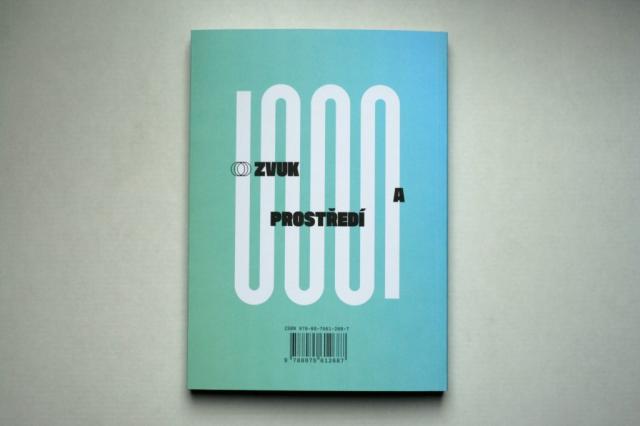
The publication is a culmination of the international interdisciplinary conference Murmurans Mundus: Sonic Ecology and Beyond, which took place in October 2019 at the Faculty of Art and Design of Jan Evangelista Purkyně University in Ústí nad Labem organized in cooperation with partners from Poland, Hungary, and Slovakia. The book focuses on current matters of acoustic ecology at the intersection of fine arts, design, music, and education, and it explores the possibilities that this discipline has to offer for reflection on today’s transforming world. The book was published in both English and Czech. (From the preface.)
The Murmurans Mundus program combined a two-day series of lectures, workshops, evening concerts and performances with the exhibition of several sound and video installations on the topic of the weather (Atmospheric Disturbances). The project was supported by a grant from Visegrad, and guests from Slovakia, Poland, and Hungary personally took part in the event. Thanks to the support of the University, guests also arrived from from Slovenia, Austria, Germany, Portugal, the UK and the US. Papers for a collective anthology were provided by only a few, but these nonetheless form an inspiring collection of dozen or so theoretical and practical texts. The editors Krtička and Mrkus have integrated two additional studies into the anthology, originally intended as an accompanying text for the publication of a Czech translation of The New Soundscape (1970) by Raymond Murray Schafer (essays by Sabine Breitsameter and Jozef Cseres). After the previous collective anthology Landscape in Focus (2016) devoted to the general issues of human industrial landscape and nature and ecology, also prepared by Mrkus, this stands as another example of a synthesizing effort within the milieux of interdisciplinary approaches, both in and outside of academia in the Czech Republic.
In the editorial text, published here by permission of the editors, the individual contributions are briefly outlined.
Introduction
Jan Krtička and Pavel Mrkus
In fact, try as we might to make a silence, we cannot. The above quote refers to the realization that dawned on John Cage during his visit to the anechoic chamber at Harvard University. Although no sound could enter the chamber, Cage “heard two sounds, one high and one low.” We indeed cannot escape sound — even if we try to completely insulate ourselves from its source, we hear the sounds of our own body. However, while we can’t escape sound (except perhaps by going deaf), our culture is a predominantly visual one. In order to orient ourselves, not only in space, but also in relationships, situations, or pieces of information, we try to visualize them. We create visual representations to portray or complement visions, ideas, texts, and sounds. But what happens if we suppress visual perceptions and focus our attention primarily on acoustic ones? Will they simply confirm what we have already seen with our eyes, or will they convey a new quality, a new type of information, or another level of aesthetic experience?
Such questions are asked by artists, scientists, and all those who perceive their environment as a whole and pay attention to its acoustic qualities. Landscapes, cities, and interiors are made up of sounds; their shape is audible. Sound, whether natural or artificially produced by human activity, has a significant impact on our experiences, but also on our memories of places and events. Being attentive to soundscapes is part of the research in the field of sound ecology, bridging various disciplines from physics and acoustics through environmental studies and musicology to various forms of contemporary fine art. It might be interesting to note a paradox between two contrasting realities: the louder the artificial, e.g. industrial, noise gets, the more perceptive we are to natural sounds and the more we appreciate them. Nevertheless, all of these elements form a larger whole — today’s soundscape, which we learn to perceive anew.
The present collection of texts follows on from the Murmurans Mundus: Sonic Ecology and Beyond / CENSE Third Annual Conference, which took place in early October 2019 at the Faculty of Art and Design of Jan Evangelista Purkyně University in Ústí nad Labem. The topics and personalities brought together at the conference inspired the creation of this anthology.
The publication consists of two parts that are largely intertwined: theoretical studies and reflections of artistic projects. Strong links are established across both sections as the texts enter into dialogue and complement each other. From our point of view, several thematic subgroups can be found in the book. However, this should not be seen as the only possible approach to the publication, as we hope that every reading will allow for new connections and meanings to be found.
Jozef Cseres offers an introduction to the subject of sound and its role in culture and the environment, based on a reflection of the thoughts of John Cage, Raymond Murray Schafer, and Jacques Attali. In fact, these three major figures largely defined the thinking about sound in our Western culture, and most of the authors of this publication refer to them in one way or another. Sabine Breitsameter looks at the ongoing transformations of our environment from a sonic perspective and critically comments on the gradual homogenization of urban soundscapes in the context of globalization, while Anna Kvíčalová questions the modern dichotomies between nature and culture against a backdrop of acoustic ecology in the Anthropocene. The clash between natural and man-made environments is also reflected in the work of Nathan Wolek, who made a series of audio field recordings at DeLeon Springs State Park in Florida, USA. In their respective projects, Peter Cusack and Tomáš Šenkyřík managed to capture audible anthropogenic changes in the environment. The Aral Sea Stories project uses sound to document the disappearance of the Aral Sea, whereas the Dawn Chorus project mirrors the current COVID-19 pandemic.
Studies and recordings of the sonic environment bring us to the question of how we actually listen and whether it is possible to develop or cultivate this capacity. Martin Flašar points out that all listening must begin in silence, or relate to it, so that we can discern and understand the soundscapes we live in. Aleksandar Vejnovic, on the other hand, takes another position and argues that it is through the use of digital technologies that we can promote a focused and conscious way of listening. A parallel to this can be found in Irena Pivka and Brane Zorman’s multimedia performance Hodi.TI/2.WALK, which stimulates the audience through walking and listening to audio recordings via headphones and a mobile application. Man influences and shapes the sonic environment by his mere existence and by his activity. If we engage in a conscious and creative interaction, it may result for example, in a series of audio events or musical compositions, as shown in Jan Trojan’s text Music for the Siren, which describes an extensive project combining specific signals from our sonic surroundings, musical composition, and radio broadcasting in order to create an exceptional, time-bound acoustic event. Sam Auinger and Bruce Odland work in similar settings (i.e. urban areas), but on different timescales and by other means: their installations transform environmental noise into a new sonic reality.
The sound medium does not exist in a void, and we tend to think about our listening experiences in wider contexts and in analogies. Július Fujak explores the question of whether certain sounds and their recordings can be assimilated to photographs — and whether there is such a thing as sonic photography — illustrating his reasoning by his own composition, Pentrophony. Miloš Vojtěchovský approaches environmental transformations from a broader perspective, choosing to focus on our understanding of weather. This topic provided the basis for the Atmospheric Disturbances exhibition, which brought together projects from the domain of sound art and beyond, and it is further developed in Vojtěchovský’s paper. (Participants in the exhibition were Zdeněk Košek, Marie Steinerová, Michal Kindernay, Jan Krombholz, Polina Katchenka and Ibra Ibrahimovič, Daniel Hanzlík, Slávek Kwi, Peter Cusack, Felix Blume, Raguel Castro and John Grzinich, note of the editor).
Although the basic texts about sound and environment, ways of listening, and acoustic ecology from R. M. Schafer, Bernie Krause, Pauline Oliveros, and others have been around for decades, these topics were long overlooked in Central Europe. Only recently did works exploring the ideas of acoustic ecology start to emerge in the field of fine art. Today more than ever, at a time when the world is undergoing rapid changes that are not easy to capture, let alone admit, listening, recording, analyzing, and approaching sounds from our environment in a creative way can contribute to a deeper understanding of what is happening around us and what our role or position is.
Although the term is only just being discussed, artistic research plays a key part here, opening up possibilities for a new perception of the environment in its entirety. We hope that our book, which offers mainly artistic insights on acoustic phenomena at the intersection of exact sciences, music, and sound art, will be a valuable contribution to the debate on sound ecology.
For further information: Sound and Environment.
Place your order at artmap.cz.
Publikace "Sound and Environment" byla vydána Fakultou umění a designu, UJEP v Ústí nad Labem

Kniha navazuje na mezinárodní mezioborovou konferenci Murmurans Mundus: Sonic Ecology and Beyond která proběhla na začátku října 2019 na Fakultě umění a designu Univerzity Jana Evangelisty Purkyně v Ústí nad Labem. Byla připravena ve spolupráci s partnery s Polska, Maďarska a Slovenska. Kniha je úvodem do zvukové ekologie perspektivou výtvarného umění, designu, hudby a vzdělávání. Jde o kolektivní monografii a autoři uplatnili osobní pohledy na danou problematiku. Kniha reflektuje aktuální dění a uvažování v kontextu zvukové ekologie. Vychází v anglickém a českém jazyce.
Obsah
- Jan Krtička & Pavel Mrkus: Editorská předmluva
- Sabine Breitsameter (D): Řazení zvuků: Homogenizace poslechu v době zvukové globalizace
- Sam Auinger + Bruce Odland (O+A) (AT): SONIC VISTA
- Anna Kvíčalová (AVČR): „Skutečně nepřirozené“: Ztráta člověka v antropocénu
- Nathan Wolek (USA): DeLeon Soundscape Project
- Martin Flašar (MU, Brno): Výchova k tichu: naslouchání předchází hudbě
- Tomáš Šenkyřík (ČR): Ranní chór v konfrontaci s civilizačním hlukem, 2019—2020
- Aleksandar Vejnovic (D): Práce s publikem v akustické ekologii: Zpřístupnění kultury a aktivizace široké veřejnosti na příkladu případové studie
- Irena Pivka & Brane Zorman (SL): Hodi.TI / 2.Walk
- Jan Trojan (HAMU): Hudba k siréně. Akustický signál artikulovaný hudebním nástrojem ve formě hudební kompozice nebo performance
- Jozef Cseres (MU, Brno): Zvuková ekologie Johna Cage a Raymonda Murrayho Schafera
- Július Fujak (Nitra): Zvuková fotografie jako otisk kairu (osobní poznámky na okraj)
- Miloš Vojtěchovský (CR): Mračna, mraky, obláčky: poznámka k fenomenologii a ekologii počasí
- Peter Cusack (UK): Příběhy Aralského jezera
Program Murmurans Mundus (Svět, který šumí) kombinoval dvoudenní sérii přednášek, dílny, večerní koncerty a performance s výstavou několika zvukových, nebo obrazově zvukových instalací na téma počasí (Atmosférické poruchy) v galerii veřejného prostoru Hraničář. Projekt konference byl podpořen grantem z Visegradu, takže se akce osobně zúčastnili hosté ze Slovenska, Polska, Maďarska, diky podpoře Univerzity i ze Slovinska, Rakouska, Německé Spolkové Republiky, Portugalska u USA. I když rámec přednesených příspěvků byl širší, než je tomu u textů v knize, jde o inspirativní a pestrou kolekci jak teoretických, tak více na praktické otázky zaměřených článků. Po předchozí kolektivní monografii Krajina v pozoru z roku 2016 věnované obecným otázkam ekologie krajiny, jde o další významný syntetizující počin v oblasti mezioborové spolupráce v akademickém i mimoakademickém prostředí v Česku. V editorském úvodu, který zde se svolením vydavatele zveřejňujeme, jsou uvedeny stručně jednotlivé příspěvky.
Ukázka
Ve skutečnosti ticho nemůžeme slyšet — ať děláš, co děláš, ticha nedocílíš. John Cage
Uvedený citát odkazuje ke zkušenosti Johna Cage, kterou učinil ve zvukotěsné komoře na Harvardově univerzitě. Přestože dovnitř komory nevnikal žádný zvuk, Cage slyšel „ke svému překvapení dva zvuky: vysoký a hluboký“. Zvuku skutečně nejsme schopni uniknout — i když se od jeho zdroje zcela izolujeme, slyšíme zvuk vlastního těla. A přestože před zvukem nelze uniknout (snad jen ztrátou sluchu), je naše kultura dominantně orientovana vizuálně. Abychom se byli schopni orientovat, a to nejen v prostoru, ale i ve vztazích, situacích či informacích, snažíme se je vizualizovat. Vytváříme obrazové reprezentace, abychom jimi ztvárnili nebo doplnili vize, myšlenky, texty i zvuky. Co se však stane, když vizuílní vjemy potlačíme a zaostříme svou pozornost především na akustické vjemy? Budou jen potvrzením toho, co jsme si již ověřili zrakem, anebo přinášejí novou kvalitu, nový typ informace či jinou úroveň estetického zážitku?
Tyto a podobné otázky si kladou umělci, vědci i všichni ti, kteří vnímají své životní prostředí v jeho celistvosti, a zejména pak v jeho akustických kvalitách. Krajina, město, či interiér se prostřednictvím zvuku dotvářejí, jejich tvar je slyšitelný. Zvuk, ať již přirozený, či uměle vytvářený lidskou činností, výrazně ovlivňuje naše prožívání, ale i paměť místa a události. Pozornost ke zvukové krajině je součástí zkoumání zvukové ekologie napříč různými obory od fyziky a akustiky přes environmentalistiku a hudební vědu až po různé formy současného výtvarného umění. Je možné si přitom povšimnout zajímavého paradoxu se zkušenosti kontrastu — čím výrazněji zní zvuk umělý, například industriální, tím zřetelněji a příznivěji si uvědomujeme zvuky přirozené. Vše ovšem patří do velkého celku současné zvukové krajiny, kterou se učíme znovu vnímat.
Soubor textů, který předkládáme, vychází z konference Murmurans Mundus, která se uskutečnila na Fakultě umění a designu Univerzity Jana Evangelisty Purkyně v Ústí nad Labem na začátku října roku 2019. Témata a osobnosti, jež se na konferenci sešly, byly inspirací pro sestavení antologie textů.
Publikace je komponována ze dvou základních celků, které se vzájemně prolínají: teoretické studie a reflexe uměleckých projektů. Ty pak vytvářejí významové vztahy napříč rozdělením, aby se navzájem doplňovaly, rozvíjely nebo vedly dialog. Z našeho pohledu lze v oblasti jednotlivých témat vysledovat v publikaci několik podskupin. Tento návrh by však neměl být vnímán jako mřížka definující čtení publikace. Každé čtení by, doufáme, mělo umožnit nalezení nových vztahů a významů.
Jozef Cseres nás uvádí do problému fenoménu zvuku a jeho role v kultuře a životním prostředí na základě reflexe uvažování tří autorů: Johna Cage, Raymonda Murrayho Schafera a Jaquese Attaliho. Ostatně zmíněné osobnosti do značné míry definovaly uvažování o zvuku v naší západní kultuře a většina autorů této publikace k nim nějakým způsobem odkazuje. V aktuální reflexi proměn prostředí, v němž žijeme, skrze zvuk si Sabine Breitsameter všímá postupné nivelizace urbánních zvukových prostředí v souvislosti s globalizací a podrobuje je určité kritice. Vedle toho Anna Kvíčalová kritickým způsobem zkoumá vztah přírodního a kulturního k akustické ekologii v době antropocénu. Střet přírodního a člověkem modifikovaného prostředí se odráží také v projektu Nathana Woleka, který pořídil sérii terénních nahrávek přírodního parku De Leon Springs na Floridě. Významnou proměnu prostředí způsobenou člověkem, již je možné akusticky zachytit, zaznamenali ve své práci Peter Cusack a Tomáš Šenkyřík. Projekt Aral Sea Stories ve zvukové podobě dokumentuje mizení Aralského jezera, zatímco v Ranním chóru se odráží vliv aktuální pandemie COVID-19. Reflexe a záznam akustického prostředí nás vede k otázce, jakým způsobem vůbec nasloucháme a zda lze tuto činnost nějak rozvíjet nebo kultivovat. Martin Flašar upozorňuje, že veškeré naslouchání musí začínat v tichu nebo se k němu vztahovat, abychom byli schopni rozlišovat a porozumět okolnímu zvukovému prostředí. Naproti tomu Aleksandar Vejnovic vychází z jiných pozic a navrhuje využití digitálních technologií k rozvoji soustředěného a vědomého naslouchání. Paralelu k tomu můžeme najít v projektu Ireny Pivky a Brana Zormana Hodi.TI/2.WALK, který publikum aktivizuje skrze chůzi a poslech zvukových nahrávek přes sluchátka a mobilní aplikaci.
Člověk sám o sobě svou existencí a činností ovlivňuje a definuje zvukové prostředí. Pokud se tato činnost stane vědomou kreativní interakcí, může vyústit například v sérii zvukových událostí či hudebních kompozic, jak o tom píše Jan Trojan v textu Hudba k siréně. Popisuje zde rozsáhlý projekt, v němž dochází k propojení specifického zvuku prostředí s komponovanou hudbou a rozhlasovým vysíláním, aby vznikla časově ohraničená a výjimečná akustická událost. V typově stejném prostředí (velkoměsto), ale v jiném časovém horizontu a jinými prostředky vytvářejí Sam Auinger a Bruce Odland instalace, jež transformují hluk prostředí do nové zvukové skutečnosti.
Médium zvuku neexistuje izolovaně a naše zkušenost i myšlení tíhne k tomu vnímat naslouchání ve vztazích či analogiích. Július Fujak si klade otázku, zda lze o určitých zvucích a jejich záznamech uvažovat podobně jako o fotografii; zda existuje něco jako zvuková (sonická) fotografie, a své uvažování o ní dokládá vlastní kompozicí Pentrofónia. V širší rovině přistupuje k reflexi proměn životního prostředí Miloš Vojtěchovský. Jako pole pro formulaci problému si zvolil způsob našeho uvažování o počasí. Na jeho základě sestavil výstavu Atmosférické poruchy zahrnující nejen zvukové projekty a v představeném textu téma dále rozvinul (výstavy se zůčastnili Zdeněk Košek, Marie Steinerová, Michal Kindernay, Jan Krombholz, Polina Katchenka a Ibra Ibrahimovič, Daniel Hanzlík, Slávek Kwi, Peter Cusack, Felix Blume, Raguel Castro a John Grzinich).
Přestože od vydání základních textů o zvuku a prostředí, způsobech naslouchání nebo akustické ekologii od R. M. Schafera, Bernieho Krauseho či Pauline Oliveros uplynula desetiletí, nebyla tato oblast ve středoevropském prostoru dosud šířeji reflektována. Teprve v poslední době se zde začínají objevovat práce čerpající z myšlenek zvukové ekologie na poli výtvarného umění. Zvláště v době, kdy svět prochází rychlými změnami, které není lehké zachytit, natož si je připustit, může naslouchání, zaznamenávání, analýza a kreativní uchopení zvuků prostředí rozšířit porozumění tomu, co se kolem nás děje a jakou roli či místo v této situaci zastáváme. Umělecký výzkum, jakkoliv je tento termín v současnosti teprve diskutován, právě zde hraje zásadní roli a otevírá možnosti nového vnímání prostředí v jeho celku. Doufáme, že naše kniha, která přináší zejména umělecká zkoumání akustických fenoménů, v nichž se protínají přístupy exaktních věd, hudby a zvukového umění, bude užitečným příspěvkem k diskusi o zvukové ekologii.
Jan Krtička a Pavel Mrkus
Další informace a objednavky na adrese: murmurans[at]gmail.com. a sound and environment.
Chris Watson on Walking Festival of Sound
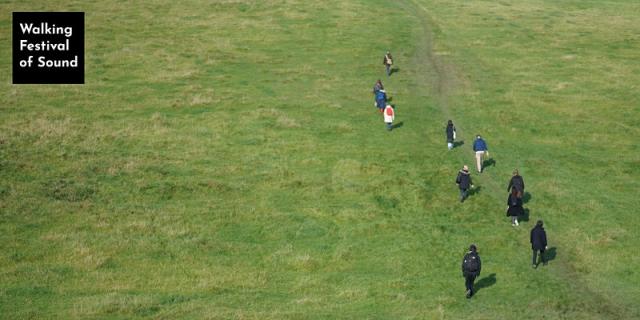
The Walking Festival of Sound invites field recordist Chris Watson for conversation about sound walking and environmental listening.
How does sound walking relate to the practice of field recording? Does walking through an environment change the way we listen to it? In this conversation, Chris Watson will share his experience of sound walking and how it relates to his long established career as a musician and sound recordist.
A Zoom link will be sent to participants shortly before the event.
About Chris Watson
Watson was a founding member of the influential Sheffield based experimental music group Cabaret Voltaire during the late 1970’s and early 1980’s. Since then he has developed a particular and passionate interest in recording the wildlife sounds of animals and habitats from around the world. As a freelance composer and sound recordist Watson specialises creating spatial sound installations which feature a strong sense and spirit of place.
His installations have been commissioned by international galleries and festivals such as Sheffield Millennium Gallery, Opera North in Leeds, The National Gallery, London, The Louvre, Paris, the Aichi Triennial in Japan and Unsound in Kraków.
About the Walking Festival of Sound
Walking Festival of Sound is a transdisciplinary event exploring the role of walking through and listening to our everyday surroundings. It combines a number of free and public events including walking performances and walking seminars which take place in diverse public spaces. Evening events informed by walking practices take place in various event spaces (see more details in the program section). Walking Festival of Sound facilitates a meeting point for an international network of practitioners and researchers interested in sound and walking. Through diverse events we explore how walking and listening practices can augment and challenge the way we perceive, navigate through, and care for our shared environments. In 2019 the festival takes place in two cities, Stockholm and Newcastle The Walking Festival of Sound 2021 is kindly funded by the Culture of Solidarity Fund.
The program of events is organised and curated by Jacek Smolicki and Tim Shaw.
A Zoom link will be sent to participants shortly before the event.
The Ruins of the Salföld Pauline Monastery as a Soundscape
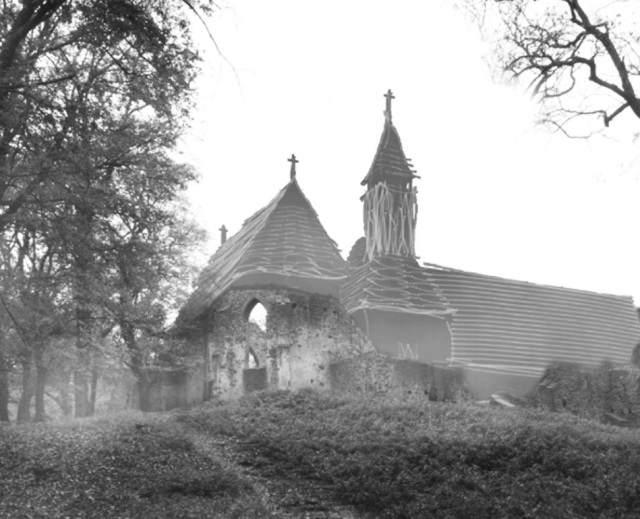
Csaba Hajnóczy, Zoltán Mizsei
Spring Seminars 2021
Moholy-Nagy University of Art and Design Budapest (MOME) and Institute of Advanced Studies Kőszeg (iASK) started a joint research and development program. Its subject is the acoustic ecology of the Transdanubia region in Western Hungary, combined with elements of the creative provincial city music development program “Sounding City” started by the music department of iASK. In our presentation we will review the regarding pathfinding activities at both institutions in the past few years: “Sounding Houses” and “Sounding City Well (iASK) – sonic ecology related courses and events (MOME). The main focus will be the recently created website “Ruins of the Salföld Pauline Monastery Soundscape”. In its current state, the Pauline monastery in Salföld is a well-kept ruin, half an hour’s walk from the village, in the forest. The place associates two sound worlds: the sacred music of the historic church practice, and the sounds of nature.
More information about the Pauline Monastery.
Csaba Hajnóczy is a musician, composer, musicologist, and teacher at Moholy-Nagy University of Art and Design Budapest, living and working in Budapest. He was the main initiator and organizer of the CESSE – Conference #1. His recent artistic interest is field recording based composition and the use of spatial sound systems. Since 2013 he has given numerous talks and workshops in the field of acoustic ecology, including soundwalks, in Hungary, Poland, Belgium, Turkey. Csaba participated in the Architecture and Senses in Plasy, 2017 and in all following CENSE events.
Zoltán Mizsei graduated from the Franz Liszt Academy of Music as a professor of choral conducting and Church music. He received his DLA in 2004. Currently, he is associate professor there at the department of Church music. He teaches Renaissance church music, choral conducting and voice teaching practices. Since 2014 he has been the conductor of Schola Academica choir. He sings and plays instruments in several early music and world music ensembles, composes music for contemporary dance performances and films. He teaches improvisation for music therapists at ELTE University. He organized different festivals and workshops to combine composed music and soundscape. Recently has established the Music Laboratory at the Institute of Advanced Studies, Kőszeg (iASK) with an interdisciplinary research, sound arts, touristic and education agenda entitled ‘Sounding City’.
Artistic Research of Aspects and Potentialities of Spatial Audio Systems Application in Context of Gallery Installation and Audio Performance
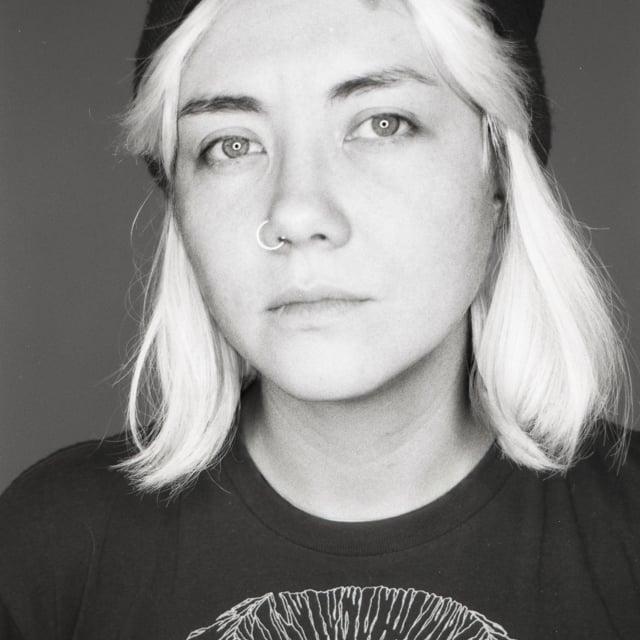
Polina Khatsenka
Spring Seminars 2021
The talk introduces the author’s studies of spatial audio phenomenon in a wide range,from spatial aspects of aural perception as a basic need for locating oneself in space, to nowadays application of immersive audio formats such as Ambisonics. The presentation will contain a brief look through the development of spatial audio formats and its artistic and industrial application, followed by the short presentation of the author’s artistic projects, ranging from audio installations in a gallery to audio performance in spatial sound systems. Final part of the presentation will be devoted to the author’s curatorial activities, including organisation and production of phonon ~ event series, mediating contemporary experimental electronic and electroacoustic music and sound art, based in Ústí nad Labem.
Polina Khatsenka is an audiovisual artist, sound designer and sonic curator from Minsk, Belarus, based in Usti nad Labem. She is devoting her work to various aspects of sound with a focus on audio performance, site-specific installations and composition. One of the essential aspects of her work is collaboration and group projects with/for independent institutions with a self-organised approach. Polina implies expanding the perception of both one’s and shared environment within her work, be it uncovering and operating with invisible but yet existing radiating fields or addressing existential topics on a personal level.
Ear Trumpets’ Afterlives in the Era of Electricity and Electronics
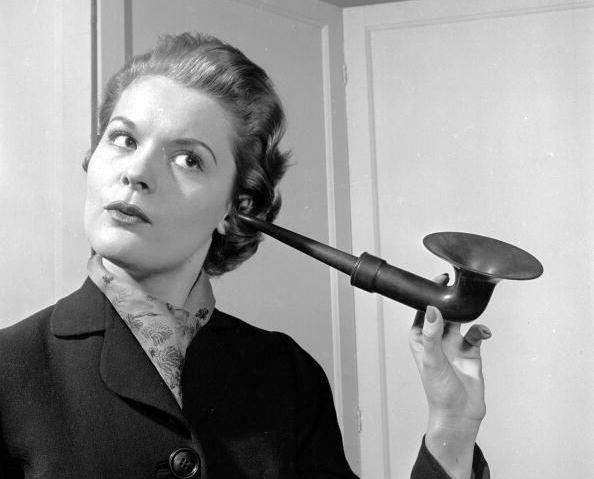
Follow the zoom link to attend the seminar.
Magdalena Zdrodowska
Spring Seminar 2021
Throughout the 19th century ear trumpets became the most popular and in fact the only technical solution for deaf people. They merged with the behavior regarded as typical for the deaf such as misinterpretations and communicational loss, therefore ear trumpets turned into a social stigma. They became objects that were bashfully hidden by users. In the 20th century however ear trumpets’ image as well as functions changed as they were substituted with modern, electric and later electronic hearing prostheses. These acoustic hearing aids became antiquated but they did not vanish – they have relocated within the technological and cultural domains. In the presentation I will consider ear trumpets’ afterlife in the 20th and 21st century using the object oriented analysis, interviews, discourse analysis of advertisements, and documents from British National Archives and Thackray Museum of Medicine in Leeds.
Magdalena Zdrodowska – assistant professor in the Department of Audiovisual Arts, Jagiellonian University, Poland. She is interested in the complex and mutual relations between technology and non-hearing. Her research work is grounded in film and media studies, deaf and disability studies, and history of technology. Her book Telephone, cinema, and cyborgs. Mutual relations between technology and deafness (in Polish: Telefon, kino i cyborgi. Wzajemne relacje niesłyszenia i techniki) will be published in June 2021.
In the second part of our seminar Matěj Frank - visual artist based in Vienna, Chudobín and Wroclaw - will describe his sound sculptures and his works with ear trumpets.
Matěj Frank (CZ) is a visual artist, usually being on the way between Vienna (AT), Chudobín (CZ) and Wroclaw (PL). In his interdisciplinary work, Frank explores the space through sculptures, spatial projects and sound installations and depicts time through processual drawings and durational performances. An important aspect of his work is capturing gradual transformations while keeping the simplicity of the form and/or process. As a member of the cultural association Bludný kámen (CZ), Frank organizes exhibitions of contemporary art and intermedia projects. Currently, he teaches at the Sculpture department at the Eugeniusz Geppert Academy of Art and Design in Wroclaw (PL).
In recent years, Frank realized several listening sculptures, usually titled Monologue. These interactive objects serve as acoustic amplifiers of „small sounds“ in their surroundings. Similar objects were originally used on a larger scale as acoustic locators in the pre-radar era to locate enemy aircraft, and on a smaller scale as simple hearing trumpets. Frank placed his sculptures in various contexts and environments, in nature as well as in urban areas and gallery spaces.
Rerouting the Trails for Soundwalking. The Art of Walking and Listening in the Context of Environmental Humanities
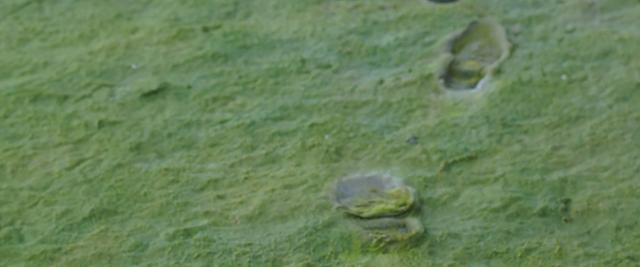
Join us on Zoom for the Seminar
Jacek Smolicki
Spring Seminars 2021
Soundwalking has traditionally been problematized and exercised as an aesthetic practice that advocates deep aural attention to the here and now. A number of scholars and researchers have dealt with meditative aspects of walking and listening alongside their pragmatic application to the study of noise pollution in urban environments. In this talk, I intend to reroute the dominant paths for theorizing and practicing soundwalking by turning to perspectives from environmental humanities. I am specifically interested in exercising a vision of soundwalking as a specific discursive, empirical but also speculative modality for becoming in tune with more-than-human species, temporalities and scales. Moreover, given that many soundwalking initiatives have been pursued in alliance with Western scholarship and ontologies, in this talk I will inquire into other worldviews for which the acts of walking and listening to surrounding environments have been central.
Among other soundwalking projects, in this talk I will draw more specifically on Intertidal Room. It is a soundwalk composition developed for Vancouver’s coastline in the summer 2020. Combining elements of creative storytelling, historical research, field recordings, and soundscape composition, this soundwalk was intended to be listened to during a period of slack water, a moment when tide is at the lowest point and soon about to return. Attending to the fugitive nature of intertidal zones, this soundwalk intended to provide room for an increased aural attention to the power relationships that have affected diverse, often imperceptible layers of these complex environments. By analyzing different stages of production as well as reception of the project, I will argue that beyond more critical awareness of the present moment, soundwalks offer a particular opportunity for lending an ear to the environmental history of a given place.
Jacek Smolicki is a Krakow-born and Stockholm-based interdisciplinary artist, designer, postdoc researcher, and soundwalker. His works brings ethical, historical, and reflective dimensions to recording practices and technologies in a more-than-human context. Besides working with existing documents, Smolicki develops alternative modes of sensing, recording, archiving, and mediating stories and signals from diverse sites, scales, and temporalities. His work is manifested through soundscape compositions, soundwalks, site-responsive performances, experimental para-archives, audio-visual installations, and diverse forms of writing. He has presented his works internationally (e.g. Kraków, Madrid, Moscow, Helsinki, Stockholm, San Francisco, Budapest, Vienna, Sarajevo, Oxford). In 2017 he completed his PhD from the School of Arts and Communication at Malmö University where he was a member of the Living Archives research project. Between 2020-2023 Smolicki pursues an international postdoc funded by the Swedish Research Council. His research explores the history and prospects of field recording and soundwalking practices from the perspective of post-digital arts, environmental humanities, and philosophy of technology. He is also an associate scholar at the Uppsala Informatics and Media Hub for Digital Existence at Uppsala University. From January 2020 he is a member of BioMe, a research project that investigates ethical implications of AI technologies on everyday life realms. Smolicki explores sonic capture cultures and the impact of AI technologies on (human) voice. He is a co-founder and curator of Walking Festival of Sound, a transdisciplinary event exploring the role of walking through and listening to our everyday surroundings.
Website: www.smolicki.com
First Annual General Constituent Assembly Meeting
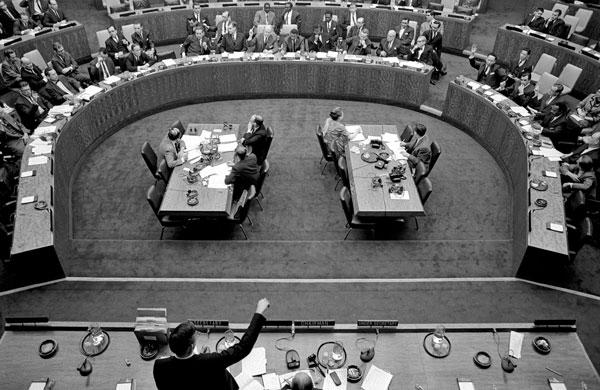
Participants in attendance:
Csaba Hajnóczy, Milos Vojtechovsky, Michal Kindernay, Sarka Zahálková, Polina Katshenko, Anna Kvíčalová, Petra Kapš, Anamaria Pravicencu, Jan Krtička, Lloyd Dunn, Jonáš Gruska, Brane Zorman, Jan Kromholtz, Boris Klapal, Slawek Wieczorek, Lucie Páchová, Sara Pinheiro (17 members)
People who sent a note that they could not join: Patrick Tubin Mcginley, Barbara Benish, Tomáš Šenkyřík, Julius Fujak, Barbora Gallová.
In the board were elected the following:
Csaba Hajnóczy (HU) Miloš Vojtěchovský (CR) Jan Krtička (CR) Šárka Zahálková (CR) Anamaria Pravicencu (RO) Polina Katshenko (Belarus / CR) Slawek Wieczorek (POL) (plus one person from Austria, will be invited)
The duties of the General Assembly are written in details in the By-Laws.
During the General Assembly we decided on the following:
Election of Management : 8 person in total (Chair and Deputy Chair, Secretary and Deputy Secretary, Treasurer and Deputy Treasurer)
Admission and Dues: Yearly €30 is accepted.
Further program of the meeting:
- Planned CENSE projects - Periodic CENSE newsletters - Radio and / or podcast - Thematic work groups - The decision about the next conference in 2021 or 2022
Regular Meeting of the Board
Technical host of the meeting will be Šárka.
Planned agenda:
Responsibility and competence of Board members
Setting up topic/thematic work teams
The Reveil: participation, programming
Finding an Austrian member to the Board
Finding regular time for our open Board meetings
Discuss the mailing list, and/or other communication forms regarding the Network
The agenda is open to further suggestion, within the given time frame.
Reveil 24+1 Hour Broadcast 2021
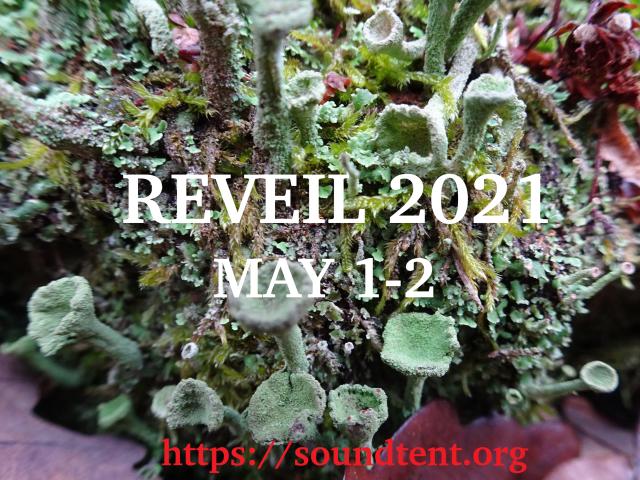
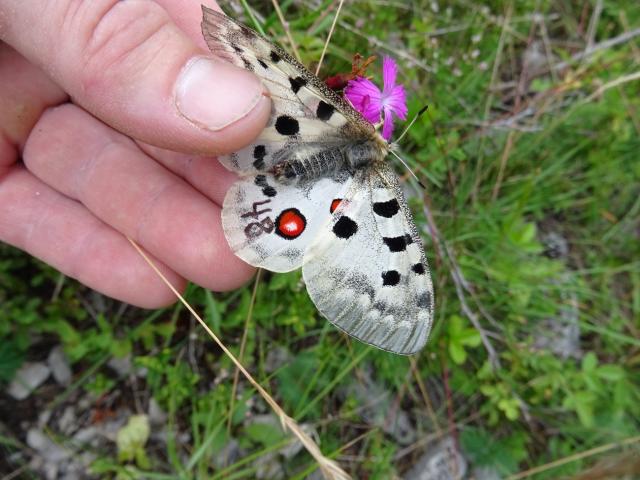
Reveil is a collective production by streamers at listening points around the planet. Starting on the morning of Saturday 1 May in South London near the Greenwich Meridian, the broadcast will pick up feeds one by one, tracking the sunrise west from microphone to microphone, following the wave of intensified sound that loops the earth every 24 hours at first light.
In 2021 Reveil features new out-side streams to be announced.
The term: off-grid will inform a program of extended radio projects accompanying the Reveil broadacast. On the verge of Summer, Reveil heads out-side again, trying out ways to be in touch off-screen, stretching its wings after confinement. Swapping, streaming, assembling a collectively produced long radio form, Reveil imagines and is part of an acoustic commons in the making.
To contribute a stream using a mobile phone, laptop or Raspberry Pi, see the recipes for streamers. Each stream adds to the variety and scope of this transect. Please check resources for more information here and here.
Streams come from a wide variety of locations, at a time of day when human sounds are relatively low, even in densely populated sites. This tends to open the sound field to a more diverse ecology than usual. The Reveil broadcast makes a space for this surplus by largely avoiding speech and music, gravitating to places where human and non human communities meet and soundworlds overlap.
The Reveil project is anticipated and informed by transects recorded by Gordon Hempton and Bernie Krause in the 1980's and 1990's that re-presented and extended auditions of the dawn chorus across large areas, as well as variants that captured the progress of Spring moving up over North America. The idea of a round-the-world dawn chorus recording lasting 24 hours has appeared periodically on wildlife and nature recordist lists. Gordon Hempton and the ornithologist Don Kroodsma have both imagined such a trajectory as a kind of aural surfing. In 2010 in collaboration with Páll Thayer, Ragnar Helgi Ólafsson made the installation DayBreak, Forever, which used a script to create a sequence through the Locus Sonus streams in much the same way Reveil would do later.
Members of CENSE or related artists participating in the Reveil 2021.
Among others: Manja Ristič - Korčula, Radio CONA - Slovenia, Jan Krtička and students of FUD UJEP - Most, Tomáš Šenkyřík / Udo Noll - Brno Lužánky, Tomáš Šenkyřík - Rusava, Michal Kindernay - radio Skryje, Šárka Zahálková - Lázně Bohdaleč, Sonicity - Biotroja Birds Sanctuary, Czech Radio Vltava, Csaba Hajnóczy - Budapest, Anamaria Pravicencu - Bucuresti, Mappa a David Petráš , Givan Béla-kra.land/, John Grzinich, [Boštjan Perovšek], Slavek Kwi, Radio Entrance, Martin Marek - Klapeida
Stay tuned! the list will be be updated.
This is the album from last year: Pass It-On
Register your interest to stream, set up a soundcamp, relay the broadcast, help here
or "contact@soundtent.org" to be in touch.
Broadcasting Partners
Resonance FM/Extra
Soundart Radio
Wave Farm/WGXC
NAISA Radio
Tune in on or Wave Farm (US), Resonance Extra (UK) and other participating radio stations.
Follow the extended radio event on the Reveil Platform starts from 05:00 am London time UTC+1 on 1st May to 06:00 am on the 2nd.
Partner organisations of the event: Acoustic Commons: Full Of Noises (Cumbria UK) · Locus Sonus (Aix FR) · Radio CONA (Ljubljana SLO) · HMU (Crete GR) · Cyberforest (Tokyo JP).
@soundtent
#acousticommmons
#Reveil2021
Reveil 24+1 Hour Broadcast 2021


Reveil je propojené vysílání v reálném čase z poslechových míst po celém světě. Začíná v sobotu 1. května 2021 za úsvitu v Londýně a jednotlivá vysílací studia si budou postupně předávat signály ze streamovacího serveru Locus Sonus směrem od západ k východu, od jednoho mikrofonu k dalšímu. Posluchači tak mohou poslouchat zvukovou vlnu, která na jaře každý den za 24 hodin obkrouží s rozbřeskem naši planetu.
Letos je projekt ve znamení "jsme venku pod širým nebem".
Chcete se do vysílání zapojit mobilním telefonem, notebookem nebo s pomocí Raspberry Pi? Přečtěte si návod. S každým dalším místem poslechu se rozšiřuje rozmanitost a dosah planetární zvukové kompozice přírodního rádia.
Proč je vysílání načasováno tak brzy ráno kdy vetšinou ještě spíte? Protože lidské zvuky ráno jsou ještě tiché a přírodní zvukové krajiny proto mají větši biodiverzitu než slyšíme přes den. Vysílání v rámci projektu Reveil většinou neobsahuje mnoho mluveného slova, nebo lidskou hudbu a odehrává se na rozhraní naší a více než lidských kultur v prostoru kde se různé zvukové světy protínají a setkávají.
Autoři konceptu Reveil byli inspirováni prací fonografů a zvukových umělců Gordona Hemptona a Bernieho Krause, kteří v 80. a 90. letech minulého století zaznamenávali zvukové krajiny za rozbřesku a v Severní Americe tak porovnávali různé podoby příchodu jara. Gordon Hempton společně s ornitologem Donem Kroodsmou o takové zvukové trajektorii uvažovali jako o "sluchovém surfování". Ragnar Helgi Ólafsson a Páll Thayer v roce 2010 vytvořili zvukovou instalaci DayBreak, Forever a počítačovým programem používajícím signál z otevřených mikrofonů na serveru Locus Sonus vytvořili pohyblivou sekvenci zvukového úsvitu, připomínající pozdější projekt Reveil.
Za síť CENSE se zúčastní například
Manja Ristič - Korčula, Radio CONA - Slovenia, Jan Krtička and students of FUD UJEP - Most, Udo Noll / Šenkyřík - Brno Lužánky, Šenkyřík - Rusava,Michal Kindernay - Radio Skryje, Šárka Zahálková - Lázně Bohdaleč, Sonicity - radio silent, Biotroja Birds Sanctuary, ČR Vltava, Csaba Hajnóczy - Budapest, Anamaria Pravicencu - Bukurešt, Mappa a David Petráš - Pezinok, Givan Béla, John Grzinich - Mooste, Slavek Kwi,Radio Entrance - Prague, Martin Marek - Klapeida
Sledujte program, nebo stránku FB, budeme postupně aktualizovat url streamu
Album z roku 2020: Pass It-On
Jestli máte zájem vysílat, zorganizovat zvukový tábor, pozvat někoho na zvukovou procházku, přeposílat rozhlasové vysílání, nebo se jinak zapojit program oznamte zde
případně napište na „contact@soundtent.org“
Partneři:
Resonance FM / Extra
Soundart Radio
Wave Farm / WGXC
NAISA Radio
Český Rozhlas Vltava
nalaďte si třeba: Wave Farm (USA), Resonance Extra (UK)
nebo další rozhlasové stanice, které se připojily.
Český rozhlas Vltava bude vysílat ve spolupráci s GHMP ambient ze zahrad Trojského zámku mezi 4:30 a 6:00 a přibírat některé streamy z Čech až na konec světa.
Sledujte rozšířenou rozhlasovou událost na platformě Reveil od soboty 1. května od 5:00 londýnského času UTC+1 do neděle druhého dne do 06:00 ráno.
Partnerské organizace Acoustic Commons, Full Of Noises(Cumbria, UK), Locus Sonus (Aix, FR), Radio CONA(Ljubljana SLO) HMU(Kréta GR), Cyberforest(Tokio JP), Český Rozhlas Vltava, projekt radiocustica, Galerie hlavního města Prahy. atd.
@soundtent
#acousticommmons
#Reveil8
Regular Meeting of the Board
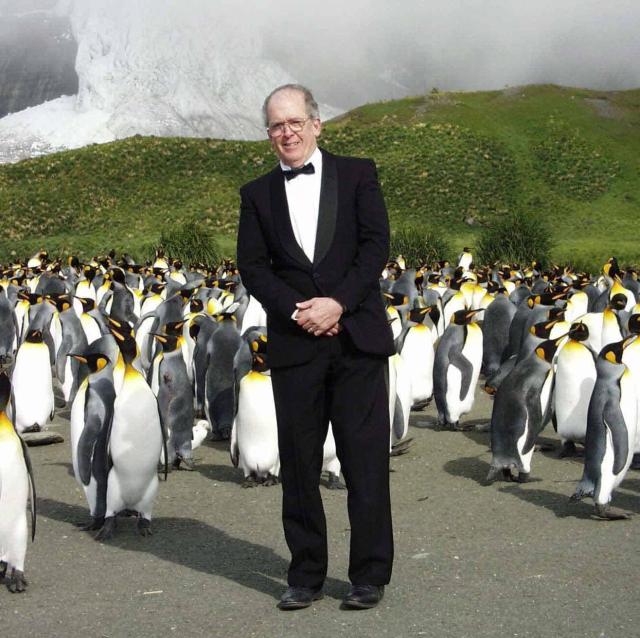
Program
The board is public, anybody can participate.
You are welcome to join the webmeeting here. The meeting starts at 0900 CEST.
Previously, the board agreed:
- Csaba will find out, where if we must open Austrian bank account for CENSE
- The treasurer and the deputy treasurer is Šárka and Annamaria
- If there is a tie in voting, one member of the board will volunteer not to vote
- Board meetings agenda is prepared by the moderator
- Meetings will be on Zoom platform (Jan or Csaba will provide a link each time)
- There are active members of CENSE and supporting members. Active members pay the annual fee of 30Eur.
Jan Krtička suggests this agenda for the Thursday meeting:
- Discuss and Confirm the board member roles and their duties
- Discussion on the date, the location and the organizer of the planned 2021 CENSE Conference / Gathering
Moderator June 3rd: Miloš Vojtěchovský
Confirmed board members: Anamaria. Sárka. Csaba, Polina, Milos, absent: Jan
Discussion platform: https://discord.gg/vcVX88ZaaK
World Listening Day Events - SOA by Raquel Castro
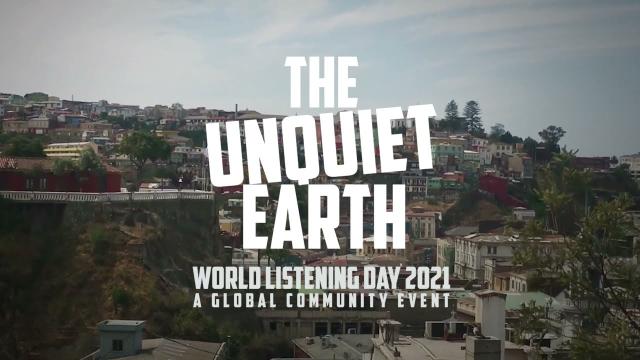
Screening
at Display Gallery, Prague at 6PM
in the framework of the CENSUS exhibition
and
GAMPA Gallery Pardubice SOA – film screening & sound walk at 7pm
(in collaboration with CENSE – Central European Network for Sonic Ecologies.) after the screening there is a soundwalk in the city of Pardubice
and
Tu Fokan Music Summer School in Hungary The event includes a review of sonic ecology, the activities and merits of R- Murray Schafer, geophonics, which gives the essentials of this year "Unquiet Earth" topic. Listenings and demonstrations are based on the work and art of JT Bullitt, specially the Earthsound Project. Screening of Raquel Castro's Film " SOA".
supported by The Hungarian Institute of Seismology
Tomáš Šenkyřík live stream from the water pool on his garden between 2 and 3 pm listen to the live stream: http://locus.creacast.com:9001/tomas_senkyrik.mp3
All events organized in the framework of the World Listening Day: A Global Community Event.
about the film:
About soundscapes, silence and noise, all sound spectra, from infra to ultrasound, frequencies and rhythm. But also about ecology, citizenship, equality and urban policies. The listening as a catalyst for transformation and sounds that are part of our everyday life places. How the soundscape affects us and how we are responsible for the sound we generate?
For several years, sound artist and documentary filmaker Raquel Castro recorded interviews with many sound artists, soundwalkers and sound theorists about the role of sound and listening in human life, about the education towards improving of aural literacy. The Soa film was premiered last year and now for the first time in Czech Republic.
"These recordings took place in Lisbon, S Miguel, London, Berlin, Glenshee, Oporto and Valparaíso, places that visually and sonically illustrate this film-essay, a simultaneously formal and narrative exercise that seeks to summon emotions from listening."
The theme for 2021 “The Unquiet Earth” is an invitation to reflect on and engage with the constant murmur of the Earth, sounds beyond the threshold of human hearing, to remind ourselves that we share this mysterious and awesome planet. Small, hidden, subterranean, aerial, underwater, infra and ultrasonic sounds, inaudible to the naked ear, can bring a new, potentially hopeful, perspective on the future of the planet and humanity. Listening as activism encourages us to question our attitudes as listeners as we aim to construct a more inclusive and empathetic new world. Join the unquiet revolution!
— Raquel Castro
Raquel Castro is film director, curator and sound artist, researching on communication and arts about sound, apace and acoustic Identity. Among other films, she directed the documentary Soundwalkers which was screened at various conferences of sound art and documentary film festivals. She is the founder and director of International Symposium Invisible Places and the environmental sound art festival Lisboa Soa. She is a fellow researcher at CICANT, the Centre for Research in Applied Communication, Culture and New Technologies.
SOA
CRIM Production 2020, Lisbon
HD, 71 min
WLD - projekce filmu Raquel Castro SOA atd

Galerie Display cense
18 července od 18 hodin
vstup volný
připraveno v rámci Worldlisteningday.org
pořádá Display – Association for Research and Collective Practice
Paralelně probíhají další akce: Pardubice od 19:00 v GAMPA – Galerie města Pardubic, Příhrádek 5, Pardubice
(Po projekci je v Pardubcích zvuková – poslechová procházka městskou krajinou). viz: otevrenakultura.cz
a po celém světě
Zvuk je součástí každodenosti míst, kde žijeme a zvukem jsme určováni víc, než si uvědoumujeme. Máme snad zodpovědnost za hluk, který vytváříme? A může být zvuk hybatelem společenské změny? Dokumentární film se zabývá zvukovým spektrem od infra k ultrazvuku, frekvencemi a rytmy. Rozhovory jsou také o zvukové ekologii, o občanství, rovnosti a sociologii města. Portugalská zvuková umělkyně a filmová dokumentaristka Raquel Castro vedla rozhovory s různými zvukovými umělci a teoretiky v Evropě i jinde. Ptala se na význam zvuku a naslouchání v lidském životě, na jejich názory na vzdělávání a na možnosti jak posílit sluchovou gramotnost. Rozhovory proběhly v Lisbonu, S Miguel, Londýně, Berlině, Glenshee, Oportu a Valparaísu.
SOA měl premiéru v loňském roce a zde je to první příležitost jej vidět v Česku.
„Tématem letošního Světového dne poslechu je „Neklidná Země“. Planetární akce je výzvou k zaposlouchání se do těch oblastí zvukového spektra, které přesahují možnosti lidského sluchu: je to výzva poslouchat myriádám jemných, skrytých, podzemních, vzdušných, vodních, infra a ultra zvuků, jimiž k nám planeta, letící vesmírem promlouvá. Aktivní poslech může porušit návyky a stát se symbolickým krůčkem ke světu, který bude méně znečištěný, více inkluzivní a empatický.“ Raquel Castro
Raquel Castro se zabývá zvukovým uměním, prostorem a akustickou identitou. Natočila několik filmů, včetně úspěšného dokumentárního filmu Soundwalkers, který byl promítán na řadě konferencích a výstavách zvukového umění a filmových festivalech. Je iniciátorkou a ředitelkou SOA - Mezinárodního sympozia a festivalu Environmentálního zvukového umění v Lisabonu.
SOA
CRIM Production 2020
HD, 71 min
http://crim-productions.com/
2021 Sanatorium of Sound in Sokolowsko, Poland
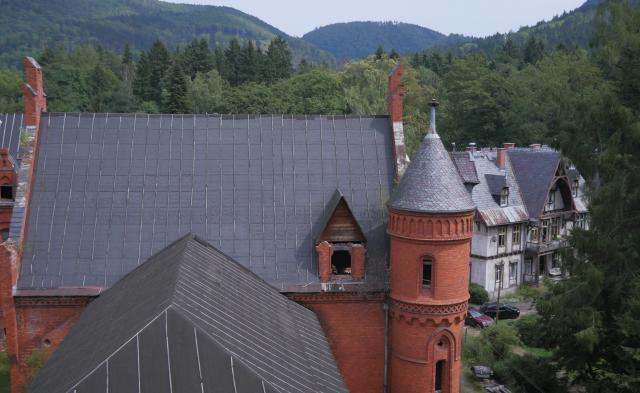
Sunday August 15th at 3 pm is scheduled the presentation of Peter Cusack and Miloš Vojtěchovský in the park
Central European Network For Sonic Ccologies - Artist Talk
Just beyond the birches of the Czech-Polish border around Mt. Spitzberg, the road running along the ridge turns sharply toward the Polish side, and steeply winds down through the dense mixed forest. In a short while, you are almost slipping and sliding down to the foot of the hills. Here lies Sokolowsko, in a lush, narrow valley, just 2 km from the border. A former spa town, with today only 1000 inhabitants, its name is still uttered among certain circles in Wroclaw and Warsaw. This is not a recent development, either; though in the past its name meant something different.
Sára Vybíralová
Sound Art and Experimental Music Make for a Surprising Boom in the Forest
Sanatorium of Sound is a festival devoted to experimental contemporary music and broadly understood sound art. Its main goal is to present the widest possible spectrum of phenomena related to the development of musical forms in the 20th and 21st centuries. Thus far, we have shown the works of about 200 artists from around the world, many of them were created especially in the context of the place during artist residencies in Sokołowsko.
Sanatorium of Sound is a festival whose greatest value is presenting the art of sound and all-new experimental forms in the context of its location – a spa town situated in the Central Sudetes. The landscape of the mountains surrounding Sokołowsko, the post-German 19th-century architecture and marvellous air has always been the inseparable attributes of concerts, exhibitions and any other reflection on new trends in contemporary music. This time it could not be different. Let us hope that the global crisis is behind us and that this year we shall meet again: close to nature, close to music, close to each other, responding to the post-pandemic effect of the need for an authentic experience. We’re back to normal.
Artists
Katarzyna Krakowiak Biliana Voutchkova Peter Ablinger Burkhard Beins Aleksandra Słyż Edka Jarząb Tatiana Heuman Joanna Halszka Sokołowska Hugo Esquinca Mario de Vega Gerard Lebik Miloš Vojtěchovský Peter Cusack Lubomir Grzelak Tim Shaw Katarzyna Podpora/Max Kohyt Wojciech Kucharczyk Justyna Banaszczyk/Darek Pietraszewski/Tomek Popakul
For accommodation contact us at: sanatoriumdzwieku@gmail.com
The Sanatorium Sound Festival is not only a concerts, but also a series of projects in the field of sound art, performance and projects created and dedicated especially to this event by musicians, composers, and interdisciplinary creators. The festival takes place in several places in Sokołowsko (Kinoteatr Zdrowie, Sala Multimedialna, Park Zdrojowy or the ruins of a 19th-century sanatorium). Every year, our festival gathers over 400 recipients from all over the world, we are visited by an exceptional audience, music lovers.
World Listening Day Livestream from the Southern Apennines in Italy
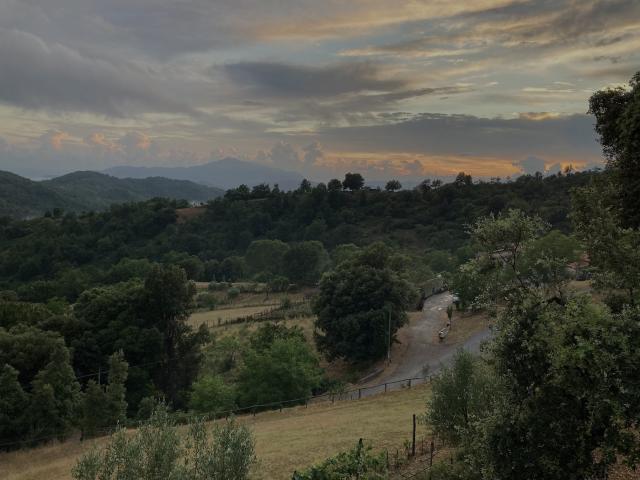
On World Listening Day we will broadcast short radio stream from South Italy, Southern Apennines, from the rooftop of a small house on the top of the hill near Tortorella village.
You are welcome to join listening session and on the program are regular sound events of a very silent valley with only two functional traditional farms, you will hear the sounds of the protected area of plants, birds, owls, wolves and other forest inhabitants. Let's protect the silence, sounds and traditional ways and balanced attitude to life of such places.
You can tune on Locus Sonus Soundmap or here: http://locus.creacast.com:9001/radio_for_owls.mp3.
Starting around 8pm (CEST), UTC +2.
World Listening Day: Tu Fokan Music Summer School
Tu Fokan Music Summer School is this year from 14th till 23rd July in Pilisszentlászló village, Hungary. On the World Listening Day, (Sunday the 18th), we will focus on it with a small presentation for the 20 Hungarian and Czech young people, as part of the joint CENSE actions. The event will include a review of the existence of sonic ecology, the activities and merits of Murray Schafer, and the phenomena of geophonics, which gives the essentials of this year "Unquiet Earth" topic. Listenings and demonstrations will be based on the work and art of JT Bullitt, specially the Earthsound Project. We will also watch Raquel Castro's Documentary Film " SOA". "Unquiet Earth", as a concept will be present in musical activities during the camp. With the help of Hungarian Institute of Seismology we'll use waveform figures of tectonic plate motions as graphic scores for music improvisation.
Kőszeg soundscape workshop — Moholy-Nagy University of Arts and Design, Budapest
Moholy-Nagy University of Arts and Design Budapest and the Institute of Advanced Studies Kőszeg announce a summer workshop on the topic of ecological sound art, between 23rd and 28th August 2021. The aim of the workshop is to create and present soundscape etudes / compositions in the framework of the Sounding City Days 2021 Kőszeg.
The participants work on the basis of field recordings made in and around Kőszeg, and their work reflects on these soundscapes. The workflow will consist of joint and individual soundwalks, sound recordings, group and individual editing/processing consultations, spatial installation. On the closing day, the finished pieces will be performed in front of an audience.
Teachers
- Polina Khatsenka (Belarus / Ústí nad Labem University CZ)
- Csaba Hajnóczy (MOME)
- Adam Krasz (MOME)
- Jacek Smolicki (Stockholm) - online consultant
Conditions
The course can accommodate up to 12 participants. Applicants are asked to provide a professional CV, and a sound work of their own. Own laptop, DAW knowledge required. Lack of your own recording device is not an obstacle.
Applications should be sent to hajnoczy.zene@gmail.com by midnight on July 27, sharing links. Decisions will be made by July 31st.
The participation fee of the course is 14,000 HUF / € 40. Accommodation, meals: self-organized.
Further infornation: hajnoczy.zene@gmail.com
CENSE Questionnaire — Open Call
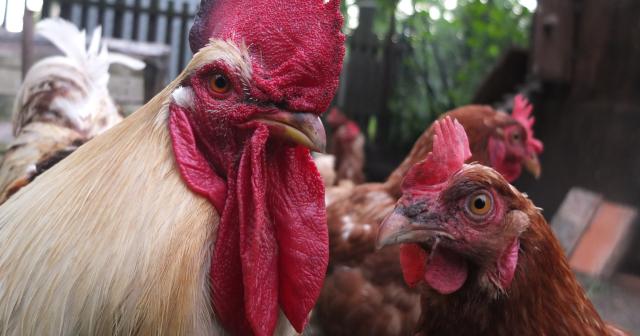
We would like to ask you to fill out this
QUESTIONNAIRE.
Your answers will be included in the planned online PDF publication of the CENSE Almanac, scheduled for November, 2021.
What is your personal attitude or interest in the idea and concept of Acoustic (or Sonic) Ecologies?
Can you comment on the relationship between electroacoustic music, sonic ecologies, bioacoustics and environmental activism in your field of expertise? Do you see common ground between these fields? Can you think of any examples or initiatives you are involved in?
What do you think about making use of de-contextualized field recordings (or other captured sounds) in contemporary music, such as publishing recordings or doing live performances with field recordings as source material?
Can you comment on the situation in your field of expertise concerning trans or inter disciplinary collaboration? What kind of and how much feedback is there between your work and the public? Are you satisfied with the level of audience for your work?
What could stimulate the involvement of broader public and policymakers to promote changes in environmental consciousness and the real life of the country in which you currently live?
Thanks in advance for your answers. Feel free to answer any, all or as many questions as you can.
Miloš Vojtěchovský / Polina Katchenka
Please send your responses by 30 August, 2021, to this adress: zvukac at centrum.cz.
CENSE dotazník výzva k účasti

chtěli bychom aby jste vyplnili tento
DOTAZNÍK
vaše odpovdi budou zahrnuty do plánovaného online PDF CENSE ALMANACHu
který vyjde na konci listopadu 2021
1. Jaký je váš osobní názor nebo zájem o myšlenku a koncept akustických (nebo zvukových) ekologií?
2. Can you comment on the relationship between electroacoustic music, sonic ecologies, bioacoustics and environmental activism in your field of expertise? Do you see common ground between these fields? Can you think of any examples or initiatives you are involved in?
3. Co si myslíte o vztahu mezi elektroakustickou hudbou, zvukovými ekologiemi, bioakustikou a ekologickým aktivismem ve vašem oboru? Vidíte mezi těmito oblastmi nějakou spojitost? Napadne vás příklad, přikladně iniciativy, do nichž jste zapojen(a)?
4. Co si myslíte o situaci ve vašem oboru, pokud jde o trans nebo mezioborovou spolupráci? Co vidíte jako zpětnou vazbu mezi vaší prací a odezvou veřejností? Jste spokojen se zájmem veřejnosti o vaši práci?
5. Co podle vás by pomohlo většímu zapojení široké veřejnosti a politiků do prosazování změn v povědomí o problémech prostředí a v reálném životě země, kde dnes žijete?
Můžete regovat na všech pět, nebo na tu, která vás oslovila nejvíc.
Předem děkujeme za vaše odpovědi!
s pozdravem
Miloš Vojtěchovský / Polina Katchenka
Odpovědi pošlete prosím do 30 srpna na adresu:
zvukac et centrum.cz
Regular Meeting of the Board
There are the key points we'd like to discuss this time:
- i-portunus grant – possibility to fund residencies
- Punctum radio & Radio Earth – CENSE participation
- CENSE Almanach – preparation process
- Theme Week Acoustic Ecology in Linz – November 29 – December 5, 2021
B PETRIFIED, Tidal Love — OR poiesis at Sound Gallery Igloo, Jihlava
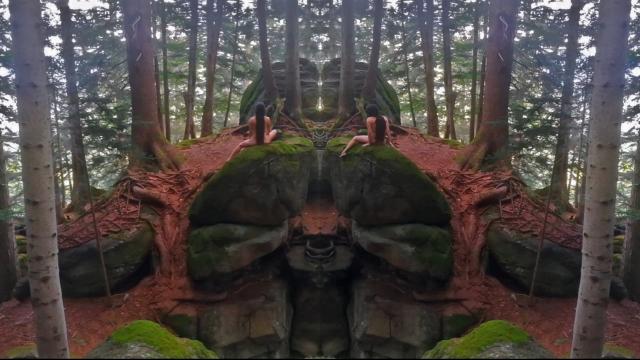
Sound Gallery IGLOO
Komenský Street No. 10
Jihlava
Curated by: Miloš Vojtěchovský
The prophecy for the future is hidden in the substance - we need to listen, dwell deep inside in order to understand, to predict. Seemingly deaf darkness of the substance is potent with knowing.
The inspiration for the work is an enigmatic, radically poetic place — a fascinating modular stone configuration in the Pohorje primeval forest in Slovenia. Intimate cosmic dialogue evolves through several visits and blossomed in-between bodies ∞ spirits: space, atmosphere, river, stones, trees, ants, shadows, light, and a woman.
Strange other(s) connects through performative engagement. Motionless stone beings with their eternal insistence on a single pose emanate a tidal field, gently and persistently attracting moving life forms. Camera (sound, video, photo) records subtle oscillations between different entities through their performative cohabitation. Artistic practice is based on durational performance with an emphasis on the descending ∞ expanding perception field. Through extreme sensual receptiveness developing an awareness of presence.
B PETRIFIED, Tidal Love offers an immersion into the process of attunement. Sonically it invites into the intermediate (sub)sonic substrate of minerals and fluids. Performative location: Pohorje primeval forest, river Lobnica, Šumik waterfall.
OR poiesis alias Petra Kapš (1975 in Slovenia) is a sound artist and poet, she lives in Maribor. She combines the art of sound, radio, chrono-spatial poetry, poetic performance, text and reflection. In addition to sound ephemerality, she also focuses on corporeality. Her main means of expression is a word extended to the field of sonic poetry. She is interested in auditory memory and deep, physical time. By using (a)synchronous presence in the digital sphere she opens up the concept of intimate radio. She also works with the emptiness of the Internet listener's hearing. Her sounds / radio / books and works are localized moments of solitude.
Framework radio #769: 2021.09.19 [CENSE]
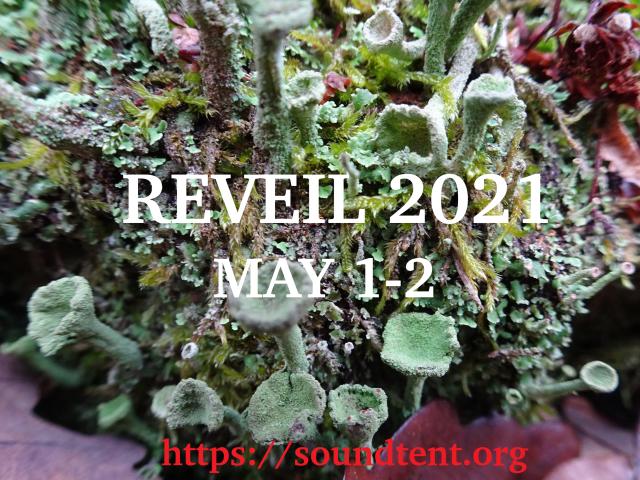
This mix was premiered by Radio resonance FM on 19.9. 2021
The recordings from this mix were made by CENSE members during the annual Reveil radio event, a 24-hour continuous live broadcasting which took place on May 3, 2021.
You will hear dawn choruses from Romania, Croatia, Hungary, Slovakia, Czech Republic, Austria, Germany, Ireland, Slovenia and Estonia. It was raining a lot this morning.
00.00 / framework:afield intro
01.20 / Anamaria Pravicencu / Gradina Cișmigiu, Bucharest, RO
03.29 / Csaba Hajnoczy / Felsotold, HU
07.20 / Tomas Šenkyřík / Rusava, CZ
13.28 / Ladislav Železný, Miloš Vojtěchovský & David Danel / Prague, CZ
17.48 / Michal Kindernay / Úpoř, CZ
26.38 / David Petráš & Jakub Juhas / Pezinok, SK
29.13 / Jan Krtička / Liberec-Radčice, CZ
31.31 / Šárka Zahálková – Lázně Bohdaneč, CZ
34.18 / Givan Bela / Tokyo, Hranice/Berlin, Kerminy
35.37 / Givan Bela / Tokyo, Hranice/Berlin, Kerminy
38.50 / Givan Bela / Tokyo, Hranice/Berlin, Kerminy
41.04 / Manja Ristić / Lenga quarry, Korčula, HR
44.44 / Polina Khatsenka / Danube, Traun, AT
44.26 / Slavek Kwi / Cappaduf, IE
46.19 / Slavek Kwi / Cappaduf, IE
50.43 / OR poiesis (a.k.a. Petra Kapš) – Maribor, SI
53.01 / John Grzinich / Varessaare, EE
57.20 / framework:afield outro
Reveil is a project organized by a group of UK sound artists and activists, Soundcamp, which has collaborated for the last 8 years with numerous institutions, public radio stations and initiatives around the globe. During the event, the open microphones from around the globe are accessible via Locus Sonus.org, an online platform for live streaming.
The Central European Network for Sonic Ecologies (CENSE) is an informal network of individual voices coming from various backgrounds. This emerging network aims to foster perceptive and conscious thinking and solutions, addressing developments in the social and cultural fields across Europe (and beyond), related to sound art, eco-musicology, and sound per se, while keeping a central focus on deep environmental and social changes.
Mix by Anamaria Pravicencu and Tomáš Šenkyřík. published as well at 1cense1.bandcamp.com
The Framework Radio produced by Patrick murmerings.com
A Meeting about the CENSE DAY at the Linz Conference
Discussing the program for the Linz conference.
Everybody is welcomed to join the zoom gathering
at 9 am Tuesday 28, September
link will be announced here
milos vojtech is inviting you to a scheduled Zoom meeting.
Topic: linz Time: Sep 28, 2021 09:00 PM Prague Bratislava
Join Zoom Meeting https://us04web.zoom.us/j/74090702466?pwd=L0ZQSG1waFFVUm5MYUdta0NTTXVsQT09
Meeting ID: 740 9070 2466 Passcode: z6zTYM
CENSE Collective on Radio Punctum: Emptiness
CENSE mixtape series is focused on bringing the field of acoustic ecology closer to the local listeners and interested individuals, introducing field-recordings as a sonic tool for examining our sound environment and enabling us to gain a deeper knowledge on the consequences of environmental processes, together with possible solutions retrieval. further info on the network can be found on the webpage
Online Meeting – Preparation for CENSE Day during Acoustic Ecology Week Linz
Anyone who is interested in participating in the event (actively or passively), or just would like to get to know more information is welcome to join.
CENSE meeting – Monday, October 4, 2021 @ 8pm (Prague time)
us02web.zoom.us/j/84766009077
meeting ID: 847 6600 9077
You can read all the notes in here: pad.monoskop.org/p/dayofcenselinz.
More info: cense.earth/acoustic-ecology-week-linz.
CENSE Day — Acoustic Ecology Week Linz

CENSE Day 2 December 2021
The event is cancelled or postponed due to circumstances
We would like to invite all the CENSE members, or others to meet there and discuss the further projects in future.
If you'd like to join the meeting, register through this form until October 15, 2021.
Statement: We live in a time of fast degradation of nature, social relations, economic engagement, political decisions, and general quality of life. If the first Lockdown in the spring of 2020 brought to the attention of the public the importance of quietness for the nature, in urban, rural, and open wilderness, the (acoustic) ecology is still a topic largely ignored by our governments, and it is not considered in any economic or political decision in the field of construction of our cities, exploitation of the natural resources, agriculture, and education.
The activists in ecology address mostly the visible dimension of the impact of human activities on nature mainly because there are very few accessible scientific resources and structured data that can show the evidence of the acoustic degradation of the environment, and therefore motivate a wider engagement of the public in the defense of it.
In Central and Eastern Europe, the cultural field is the main agent voicing the acoustic crisis of our environment, but the artists' impact without the support of the legislation, education, science, and finances cannot overcome the need of action that we are facing.
CENSE is inviting you to bring at the common table your ideas, knowledge, and resources to build together a stronger voice and to look for the means to be heard.
*If you still like to join the meeting, register through this form until November 15, 2021.
Preliminary Program (work in process) Common Signs and Symptoms
THURSDAY 2.12
PRESENTATIONS
11.00 – 11.20 Miloš Vojtěchovský / Jan Krtička WELCOME AND ALMANAC PRESENTATION
We have proposed a simple questionnaire about Acoustic Ecology, hoping that this will help us orient ourselves within the vast area of the “environmental acoustics of Central Europe.” We approached CENSE members and other interested people in Austria, former East Germany, Poland, Czechia, Slovakia, Hungary, Romania, Ukraine, Belarus, Slovenia, as well as Croatia, Serbia and Macedonia. All reactions, brief or at length, offer a springboard for the formation of a framework; a mind map composed of the various ideas, statements, positions, and attitudes of around thirty people. In addition, three short overviews on the story of environmental sound in Czechoslovakia, Poland and Hungary are included as an attempt to better understand local motivations and circumstances (20 min)
11.20 - 11.40 Abby Lee Tee/ Fabian Holzinger / – BEAVERS IN LINZ This presentation will give you an insight in their vocalizations and the sonic experiences they make inside their lodge, above and below the water. Beavers are fascinating ecosystem engineers – a keystone species being highly beneficial to numerous (endangered) animals, wetland rehabilitation and even vegetation, despite mostly just being known for felling trees (in autumn & winter). After being extinct for a century beavers got reintroduced to Austria in the 70ies and made their way to Linz in the 90ies. Beside being present in the city-surrounding marshlands of course they are also living along huge rivers like the Danube and near the center of the city, proving high resilience and adaptability. Just few people know about or experience their highly social family life and especially their (widely unexplored) vocalizations, being my main occupation while recording them for a year now. But living in urbanized areas generates numerous challenges for them too, with humans destroying their infrastructure or trying to displace them, as well as they are facing constant sonic disturbance living not far from highways on the shore of a large river with numerous big ships passing by – probably having a huge impact on a mammals mostly communicate and are guided by scent and sound. (20min)
Alongside his work in numerous collaborations and bands, Austrian musician Abby Lee Tee has been releasing a steady stream of constantly-evolving solo material since 2009; merging various influences from instrumental hip hop to electronica, and now finding himself in the cutting-edge world of experimental. Therein, he follows a natural instinct for playful narrative and continues to nurture a passion for field recordings and unusual instruments. His fascination for the divisions and crossovers between noise and music, as well as nature and culture, can be seen in his work with installations, sound-walks, sound design for theatre and audiovisual projects, as well as records on labels such as Shash, Czaszka, Dinzu Artefacts and Accidental.
abbyleetee.com
mail: abbyleetee@gmx.at
11.40 – 12.00 Anamaria Pravicencu - RIVERSSSOUNDS, A Model for International Collaboration, Production, and Reflection.
RIVERSSSOUNDS is a platform for virtual sonic experiences and an online residency program that hosted 16 monthly residencies from December 2020 until June 2021. By using digital tools and artistic imagination, it offers a virtual portal for connecting the physical realities of different cities through sound. Unites sound artists working with soundscapes and field recording, and each month it hosted up to three online residents from different European countries that are based in cities with a river. The residents created sound works reflecting the identity of the river in their cities. In addition, each resident held an artist talk, contributed to the sound library with field recordings of their river and a soundwalk. Сuratorial team: Zhan Pobe (DZESTRA, Ukraine), Anna Khvyl, Anamaria Pravicencu (SEMI SILENT, Romania) (20 min)
Anamaria Pravicencu studied sculpture and sound art at Ecole Nationale Supérieure des Beaux-Arts in Paris, and in 2001 received a scholarship at the School of the Art Institute in Chicago, Sound Department, supported by LVMH. Interested in working with space in site specific situations, her artistic practice was initially favoring architectural interventions and sound installation, and through the SÂMBĂTA SONORĂ program and the SEMI SILENT podcast platform, she increasingly presented sound compositions and performances. For SEMI SILENT, Pravicencu works also as a producer for pieces by Romanian artists and her own. In 2018, Pravicencu opened a program of individual and collective sound art residencies, SONIC FUTURE RESIDENCIES, whose productions are presented to the public through the SEMI SILENT podcast platform and public listening sessions.
riversssounds
semisilent
mail: anamaria.pravicencu@gmail.com
12.00 – 12.20 Anna Jurkiewicz / Jacek Szczepanek: REVERB ARTISTS
Reverb is an effect of the environment, that is multiple things coexisting. The perceived beauty of reverberated sounds takes us to special places. Singing with an open voice in caves means placing the relatively fragile human being in a barren, untouched, eternal setting. Using the voice to get response from a space allows us to grasp the volume of underground voids in a way that is beyond the reach of vision. It also juxtaposes the human experience of time with a non-anthropocentric, geological scale of time, in which Anthropocene and the entire history of humans is less than a blink of a nonhuman eye, not to mention the 7 seconds of reverb that we might experience as taking forever.
Jacek Szczepanek started his music education at the age of five in Warsaw and he was trained as a sound engineer in his early twenties in Cardiff. Since 2008 he's worked with sounds as an artist and as a professional. He's done field recording, sound design, editing, mixing and mastering, community art, performances, sound walks and workshops, sound libraries, installations, albums, DJing, and live engineering. He's appeared mainly in Poland, Czechia and Germany and he fears one day he'll fall in this pitiful open pit coal mine where these countries' borders meet.
jacekszczepanek.wordpress.com
annajurkiewicz.bandcamp
12.20 - 12.40 Peter Cusack / Udo Noll - radio.earth
radio.earth is a participatory radio project concerning the ecological crisis, its effects on our environment and ways of life and on the possibilities for action. The project aims to establish a network of collaboration between individuals and organisations interested and engaged in these subjects, with all their respective practices from art and science to activism. Among other practices, it encourages critical listening to live soundscapes from 1st to 3rd natures. In this context, 1st to 3rd natures refer to sites of various degrees of land usage and devastation, from wild nature to urban, industrial and agricultural zones. 3rd natures are rather cultural configurations, open and speculative and interwoven with the idea (and problems) of the Anthropocene. (20min)
radio.earth
radio.aporee.org
Peter Cusack
12.40 - 13.00 Tomáš Šenkyřík - WHAT SOUNDS BEHIND OUR DOORS, Green projects in Židlochovice
What kind of sounds are outside and how we can influence them with our activities? How can we influence biophony? How can people contribute to such goals in their garden? And how can subjects, such as the municipality, influence soundscapes of its surrounding? I will try to answer these questions in my presentation. (20 min)
Tomáš Šenkyřík (1972) is a musicologist with interest in field recordings, in acoustic ecology and in discovering musical structures in nature. He likes listening to nature without noise pollution, especially fragile and quiet sounds. From 1999-2008 he worked in the Museum of Romani culture as an ethnomusicologist. He is a member of association Skupina, an artist group interested in field-recordings, soundscape, oral & aural history, acoustic ecology. Tomáš is living and working in Židlochovice, a town south of Brno, Czech Republic.
soundscape.cz
zidlochovice.cz
soundcloud.com/tomassenkyrik
13.00 - 13.20 Margarethe Maierhofer-Lischka - HOMESOUNDS
Homesounds is a participatory soundscape-streaming/listening project that has seen its first iteration this July at a festival in Porto with people from about 7 countries participating, and subsequently has expanded into a series of interventions. I will take this project as a starting point to reflect about technically mediated (online) listening and technosonic ecologies, incorporating cyberfeminist thought as well as findings from my PhD research on listening that I concluded at KUG Graz.
Margarethe Maierhofer-Lischka (1984) is a double bassist, improviser, researcher and sound artist. Besides being an active ensemble musician, she collaborates with artists from all fields, creating performances, radio art and sound installations. She is a member of several initiatives for contemporary music, improvisation and interdisciplinary art, among which are Ensemble Schallfeld, v:nm, mur.at and IMA – Institute for Media Archaeology. Her work has been supported by scholarships of the Austrian Federal Government, the DOMS Foundation Basel and the Karlheinz Stockhausen foundation. In 2018 she received the Theodor Körner award for arts & science.
OR poiesis - YAMAMAYU + TERRITORY
YAMAMAYU is a bio-acoustic sound-research project centring on the sonority of the Japanese oak silk-moth, a nocturnal moth that, between the middle and the end of the 19th century, successfully assimilated in Slovenian and other parts of continental, south-eastern Europe deciduous forests. These forests have pronounced annual cycles and, at least until recently, prominent temperature amplitudes between summer and winter. Poetic approach to the research arose from the life cycle of a yamamayu and night forest wanderings. The aspiration is the artist’s fascination with dislocated nocturnal poetic sonorities. TERRITORY is dedicated to research and live sound transmission of night forest and urban territories in online environments (radio.earth), including performative interventions (ultrasound field, echolocation, bats and night moths, voice, night ambiences). The concept of the invisible into the audible is evolving with the growing need for sophistication of auditory perception and the polymorphism of the audible.
Petra Kapš alias OR poiesis (1975) weaves her work among the arts of sound, radio, chrono-spatial poetry, poetic performance, books and reflection. Aside from the ethereal features of sound, she focuses on the physical presence of the body. She extends the word, her core medium, with sonic spheres of sonorous poetry. Kapš is interested in aural memory and the deep time of the body. Incorporating an (a)syntemporal presence through the digital sphere, she researches the possibilities of intimate radio and is concerned with the void ear of the internet listener. Her sound/radio/book works are located solitudes.
13.20 - 14.00 OPEN FORUM
Jan Krtička,
Šárka Zahálková,
Darko Fritz,
Gertrude Moser Wagner / Wally Rettenbacher
15 – 18 Gatherings and Discussions
Panel discussion on the contemporary relevance and impact of acoustic ecology in our regions
Curated by Csaba Hajnóczy (Hu) and Jakub Malinowski (PL)
Moderation: Sam Auinger (tbc)
Participants: Peter Cusack (tbc), Csaba Hajnóczy, Petra Kapš (tbc), Jakub Malinowski, Anamaria Pravicencu, Miloš Vojtěchovský, etc.
Evening program, tbc.
Carina Pesch – LIVE ABANDONMENT - A PERFORMANCE
Carina Pesch (1983), aka La Pesch, studied Social Anthropology, Political Sciences, and Philosophy at the University of Leipzig and at the Orient Institute Beirut. In high school she started to write short stories and articles for the local newspaper. Than she found her way to radio, acoustic narratives, and sound art. She was fascinated by the extra dimension that sounds and voices add to storytelling. During her journeys and field studies she discovered the world with all its corners, layers, and rough edges. She was trained as voice artist by Alexis Krüger, taught how to make radio features by Michael Lissek and Walter Filz, making ”Hörspiele“ (radio plays) she learnt from Krok & Petschinka, Tim Staffel, and Paul Plamper, sound art she learnt from Antje Vowinckel, Peter Cusack, Chris Watson, Hans Peter Kuhn, Christina Kubisch and others.
About the event Listening is a (creative) act, a process of reality formation. Every human being creates his or her own acoustic reality. John Cage begins his text The Future of Music: Credo (1937/1958) programmatically: “Wherever we are, what we hear is mostly noise. When we ignore it, it disturbs us. When we listen to it, we find it fascinating.” Fascinating, because our creative power is challenged. And not virtually, but genuinely as the ART OF LISTENING.*
Activities
- Open workshops
- Sound walks
- Radio
- TV
- Online Events
About the organizers
Soundinglinz.at considers the city as being a body of sound made up of countless instruments. It is a continuously renewing and writing composition. The ongoing changes in the city are documented, commented on and recorded on a map of Linz. Everyone is invited to explore the Upper Austrian capital acoustically with their own ears and share their experiences. Field recordings, videos, photos, texts, sound walks and podcasts can be assigned to every possible location in the city. Hundreds of people from near and far have posted so far and over 50,000 people have visited the platform. They accessed the sounds, texts, photos and videos that capture the city’s soundscape more than a million times over.
At the same time, soundinglinz.at serves as a permanent research platform with a participatory agenda for the newly founded Co.Lab Acoustic Ecology at the Linz University of the Arts. This ensures the continuous development of the project.
soundinglinz.at is a 21st century work of art: ecological – participatory – sustainable.
Sonic Turn: “Sound Studies” and the Other History

VIDEOGRAM 108 / TIM Master Class: Anna Kvíčalová
Online event autumn 2021
It is hard to imagine scientific research without the use of pictures, graphs, and diagrams; Western culture has been repeatedly characterised as visual since the invention of the printing press; we are likely to believe what we have seen "with our own eyes". But is there knowledge that we can only gain through specific listening techniques? Does hearing have a history of its own? Can we study sound before the era of its technological reproduction? In my talk, I will introduce “sound studies” as a field of interdisciplinary historical research and explain how and why to engage with the history of sound and hearing. I will show, for example, how the study of indigenous cultures in Papua New Guinea has contributed to a better understanding of the history of European science, explain what "historical hearing" and the cultural history of the senses are, and show what the study of hearing and acoustics reveals about the formation of modern science and culture at the intersection of natural, social and artistic disciplines. I will present the history of sound as an alternative history of modernity, using examples from the context of the European Reformation, 19th century physiology, acoustic ecology, and research of "voice prints".
Anna Kvíčalová is a historian of science, religion, and the senses; in her work she deals with the history of sound and hearing. She works as a research fellow at the Centre for Theoretical Study (Charles University and the Czech Academy of Sciences) where she is the leader of the research project The Second Sense: Sound, Hearing and Nature in Czech Modernity. She received her MA from the University of Amsterdam and a PhD from Freie Universität Berlin; between 2013-17 she worked as a research fellow at the Max Planck Institute for the History of Science in Berlin. She is the author of Listening and Knowledge in Reformation Europe (Palgrave, 2019) and other texts on sound, hearing and acoustics. She is also an Assistant Professor at the Department for the Study of Religion at Masaryk University, Brno.
The lecture will take place online through the ZOOM platform.
The lecture will be held in English.
https://cesnet.zoom.us/j/94113388164
Meeting ID: 941 1338 8164
The lecture is a part of the online course TIM Master Class taught within Theory of Interactive Media MUNI and also part of the series Videogram at FFA BUT under the auspices of Department of Audiovisual Technology. Further programme at www.videogram.favu.vut.cz
CENSE Collective on Radio Punctum: Elements, episode 1

This is a reminder of an upcoming broadcasting of the 2nd episode from Elements series, that Polina Katchenka is preparing together with Petra Kapš. We will also have a custom generative graphics for each episode from our Teplice-based colleague and a graphic designer Petr Hanžl.
Thanks to everyone who decided to contribute their recordings!!
we've received great content from all of you! It's an horror to work with you all.
Tune in on https://radiopunctum.cz/ at 20h CET.
or
listen to the podcast here:
CENSE on Radio Punctum – Symptoms of Evidence - Earth

4th issue of the radio program SYMPTOMS OF EVIDENCE
EARTH is an episode in the ELEMENTS series for Punctum radio.
This time the mixtape show was put together by magnificent OR poiesis, with contributions by Slavek Kwi, Martyna Poznańska, Peter Cusack, Anamaria Pravicencu, Alëna Korolëva, Udo Noll, Milos Vojtechovsky, Lloyd Dunn, Patrick Tubin McGinley, Audrius Simkunas, OR poiesis, Michal Kindernay, Šárka Zahálková and Manja Ristić.
The fourth episode is an invitation to rethink what we have built over time and it is a poetic contribution to the fundament of us all - The Earth.
The PUNCTUM mixtape shows are co-produced by Polina Khatsenka. A visual collage for the show includes images by Martyna Poznańska, Michal Kindernay and OR poiesis.
Live please tune in on radiopunctum
No. 3 Psychogeography
Symptoms of Evidence: The third episode of Symptoms of evidence by CENSE is prepared by Polina Khatsenka and OR poiesis – Petra Kapš. Series is reflecting the current situation dealing with sound, environment and perception. Third episode will take you for a walk to explore "psychogeography".
Psychogeography, as the term suggests, is the intersection of psychology and geography. It focuses on our psychological experiences of the city, and reveals or illuminates forgotten, discarded, or marginalized aspects of the urban environment.
Both the theory and practice of psychogeography have been around since 1955, when French theorist Guy Debord coined the term. While it emerged from the Situationist International movement in France, the practice has far-reaching implications. It’s relevant, for instance, in Prague, Bucurest, Wroclaw, or Kišiněves.
Recordings by
- Šárka Zahálková
- Miloš Vojtěchovský (an aporee walk)
- Katrinem
- Udo Noll
- Peter Cusack
- Tomáš Šenkyřík
- Irena Pivka
- Yorgis Sakallariou
- Polina Katchenka
- Bálint Kiss
- Martin Marek
- Boris Klepal
- OR Poesis
- Mat Eric Hart
Thanks to everyone who decided to contribute their recordings, we've received great contributions! Thanks to all participating and listening! And big thanks to Polina Khatsenka for putting together the radio show.
Twillight/Dawn: REVEIL 9 — open call for streams

Cense Network invites you to take part this year again in the collaborative planetary streaming and listening project REVEIL 9.
Soundcamp 2022 is a festival of the project Acoustic Commons and Full Of Noises + Locus Sonus + CONA + HMU + Cyberforest network From Saturday, 30 April 05:00 UTC+1 until Sunday, 1 May 06:00 UTC+1
Main physical space is at Stave Hill Ecological Park in London
Check the list of soundcamps around the globe
LIST OF some CENSE STREAMS
- Tomáš Šenkyřík:::Židlochovice Sounds from my garden
This year I broadcast from our garden to point to the level of bioiversity. We designed the garden so that it is friendly to birds and insects. Every year, common starlings nest in an old apple tree. The garden turtle nested on an old apricot for the first time. Or for the first time, a common redstart nested in an old drainage pipe.
- Tomáš Šenkyřík ::: Brno Park Lužánky
Since March 2021, we are broadcasting from Lužánecký Park in Brno continuously via locus sonus
- Sonicity::: Černý most - Praha
sonicity.cz is mapping soundscapes of Prague since 2008. The Prague Soundcamp 2022 is related again to the Bio Troja project, but the location is rather unstable. Lets hope it will work out in Black Bridge. sonicity.cz homeradio CENSE Bohemian Unit
Jan Krtička, Polina Khatsenka ::: Löblhof & Artgrund Löblhof & Artgrund is a cultural space in the countryside of Northern Bohemia. Backed up by phonon~ crew a group of sound enthusiast from Faculty of Art and Design JEPU are going to set up a stream in the hills next to the site. Stream will be accompanied by a Saturday program: a movie projection, sound walking and a field-recording session.
John Grzinich Taavi Suisalu, Veljo Runnel, EKA students ::: Remote Estonia Põlva
This year we will be making a small sound camp at a 'forest hut' in the Kiidjärve–Kooraste Recreation Area of Põlva county in south Estonia. The camp will involve artists, naturalists and students from the Estonian Academy of Arts. The soundscape will include fauna from the nearby bogs and lakes.
- Carina Pesch/Geräuschkulisse:::Leipzig
Sunday 5:05 to 5:43 a.m. We are going to stream during sunrise with Chris Watson and the participants of our CATCHING SOUNDS II workshop for Soundtent and Reveil 9 – an acoustic circumnavigation of the earth for dawn chorus day, 24 hours songs for sunrise once around the globe. With Chris Watson, Emilie Wright, Guy Fixsen, Ana Roman, Laura Dng, Lefteris Krysalis, Rupert Jaud, Markus Andreas, Connie F Müller, Frank Schubert, Alejandro Weyler, Fiona Patten, Katja Stamm, Daniel Fischer, Hendrik Walcher, Patrick Franke, Lena Löhr, Martina H. Weber, Clemens Pitschke, Carina Pesch. CATCHING SOUNDS program
- Brane Zorman::: Molat island, Croatia
Facing north from Jazi beach one can see Island Pag and Velebit mountains. As such it is very often to hit by strong northern bura (bora) winds from Velebit, and offering shelter from south "jugo" winds. Molat-Zadar program CONA
- unosonic - udo noll ::: Berlin
The near-natural Königsheide is a mixed forest, mainly consisting of oaks and pines. Originally it was connected to the Köllnische Heide. Königsheide serves as a popular local recreation area for the population of Treptow-Köpenick and Neukölln. However, the characteristic woodland and heath areas also represent an important natural habitat for rare plant species. To the north is the imposing former GDR children's home Makarenko, which is now used as a residential building. radio.earth, field radio
- Peter Cusack ::: Das Nasse Dreieck, Berlin
Das Nasse Dreieck (The Wet Triangle) - formerly part of Berlin Wall death strip - is a rather hidden green space bounded on two sides by busy rail lines and and on the third by well fenced allotments. The entrance is tucked away out of easy sight and one gets the feeling that only locals know it. Kids play here after school - there is a great climbing tree - otherwise it is a dog walking domain. As the name suggests the ground is pretty soggy, pools form at the slightest suspicion of rain and footsteps squelch. Clumps of low trees and thorny bushes are home for chattering sparrows, crows, magpies. Trains sing or rumble past, distant building sites and bells sound from afar. Over time the presence of close birds, sub base freight trains and the distant city gives every possible mix from urban soups to transparent spatial perspectives. Das Nasse Dreieck
- Guy van Belle :::mobile - kra, Vysočina, Bohemia,
KRA stands for the future in ecology, art and media. To build this, KRA is inviting (not only) artists from various disciplines, working with various tools and media (low-power electronics, sound and music, performances, texts of all kinds presumably experimental, architecture, plants, images, mud grass and other objects, from micro to macro and beyond. We expect activities, which (have to) lead to a finished installation, an exhibition, or any artwork, but that are related to a new kind of presence in the environment. Something avoiding intrusiveness but unseen before altogether mobile_kra.ogg
- Michal Kindernay ::: Skryje radio, Bohemia
The characteristics of the sound are notably rural with a large variety of natural sounds including many birds - a rare White-tailed eagle nests on the rocks below the house in the valley, just above the Berounka river. The area around the village is protected and so a lot of unique species are present. You might also hear insects, cattle, dogs, horses and the sounds of a colorful village life. There is a strong dynamic contrast between daytime and nighttime sounds and a sense of sense of depth - in the foreground you will hear sounds of the farm and in the background sounds of the village and a valley in which a small river runs. In a sense this soundscape says a lot about rural areas in Czech Republic in general; areas which are rich in terms of natural sounds but often disturbed by the noise of traffic or agriculture machinery. Skryje radio
- Slavek Kwi - uni.sol, County Clare, Ireland
uni.Sol_initiative is aspiring to be all-inclusive and ever-evolving project exploring the potential of extrasensory communication in purpose to facilitate deeper connection in between all entities. An intention to explore and implement the idea of freedom, to enhance an awareness of human relationship with surrounding environment through practice of listening. introduction
Petra Kapš ::: Slovenia
Anamaria Pravicencu / SEMI SILENT ::: Cișmigiu Garden, Bucharest, Romania
The streaming is made during a public listening session followed by a discussion with Georgian Constantin, an amateur ornithologist, bird photographer, and neighbor. Event organized together with Cișmigiu Civic Initiative
Reveil makes a 24+1 hour loop of earth, travelling west on live audio feeds sent in by streamers at daybreak from their locations.
Reveil brings city yards, remote rural sites, fresh and salt water bodies into communication, creating a collective audit of planetary soundworlds over one earth day.
For details on running a stream with a phone, laptop or Raspberry Pi, see Stream
To let us know you're joining, please sign up. You can also go ahead and create a stream page, which will be featured during the broadcast and join the Reveil archive.
We look forward to your sounds.
Reveil will be mixed by Fernando Godoy (Tsonami, Chile), Leah Barclay (Biosphere Soundscapes, Queensland) and Maria Papadomanolaki (Soundcamp, Crete). Reveil is assembled at Stave Hill Ecological Park (TCV) in London from 05:00 UTC+1 on Saturday 30th April to 06:00 on Sunday 1st May.
Streams are available on the Icecast server and public soundmap by Locus Sonus (ESAAIX). The main feed is hosted by Wave Farm WGXC in Acra NY and broadcast over 20+ FM and net radio stations around the world. Our broadcast partner in London is Resonance Extra.
Reveil 9 is produced with the Acoustic Commons network:
For details see: soundtent.org
links:
Soumrak/Rozbřesk: REVEIL 9 — výzva k účasti na vysílání

Cense Network zve k účasti na jednodení společné planetární vysílání Soumrak/Rozbřesk, neboli REVEIL č.9.
"Den naslouchání ptačímu zpěvu" bude pravděpodobně v na zahradě AZYLOVÉHO DOMU PRO ŽENY ŠROMOVA, ADRESA: Šromova 862/3, Praha 14, ČERNÝ MOST.
!!Aktualizovany přehled míst vysílání je jen na anglické verzi!!
Reveil je 24+1 hodinové zvukové pásmo živých vysílání kolem zeměkoule a posunuje se během jednoho dne v noci poslední den v dubnu a první den máje směrem na západ.
Reveil je dialog mezi dvorky, venkovskými lokalitami. Je to kolektivně vytvořené pásmo planetárních zvukových světů za jeden den.
Podrobnosti o tom jak spustit stream s pomocí telefonu, počítače nebo Raspberry Pi najdete zde Stream
Chcete-li nám dát vědět, že se zapojíte zaregistrujte se zde.
Můžete také pokračovat a vytvořit si stránku streamu, kde bude vysílání, které se připojí k archivu
Těšíme se na Vás i na zvuk Vašeho okolí posledního dubna
Hlavní signál vysílání Reveil budou mixovat Fernando Godoy (Tsonami, Chile), Leah Barclayová (Biosphere Soundscapes, Queensland) a Maria Papadomanolaki (Soundcamp, Kréta).
Hlavní tábor Reveilu je znovu v Ekologickém parku Stave Hill (TCV) v Londýně, kde bude program od v sobotu 30. dubna 05:00 UTC+1 do 6:00 neděle 1. května 2022.
Stream najdete na serveru "Icecast" a na veřejné zvukové mapě Locus Sonus (ESAAIX). Hlavní stream spravuje Radio Wave Farm WGXC v Acra stát NewYork a vysílání přebírá řada FM rozhlasových stanic po celém světě. Vysílacím partnerem v Londýně je radio Resonance Extra.
Reveil 9 je provozován díky síti Acoustic Commons, které propojuje iniciativy Full Of Noises v Anglii, Locus Sonus ve Francii, CONA v Slovenii, HMU, a Cyberforest v Japonsku.
Další podrobnosti najdete zde: soundtent.org Pokud se zapojíte, vyplňte krátký formulář
Projekt Soundcamp vítá případnou finanční podporu.
Odkazy na různé články a minulé programy:
SEZNAM CENSE VYSÍLACÍCH MÍST:
Tomáš Šenkyřík: Sounds from my garden Židlochovice
Tomáš Šenkyřík: Park Lužánky Brno
Troja Garden, Prague, CENSE Bohemian Unit
The Second Life of Recorded Sounds, 2020 publication
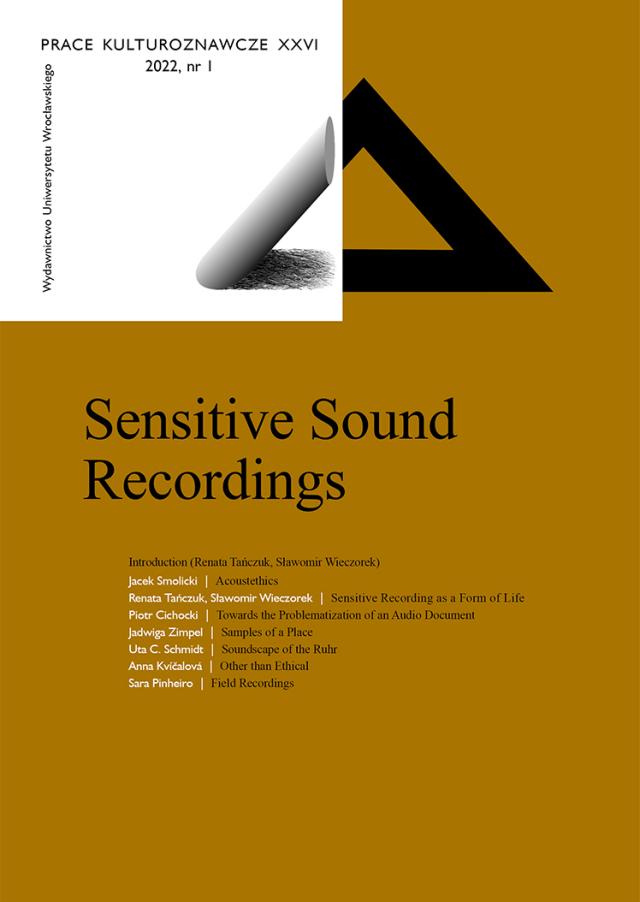
We are happy to announce that the publication “Sensitive Sound Recordings” after our online meeting in Wroclaw from 2020 was just published (now on-line, very soon on-paper).
“We define sensitive sound recordings as ones linked to the experiences of trauma, exclusion, and injustice of those whose voices were recorded, as well as the communities to which they belonged. They are correlates of the ‘sensitive heritage’ and sometimes the ‘difficult heritage’ of communities. Broadening the scope of the term ‘sensitive recordings’ in relation to the above-mentioned definition, we could also include recordings that violate taboos, for example, some cultural contexts, recordings of religious ceremonies “or intimate situations”.
“Click, browse, like, share, save, listen!”
Renata Tańczuk, Sławomir Wieczorek
Authors and Editors
Introduction
In 2020, the Soundscape Research Studio, the Institute of Cultural Studies, the Institute of Musicology at the University of Wrocław, and the Central European Network for Sonic Ecologies organized the international academic conference The Second Life Of Recorded Sounds online conferencedevoted to the reuse of archival, non-musical recordings in academic research, artistic practices, as well as in ecological and political activism, and education. The use of sound recordings for purposes other than those for which they were originally recorded raises questions about their identity, instrumentalization, and the transformations they undergo in new cultural, social, and political contexts. There is a need for critical reflection on the recording process itself, which can be seen as a form of appropriating the heritage of colonized and marginalized communities, and on sound technologies as instruments for perpetuating and reproducing colonial power and racism.
The conference papers dealt, among other things, with ethical issues related to sound recording, listening to recordings, and re-mediation. Research focused on biographies of problematic sound legacies, for example wiretaps or recordings made in colonial contexts and in prisoner-of-war camps during World War I. Presentations on ethical issues related to the collection and use of recordings, for example in the context of bio- and necropolitics, as well as the decolonization of sound archives and the politics of collecting, inspired us to reflect on “sensitive sound recordings.” By defining the object of our interest in this way, we also invoke the notion of “sensitive heritage,” which appears in discussions on museum collections of artifacts from outside Western culture and their restitution.
In our article presented in this issue of “Prace Kulturoznawcze”, we define “sensitive sound recordings” as ones linked to the experiences of trauma, exclusion, and injustice of those whose voices were recorded, as well as the communities to which they belonged. They are correlates of the “sensitive heritage” and sometimes the “difficult heritage” (S. Macdonald) of communities. Broadening the scope of the term “sensitive recordings” in relation to the above-mentioned definition, we could also include recordings that violate taboos, for example, in some cultural contexts, recordings of religious ceremonies or intimate situations.
Such recordings, sometimes because of the manner and context of their creation, confront the listener and user with a whole spectrum of complex problems related to the right to collect, dispose, and listen to them, as well as the social, political and ethical consequences of their reuse in research, educational, and artistic practices. Approaching the recording as a form of life and analyzing its biography allows us to grasp its social causality and transformation.
“Sensitive sound recordings” refer to “difficult” and “moving” recordings that evoke affects and emotions. They constitute a kind of “sensitive heritage” of communities, and sometimes also a problematic heritage, such as recordings of wiretaps. “Sensitive recordings” do not allow listeners to be indifferent; they demand from their users, who include researchers, a responsible, caring attitude.
The concept of acoustethics proposed by Jacek Smolicki, which emphasizes the need for a reflexive approach to sound recording (a complex process that always takes place in an area understood as a space of diverse and non-obvious relations between acting and interacting actors — human subjects, technology, places, etc.), takes into account the specificity of sensitive recordings.
Sensitive sound recordings not only evoke afective and emotional responses, but are also capable of conveying the affective dimension of particular places and entering into a complex and dynamic relationship with meta-comments about themselves. This causality of recordings is captured in an interesting way by Jadwiga Zimpel, amu.academia.edu who wonders about their status as an element of the cultural heritage of cities. The problem of transforming a recording into a cultural heritage correlate is, in turn, taken up by Uta C. Schmidt, a co-founder of the Ruhr Sound Landscape Archive.
Recording, storing, listening to, and using sound recordings are cultural practices of great political significance. In times of modern surveillance techniques, wars, and migration, the political entanglement of recordings and sonic big data becomes an issue that should be carefully examined. In this volume it is raised by Sara Pinheiro by posing a series of questions not only about the political nature of sound, but also about the political agency of field recording.
A different perspective on the approach to sensitive recordings is outlined by Anna Kvíčalová. The author focuses on the production processes of new knowledge about sound and formation of new listening techniques that take place in fonoscopy laboratories during the analysis of recordings from security service wiretaps.
Conference Participants
Dariusz Brzostek (Nicolaus Copernicus University, Toruń)
Anna Maria Busse Berger (University of California, Davis)
Piotr Cichocki (University of Warsaw)
Anna Markowska (University of Wrocław)
Uta Schmidt, Richard Ortmann (University of Duisburg-Essen)
Michał Witek (University of Wrocław)
Jadwiga Zimpel (Adam Mickiewicz University, Poznań)
Antoni Michnik (The Institute of Art of the Polish Academy of Sciences, Warsaw)
Jacek Smolicki (Linköping University)
Jarosław Jaworek (Adam Mickiewicz University, Poznań)
Anna Kvíčalová (Charles University, Prague)
Csaba Hajnoczy (Moholy-Nagy University of Art and Design, Budapest)
Paweł Szroniak (Wrocław Contemporary Museum)
Beata Anna Targosz (Berlin)
Michal Kindernay (Prague)
Pedro Oliveira (Helsinki Collegium for Advanced Studies, 2021)
Magdalena Zdrodowska (Jagiellonian University, Cracow)
Hans Ulrich Wagner (Leibniz-Institute for Media Research, Hans-Bredow-Institute, Hamburg)
Sara Pinheiro (CAS/FAMU Prague; University of Bangor)
Renata Tańczuk (University of Wrocław)
Sławomir Wieczorek (University of Wrocław)
Jan Krtička (Jan Evangelista Purkyně University, Ústí nad Labem)
Julius Fujak (Constantine the Philosopher University, Nitra)
Daniel Brožek (sound art curator, Wrocław)
OR poiesis (alias Petra Kapš) (Maribor)
Gerard Lebik (Sanatorium of Sound, Sokołowsko)
Online publication: https://wuwr.pl/pkult/issue
Conference: The-Second-Life-Of-Recorded-Sounds-online-conference
Beyond Listening: Agency, Art and the Environment
International Symposium on Sonic Ecologies
21 to 25 November, 2023
Moholy-Nagy University of Art and Design Budapest (MOME)
The aim of the conference is to provide a transdisciplinary forum for the achievements in recent years and to foster further exchanges, communication and networking during the years to come. We would like to pay special attention to the region of Central Europe, but the geopolitical range of its subjects remains open to the broader world.
General Information about the Symposium
Programme: 21 to 25 November, 2023
Installations (ongoing)
Tuesday 21 November — Welcome
19:00–20:45 Listening session I
Wednesday 22 November — Presentations
10:00–11:00 Keynote: Budhaditya Chattopadhyay: Post-immersive Listening: Perspectives on the Mediation of Sonic Environments
11:00–11:30 break
11:30–12:00 Ida Hirsenfelder: Empathic Atmospheres. Sonic stories for a sensitive cohabitation
12:00–12:30 Piotr Kędziora Something fragile. Ambient listening & background musics qualia
12:30–13:00 Maja Bjelica: Experiencing Listening: Essay in Environmental Ethics of Care
13:00–14:00 lunch break
14:00-14:30 Kristine Diekman and Ben Pagac: Secret Reception
14:30–15:00 Liz K. Miller: Listening with Diagrams
15:00–15:30 Julius Fujak: Sonic Environments as the Mirror of Culture (As A Challenge for Artistic Testimony)
15:30–16:00 break
16:00–16:30 Polina Khatsenka: Elbe_Labe
16:30–19:30 break and dinner
19:00–20:45 Listening session II
Thursday 23 November — Presentations
10:00–11:00 Keynote: Gascia Ouzounian: Death Cities: Hearing Atmospheric and Spatial Violence
11:00–11:30 break
11:30–12:00 Martin Heslop: Sound Sanctuaries
12:00–12:30 Bálint Kiss: Sound, Noise, and Master Plans
12:30–13:00 Shluk: Noise Pollution and Sound Beyond Sound
13:00–14:00 lunch break
14:00–14:30 Jan Solčáni: Envisioning Possible Futures Through Sound Mapping: House of Culture Družba
14:30–15:00 Magdalena Manderlová: Kozmic Sounds (Bird Reserve)
15:00–15:30 Sam Auinger and Peter Cusack: Braunschweig hört sich zu
15:30–16:00 break
16:00–16:30 Ari Koivumäki: Implementing Comfortable Soundscapes in Urban Spaces
16:30–17:00 Gabi Schaffner: Datscha Radio: Radio as Experimental Ethnography
17:00–19:30 break, dinner
19:00–20:45 Listening session III (8-channel)
Friday 24 November
Workshops
10:00-13:00Soundcamp collective: Streambox Workshop
for 12 participants. (Bring your own laptop and headphones).
10:00-12:00Henry McPherson: Towards Ecological Improvisation: Listening with the Body — 10-15 participants. See details.
Details
If participants would like to bring something to sound on/with (an instrument, an object, etc.) they are very welcome. Depending on space available, it might be nice to go outside, so I advise that people wear clothing they are comfortable in. Technically, it would be useful to have some chairs that people can sit on if needed.
13:00-15:30Melissa del Carmen Ernstberger & Luka Laval: Sonic Carthography workshop
10-12 participants. (Bring laptop or phone and headphones).
13:00–15:00 Jacek Smolicki: Soundwalking through time, space and technologies
15:00–16:00 Sam Auinger / Peter Cusack: Soundwalk
16:00–17:00 Workshop summaries for all workshops (Film Studio)
17:00–19:30 break, dinner
19:00–20:45 Listening session IV (cube 8-channel)
Saturday 25 November — Presentations / Closing Day
10:00–11:00 Keynote: Jacek Smolicki: A walk in the forest
11:00–11:30 break
11:30–12:00 Abby Lee Tee: Beavers in the City, Their Vocalizations and Human Noise
12:00–12:30 Georgios Varoutsos: Sounding Covid-19
12:30–13:00 Hannah Kemp-Welch: Listening Pedagogies for Community-based Art
13:00–14:00 break
14:00-14:30 Hanna Grześkiewicz: Sounding Borderlessness in the Białowieża Forest
14:30–15:00 Guillaume Loizillon: Territories
15:00–15:30 Ramon De Marco: Klangweg Toggenburg
15:30–16:00 Eric Leonardson: Summary of 2023 WFAE Conference
16:00–17:00 Round table: How to Activate Ecology of Sound Beyond Listening?
- Grant Smith, Peter Cusack, Ida Hirsenfelder, Mary Edwards, Csaba Hajnóczy, Hanna Kemp-Welch, Eric Leonardson, Jacek Smolicki, Csaba Hajnóczy, Ramon De Marco, and others..moderated by Miloš Vojtěchovský
Support
The project is supported by the Visegrad Fund
Partners
Jan Evangelista Purkyně University in Ústí nad Labem, Faculty of Art and Design
Institute of Cultural Studies, University of Wrocław, The Soundscape Research Studio
Constantine the Philosopher University in Nitra, Department of Cultural Studies, Faculty of Arts
Moholy-Nagy University of Art and Design Budapest, Media Institute
Open Call for Visegrad Fund Visual and Sound Artists Residencies
Artists, and everyone to whom it may concern:
As you might have seen already, the Visegrad Fund call for Visual and Sound Artists Residencies are open.
The Deadline to apply is 15 October 2023. You have to apply personally as an artist for this, and come from PL, SK, HU.
If you are interested in coming to KRA Vysočina (Kravín Rural Arts), please send a proposal and we can provide you with the necessary documents, like a letter of acceptance etc.
We usually accept residencies for summer (June till October).
More information on our activities you can find on the website.
For 2024 we are looking for artists who are interested in bioacoustics of water soundscapes (ponds, rives, ditches, rains, etc) and species monitoring via ultrasonics (bats, crickets, mice, etc). We are setting up a program combining citizen science and creative performances. Those are big words but let's keep it simple and if you like to expand your field recordings in those areas, feel welcome and join in with or contribute to the Summer of the KRA program 2024. It is a nice depopulated area around here, in between protected natural and agricultural areas.
Something general:
KRA (kravin rural arts, https://kra.land) is installed in a historical building, or old neglected farm, or simply: a ruin. We invite artists to work experimentally with ecology and technology, from within the countryside, in a natural environment. Apart from these residencies, we host an alternative music festival (on/off) and organize presentations, performances, participations. During the korona years, we set up ButtuLab.Space as an incubator for introducing new digital skills (3D design/print, audiovisual, radio, networks, ...) as a creative collaboration between the local social and artisanal, media and co-working, biofarming, leisure and learning places. KRA participated in international art-science and media art festivals/initiatives throughout the year (Réveil, Nextfestival, World Listening Day, Cultural EU Capital Esch art radio, Art's Birthday, and more things you know better). We also have contacts with sister-initiatives throughout Europe through the PAN network, and of course: CENSE! KRA's overal mission is to establish a shared infrastructure and contribute to the development of a liveable, critical and creative, environmental 21st century countryside. Sustained nearby, and connected elsewhere around. The New Rural Development: Let's make it (DIY)!
Location and activities:
IVF CALL information:
KRA contact: hinterland@kra.land
Beyond Listening Symposium: General Information
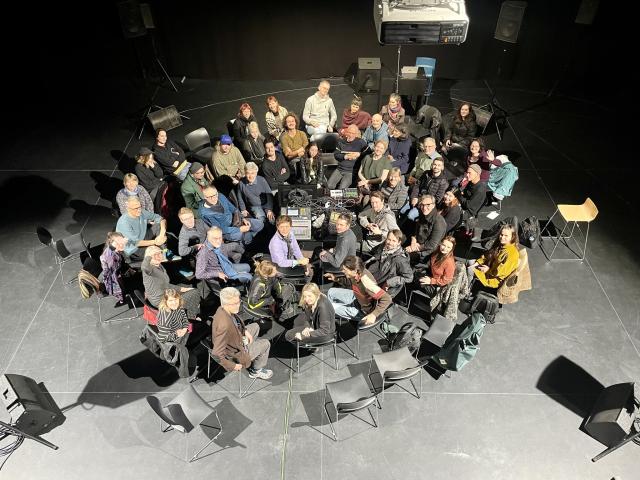
Participation in the Symposium is open to the public.
Content:
Locations:
Film Studio of the Moholy-Nagy University of Art and Design Budapest (MOME). Building II.
MOME is one of the significant European institutions of visual culture due to its traditions and intellectual background. In its effort to visualize its professional concepts MOME compounds its own character and traditions with the most up-to-date trends. Its educational structure comprises architecture, design, media, as well as theory.
Address
MOME Film Studio
Zugligeti Street 9, Budapest 1121Geo: 47.52307170753309,18.990429714643142
web.mome.hu
Coming from Pest, you reach Széll Kálmán tér by tram no. 4 or 6, or metro line no.1 (red line). From Széll Kálmán tér you get to MOME by bus no. 22 or 22A.
Get off at Szép Ilona busstop, and take a 5 minute walk. The bus no. 222, will take you directly to the main entrance of the University.
From the center, it takes cca. 40 minutes to get to MOME.
Organisation Team:
Chair
Advisory Board
Production and Organization
- Csaba Hajnóczy & Réka Farkas-Kovách
- Technical support: Adam Krasz and Tamás Molnár
Contacts
Email: beyondlistening@mome.hu
- tel: Csaba Hajnóczy: +00 36 706 84 6315
Web
- Lloyd Dunn ( nula.cc )
Support
Support Visegrad Fund
Partners
Jan Evangelista Purkyně University in Ústí nad Labem, Faculty of Art and Design
Institute of Cultural Studies, University of Wrocław, The Soundscape Research Studio
Constantine the Philosopher University in Nitra, Department of Cultural Studies, Faculty of Arts
Moholy-Nagy University of Art and Design Budapest, Media Institute
About the Beyond Listening Symposium
The aim of the Beyond Listening symposium is to provide a transdisciplinary forum for the achievements in recent years and to foster further exchanges, communication and networking during the years to come. We pay special attention to the region of Central Europe, but the geopolitical range of its subjects remains open to the broader world.
How to escape from listening paradigms that are based on expansive, colonial, violent and extractionist approaches? What can we learn from current ethical and political applications of acoustic ecology, acoustic anthropology, or bioacoustics? What can sound artists, scholars, activists and listeners, do beyond simply witnessing another wave of reports on declining biodiversity and the ongoing collapse of our planet’s systems? How can this ever more tangible and multi-sensory experience on a planetary scale be addressed on a local and collective level, beyond the "act of listening"?
The importance of environmental issues, especially as they relate to sound pollution in Central Europe, in countries like Hungary, Poland, the Czech Republic, Slovakia, and Austria, has for a long time been overlooked.
The gathering in Budapest is the fourth international event connected to the CENSE network. The Central European Network for Sonic Ecologies (CENSE) was established during an international conference held 2018 in Budapest. Since then, several other events and two further conferences have taken place: one in Ustí nad Labem, the Czech Republic Murmurans Mundus and one in Poland - The Second Life Of Recorded Sounds (on-line 2020). The Moholy-Nagy University of Art and Design Budapest (MOME), the main organizer and venue of the conference, is an eductional institution that systematically addresses issues of environmental sustainability.
Featured Keynote Speakers
- Gascia Ouzounian(UK)
- Budhaditya Chattopadhyay(NL)
- Jacek Smolicki(PL/SW)
Speakers and Presenters
Abby Lee Tee, Sam Auinger, Hannah Kemp-Welch, Grant Smith (Soundcamp cooperative), Kristine Diekman & Ben Pagac, Manja Ristić & Aleksandar Lazar, Liz K. Miller, Hanna Grześkiewicz, Julian Rieker, Ida Hiršenfelder, Ramon De Marco, Danny Clarke, Jan Solčáni, Eric Leonardson, Martin Heslop, Maja Bjelica, Dorota Blaszczak, OR poiesis (a.k.a. Petra Kapš), Melissa del Carmen Ernstberger & Luka Laval, Ari Koivumäki, Polina Katchenka, Bálint Kiss, Georgios Varoutsos, Christoph Brünggel, Arthur Enguehard & Gilles Malatray, Shluk (Sara Pinheiro et al), Guillaume Loizillon, Piotr Kędziora, Robin Parmar, Henry McPherson, Hugo Scurto, ooo collective (Eva Vozárová & Fero Király), Mary Edwards, Bea Targosz, Magdalena Manderlová & Michal Kindernay, Lorella Abenavoli & Arthur Enguehard, Ramon de Marco, Robbie Wing, Mári Mákó, Bálint Szabó, Július Fujak, Gabi Schaffner.
The program is subject to change.
Advisory board
- Jacek Smolicki(PL/SW)
- Anna Kvíčalová(CZ)
- Miloš Vojtěchovský(CZ)
CENSE QUESTIONNAIRE II. 2024

(photo by Matej Tomažin)
In 2021 we asked all members CENSE five open-ended questions as a way of taking the pulse of the community.The result was edited and distributed as a PDF Almanac publication, which you can download here from this site for free.
3 years later end of 2023 I sent the QUESTIONNAIRE II: What changed meanwhile and what didnt? Your answers could be included in the epublication The CENSE Almanac II - Rapyuta Thanks for your comments
Miloš Vojtěchovský
Questions II
1. What do you see as a positive development or achievement in environmental policy in general or within the community of Acoustic (or Sonic) Ecologies lately?
2. What do you consider as a common ground between the disciplines as composition, sonic ecologies, bioacoustics, environmental activism or art of listening in your field of expertise? Can you name any examples or initiatives you are currently involved in or would like to initiate?
3. Do you have opinion about the way how "de-contextualized" field recordings (or other captured sounds) are used in contemporary music scene (such as publishing recordings or doing live performances with field recordings as source material)?
4. Can you comment on the situation in your field of expertise concerning trans- or inter-disciplinary collaboration? What kind of and how much feedback is there between your acitivities, the broader community and the public?
5. What do you think could help to increase the involvement of broader public and / or policymakers to help promote positive changes in environmental consciousness and the policy of the country in which you currently live?
Answers
John Grzinich
1.There seems to be a growing number of people who are active in promoting sensitivity to the environment through listening. Whether this is through schools, education institutions or projects, I notice a healthy awareness about the scale of our unfolding crisis and that there are things that can be done on the ground. This awareness or willingness to engage in the issues at hand regarding the climate crisis are still not reflected widely in political discourse but there is still always time for this to change.
Obviously many of us are bound together in our sensory interest in sound and listening which brings us to common questions regardless of discipline, namely how can we contribute to awareness and change of perceptions and attitudes. Most recently I organized a series of events around International Dawn Chorus day, that included Listening Walks, and a Sound Camp’ for the 24hr Reveil broadcast. The participants were both from the general public and a diverse range of international students from the Estonian Academy of Arts coming from Media Art, Design, Architecture, Animation, Movement and so on. It is important not to overlook the diverse backgrounds and interests despite coming together for a rather specific niche event. What emerged was the need for such events to bring people together for a ritualized form of listening as a way to engage with the more-than-human world we share.
I am aware that there is an extractive element to de-contextualising sound, so I try to find a balance in recording, live streaming and contextual environmental listening to allow for diverse interpretations in what we listen to and the ways we listen.
My answer is similar to what I said above about ritualising listening to bring people together. I have engaged people from so many backgrounds, cultures, age groups etc in listening activities over the years, I can confidently say I have never seen any negative reactions from asking people to listen more in just about any context. This does however require a specific skill in communicating and facilitating aspects of the listening process so there is a fairly clear understanding about the intentionality behind guiding our ears toward different subjects and matters.
Well I intend to keep doing what I’m doing. Of course there are challenges involved in making larger impacts on policy or mainstream attitudes. We are up against some very deeply rooted colonialist habits and prejudices that feed destructive human-nature, human-human divides, threatening our very existence. There is no easy way out and unfortunately the conditions might have to get worse before they get better but let’s hope not.
South Estonia, May 2024 maaheli.ee
Grant Smith
A move from sites to situations. Work with sound as advocacy for (legal) rights of rivers and other (complex) environmental entities.
I'm listening to a live stream by Dorota Blaszczak from a summer house in Nowe Zalubice, Poland. It's an extraordinarily detailed evening chorus in a place that is also used by people, with sounds of diy, aircraft etc. This is using a streambox which the artist took back with them from the meeting in Budapest. This seems a simple, and in some ways remarkable, example of the possibilities for live transmission of environmental sounds. zalubice_nowe_summer_house. On 29 June, Soundcamp are broadcasting 'War-Torn Ecologies: Resistant Worlds from The Mosaic Rooms to Radio al Hara in Palestine. This is a multidisciplinary artistic programme, taking place in London and Beirut. At the same time we continue to develop Radio With Palestine, a series of live transmissions from demonstrations, direct actions, pickets, student encampments. This seems like a useful association.
For Soundcamp, context is important. If sound is being used in a more abstract way (also), the situations the sounds come from can be described, acknowledged and credited in accompanying notes etc. Why not?
A recent collaboration with Alice Eldridge at the University of Sussex led to a long-term live stream from a wilding site with beavers in Sussex, UK. The data set is intended for scientific analysis. The sounds have been of quite wide public interest. (https://wilding.radio/).
We are really interested in supporting a widening community of practice, rather than in addressing policy makers or a general public. We think sound can work in support of artists and activists and extend listening to less heard human and non human communities. With the legacy of the Free Radio movements, we are interested in how sonic ecologies can work in the service of emergent struggles (Brandon LaBelle. We want to develop transmission ecologies (Anna Friz) as the hard- and soft-wares and ways of working that can do that. That includes creating a 'live archive' of everyday resistance and resilience. If our work is turned to the public, we sometimes say, it is (only) 'half turned'. The other half is for us.
Soundcamp, London, UK soundtent.org
Július Fujak
- A realistic and real ecological environmental policy – if it is not connected with the madness of s. c. Green Deal – is very needed today at any level and in different areas of our social life and culture. The agenda of acoustic, and sonic ecologies is unfortunately overshadowed by other issues, especially in Slovak public discourse. But it is changing slowly. For example, in the awareness of how important it is not to create acoustic smog in schools, parks, and certain work environments, at least. But there is not only audible noise and dangerous acoustic smog. There are also hidden, almost inaudible electromagnetic sounds emitted mostly by our digital electronic devices (smartphones, computers, Wi-Fi routers, a stand-by regime of TV, radio, etc.) that are surrounding us almost everywhere, and irritating us plus damaging our health. We do not speak about this enough here.
- This common, symbiotic ground of musical composition (or comprovisation), sound/audial art and bio-/eco-acoustics is one of the ways to focus and point to the significance and real need to change our approach to the environment or space we live in. I try to analyze these topics in the fields of the semiotics of contemporary music (often in various intermedia contexts), as well as cultural studies, and postmodern theories of the late phase of transmuted capitalistic society vs. environmental democracy. I am involved in some scientific projects focused on related processes and phenomena; in artistic articulation, I devoted my time to the creation of s. c. musical/sonic sculptures, and occasionally to performances/sonic walks (also appearing under the pseudonym TJ Vjuga).
I am a big fan of not only the “de-contextualization” of the field recordings, and their public performances, or radio broadcasting, but I also prefer their re-/cross-contextualization in the dialogic context of contemporary music, or intermedia projects. In Slovakia, I can mention the very interesting projects of Jonáš Gruska and his LOM Space, or the sonic installations of composer Peter Machajdík. I created various acousmatic compositions that appropriated the field recordings of special site-specific time spaces (available also in one of my latest albums Transparent Sculptures, 2022/23), or I borrowed some field recordings for this kind of use (e. g. the concrete environments of Adriatic Sea of Manja Ristić incorporated in my composition La Mer, 2022 with her permission). We live in an era when any sound is pregnant with meaning and therefore is proto-musical – and not only because “no sound is innocent” (E. Prévost)…! :-)
Trans-/interdisciplinary research is the primary condition of semiotics, aesthetics, and cultural studies in general. In the field of sonic ecologies and the poetics of contemporary unconventional intermedia music, I cooperate from time to time with environmental/ecologic philosophers, (post)psychoanalysts, linguists, sound engineers, and musicologists as well. And the feedback? It depends, sometimes a little, and sometimes – if it is promoted in media (radio, magazines) or in some specifically orientated publications – the response is more noticeable.
First, it is necessary to raise public awareness of the fact, who is the main polluter and destroyer of our environment on a global scale. It's fine when we separate the waste, buy bio-/eco-products and so on, but… In the conditions of a current phase of trans capitalism – which causes far-reaching all-planetary crises (ecological one is “only” one of them) and is unable to solve them at all –, it is necessary to stop as soon as the global disaster and unprecedented pollution caused by the richest class - the oligarchs and their megacorporation networks (acting behind the visible political-economic structures) who are living at the expense of the rest “99%” of human population, flora & fauna. Environmental consciousness and policy in our country must decrease these harmful influences as much as possible, it must be not campaign-like superficial, not extreme as well unprofessional (with which we are meantime confronted too often). They should seriously consider all local givens and specifics, protect them as our cultural heritage, and respect and cultivate our environment anywhere we are on the Earth as the only time-space that allows us to survive.
Nitra, Slovakia monoskop.org
Guy van Belle
- This is a very complex 2-folded question: A. Environmental policy in general
I always try to see both the local and transnational context in which politics vs. social/cultural operations happen. Environmental policies are usually quite different in each country, even different according to regions. As long as we are thinking only top-down and from the national/regional perspective we will be facing continuous and increasing problems on the larger environmental scale. On one side there are the small petty policy makers we have to deal with, who are usually having different motives for making decisions and programs than the true care for the environment and the ecological situation, notwithstanding exceptions. Furthermore the ones that have to realize this are getting more and more de-synchronized from the former, and interpret/ignore it according to their own benefit as well, but don't adjust it for change. The same goes for an EU of representatives that choose for the impact of a green industry above a green environment in the first place, but carefully invest in window dressing and green washing. Let's see what soon the next EU and national elections will yield, but we don't expect a change in current pragmatic politics, which is increasingly using a public and moral disguise for safeguarding individual positions as temporary managers with a too high interest in personal gains instead of investing in a new social agenda, with the necessary ecological and environmental change. The result for what is happening now is obvious, as it leads for instance to increasing farmers' protests in each EU nation state, Czech bio food producers making their products rather available abroad, local activities dumping landfill at places where former natural lakes were, planting large areas full of the same crops and trees creating even a larger monoculture agriculture, and then we haven't started about energy yet. It is obviously all in line with legislation, but interpreting it in a specific way, aiming at a contrary output. Meantime we keep postponing environmental goals from 2025 to 2030, then to 2040 and so on and so on.
B. Within the community of Acoustic (or Sonic) Ecologies: Simply holding up a microphone, recording something, and creating an unverifiable story out of it does not make a change. Meantime my feet are sore from walking. It never did make any change for the last 50 years (as far as I can see, I am limited by age, sorry). I think we should all admit that the "community of Acoustic (or Sonic) Ecologies" is only a very small demographic percentage of the population without much impact in general, and certainly not on the environmental policies in general. Moreover we are rather in line with general art policies (only), and so with national and international policies. I'd rather believe we can longer term change these art policies, but in reality we only can divert a little. We can never change the art market for instance, which is the main driver behind the arts. Also, if we become part of the art market we will only make art for that market and not for any environmental change, logically. Maybe a reason to declare again: everyone is an artist, but it's also time to add this: let's only make environmentally friendly art. And let's tackle the next problem: how to deal with the technology we are all using for playing, recording, performing, traveling, working and living, etc. Last week we were looking with local people who were interested in recording underwater, how to help them with their equipment without forcing them to invest a lot of money in hydrophones and recorders, and other equipment for editing and sharing it. Listen, I am not a radical, I believe in diversity, contradictions and differences. But I haven't found a lot of solutions within the sub-sub-sub-..-sub sections of art called sound art. So let's work harder at it, but from within a larger community instead of an artistic niche (and we don't have to become social servants for this, as long as we maintain our experimental attitude, I see a lot of interest in general and esp. youngsters these days).
- An interesting phenomenon in the arts is the late 20th century vocabulary for the tendency to expand the arts with technological and material innovations. Every couple of years new terms and names for the same things emerge from art critique, thematic exhibitions or festivals, statements by artists. Probably it stems from the blindness, or impossibility to understand innovation and experiment, and at the same time the denial of multidisciplinarity within the evolution of art itself. Contradictory enough, the artists seem to embrace this with pleasure, and jump at every new occasion to ride the wave of new fashion, with a new label, while their art does not change much in itself, and art in general neither. Think of all the names that were given to electronic music since the 1960s. These days almost everything in music is getting labeled sound art, and so everyone becomes a sound artist, even if one is making some jazz or pop music, as long as it is being performed in a museum or gallery (which already ran out of ideas for decades).
I don't see a fundamental difference between the above mentioned terms: composition, sonic ecologies, bioacoustics, environmental activism or art of listening... They just indicate different approaches within treating the material of sound, and show merely the diversity of the business we are dealing with. Splitting and redefining sub-sub-sub fields for what are creative expressions only leads to useless fragmentations. When Klangkunst was invented in Berlin in 1994, the idea was rather to bring the traditional fragmented art disciplines together, and add the notion of sound to the hegemony of images and objects. And so now, when we think of extending art to non-human expressivity, adding social emancipatory or environmental notions, we can still call it just art, instead of community art, ecological art, or science art. Sound and image, word and movement are an important material to work with creatively. But maybe we can still warn audiences adding the term experimental or traditional or so, though I think it isn't of any use in the long run.
Ah, my own activities. Maybe they are not so important. Over the years I decided not to make any solo contributions to art. Which means that one can concentrate better on subjective issues within collaborations, in common settings. KRA[kra.land] is situated in the countryside, and we tend to work together with alternative organizations in the small rural city and villages around: a social café, a coworking space, a school in the woods, some bio farmers, musicians and other home workers. Motivating artists to work at something together is not so difficult: they have the need to do that to stay within the profession. But working with normal people can be quite challenging, since they are certainly interested in making and doing creative things, but usually they are not so keen on performing or exhibiting it before an audience. They have different goals in life.
Oh yes and there is also ButtuLab, formed in korona times, trying to boost new skills with new techniques. The 3D printing mainly produces decorative and functional objects (Vladimir Tatlin would have been proud of us), but it was already useful in the sporadic workshops on recording, making piezo and electret microphones. For the latest Reveil (2024) we produced a collective, spatial (binaural) stream from 3 locations 7 kms apart, at sunrise. So the KRA summer plans are mainly to look further into the role/importance of water within environments, it's natural presence/disappearance, the current (mis)management, and new possible attitudes within the countryside. The interesting thing with water that it leads to discussing biodiversity in general. We try to involve the immediate surroundings, and will invite very diverse guests from art, biosciences, etc... Apart from everyone else who is interested, all CENSE members are welcome. A free program combining the exchange of skills and techniques, field recording with local guests, listening moments outdoors will be offered for the weekend of August 15th. We want to repeat this in Fall, which will be announced in time. On general request we bring back the Irregular Summer Lazy Sundays [islas], in which people visit, talk, play music, eat and drink, plan and do nothing.
- In the light of what was written above about field recording and art, de-contextualization is a complex issue of course. It is following still what was accomplished in the 20th century, and keeping up the fashion. Like the old arts, art objects today are still put up in sterile white spaces. Often when there is a video or projection, a concert or listening session, the room is darkened during the daytime. Before and after it, everything is promoted in glossy magazines and on shiny screens. So all we seem to do is to isolate our works from life, which makes it easier for consumption and selling in the end. So de-contextualization is synonymous with art itself. On the other hand, let us not forget the nature of what we are doing. We are working with highly technological devices, only to represent sound to our ears. But recordings can never be identical to the original sound though it is still the better representation of sound and music than scores and annotations. Also the historical context is often ignored. Years ago, when asking a renowned field recordist what the impact was of the apparatus (recorders, microphones, the process of cutting and editing,...) he avoided all reflection on the evolution of the technology confusing his recordings with the real original sound. But the difference is of course obvious when you compare today's sound materials to the earliest known field recording with a wax cylinder (a Shama bird, 1889 by Ludwig Koch). Béla Bartók was using a phonograph to record and transcribe folk music. Walter Ruttman's Weekend (a radio piece) was recorded and cut on the soundtrack of an optical sound film. And now jumping almost a century, today when we are using digital recorders and even microphones (MEMS) which offer new possibilities for registrations and manipulations, we still make mere representations. A bird call hears differently when recorded and played back, than the same sound in the middle of a wood, or on an open field.
So, let's face it, we are all continuously making operations on sound, from cutting to normalizing, filtering, editing out what we don't like, spatializing it, etc.. Even if we are just trying to make the recording as similar as possible to the memory we have of what the original sound in context was. Sometimes we do it for the listener to hear this with a better quality or add contextualization. Furthermore, sometimes we want to overcome the limitations of our hearing system: we have a limited perception within the spectrum. Sometimes we want to hear what we cannot hear: infra and ultrasound. So, we have to work with algorithms and other processes - digital or analog doesn't matter here - to be able to (let) hear bats and insects, bacteria, etc... And let's be serious, if we want to understand the world better through sound, we are all embracing AI/ML: frequently I am using Chemnitz University's BirdNET or Cornell Lab's Merlin app on my phone to realtime identify birds (and subsequently look up pictures, read the bird's behavior, and listen to variations in the calls and tunes), as well as PlantNet for learning more about the surrounding vegetation. Basically we decontextualize the whole time, and isolate phenomena, maybe to model it. Don't we widen the context to understand more (but not always better). And then we are having an increasing number of tools to play around with the sounds. Using MUBU or FLUCOMA, artists can automatically splice their hours of recordings in a more meaningful way than we as humans can achieve, and include neighboring very diverse sounds according to their physical parameters. Adding newly synthesized models based on it, and relating gestural operations to it. Also using ambisonics, setting up simulations of dynamical 3D spaces offer interesting creative results with the registrations. You can call it de-contextualized but to me it looks more like creating new contexts and different environments. So let's confess: I committed all the sins described here above: recording as a purist, manipulating for the better of the sound experience, creating new inhumane environments. But only to keep diversity in, and stay critical within our small but complex tiny niche of art and culture. Maybe that is more meaningful for creativity. But maybe I am a fool and still don't know anything about the meaning of creativity. (I read somewhere that even Darwin was puzzled by it because it did not fit the rest of his assumptions and theories, could that be true?).
I never got a field, I was offered one in front of the house but it was too expensive, so I never acquired it. But I guess I have been working in the arts and in science, and mainly with sound, but connecting it to anything else. Connecting may be wrong even, because I see no separate thing here. Even in musicology, I worked for Prof. Marc Leman (IPEM + art science interaction lab /UGENT), who developed the concepts of systematic musicology and embodiment throughout his work. So apart from the idea that everything in music and sound does not exist without our human body, and it's movement, today they are making wide use of 3D representations, very precise motion capturing for interactions, and high definition spatial rendering for research and simulations. Basically everything I mention here breaks down the notion of purity and sound, and tries to identify the relatedness of all things without an environment. So my colleagues are technicians and bio-engineers, statisticians and mathematicians, musicologists, dancers and musicians. And it is fun to work together, across disciplines and skills. As my own artistic career ran parallel, a major switch happened end of the 1980s when I radically switched to computers and digital technology/programming. After that the gradual integration of image and data became almost as natural as the evolution of our machines. At that time some started discussions about the terminology, but to be honest, who in the arts ever cared about the ontological differences between trans-, multi- and intermedia. See above, for an explanation of the high-technological background of field-recording, and it's claim of purity. A second major change occurred for me while setting up an ecological art organization OKNO in Brussels. After 10 years working with people who were proficient in gardening, sensor and communication technology, bio arts of all kinds, we decided to disband to pursue our own different careers. Today we are still in contact, often commenting on the fun we had at the time, working together at art installations with bees and plants, running bio robotic experiments. The next phase for me was to work from a more natural location, in the countryside, as the need grew to connect with local communities and test alternative ecological visions. That is how KRA came about, and how we formed the connected band Rural Development. I think most of things we did had the attention and support it deserved, nothing more nothing less. It is not with the dogmatism of expansion and progress that impact and appreciation is made I guess.
- I read somewhere that moving as an artist to the countryside, you disconnect yourself from the arts. Yes, maybe from the general arts, and (again see above) its ultimate commercial and depending structural goals. Today I look at other similar groups and places across Europe, but at the same time how to involve local people. I must say there is more audience attending our rural program than there ever was before in the cities where I worked. Statistically it is better that from a demography of 20ppl/km2 20 people come, then 20 people from 500ppl/km2? It shows an honest interest bottom-up, even for experimental art, including field recording and sound art. Maybe it would be good all artists actively try to find niches where one can maintain and express their non-conformism and experimentalism. Let's connect those via a different view about what regionalism and nationalism can mean: convivial but ecological, and diversely creative.
Kravín, Czechia kra.land
Peter Simon
- Yes, we can do that. We should and must carry on and share our knowledge with the outside world. There are so many good ideas, concepts and work that need to be publicized.
- I see positive developments in environmental policy. However, they are not decisive and not fast enough and sometimes contradictory. There is a sensitivity for environmental issues. But there is also resistance, especially from large corporations. As far as acoustic ecology is concerned, it is still a niche topic. There is still a lot to do, because it is a part of ecology.
- Interdisciplinarity is the key word for me here. And also more practical experience. There are many initiatives that are active locally. The question is how this knowledge and experience can be pooled and how global exchange can be promoted. This requires financial support, which is hard to come by these days.
- I am pleased when such recordings are used. This definitely attracts attention. The context is important but not decisive. If only samples are used, this is a different use than if entire soundscapes are used. It's about the intention of the composition or the sound piece. Is it about sound ecology or music? Sometimes it's also interesting not to know the context, so you can engage with the sound in an unbiased way. And if I want to know something about the source material, then I simply ask.
- The most important thing would be to end all wars first. That would make it possible to shift the focus back to current environmental issues. And also to think impartially about consumption, knowledge transfer and science and to develop joint strategies. And to do so globally and honestly. We can see it right outside our own window. The masses of rain, for example, are a sign of the intensity and speed with which everything is changing. We see it every day in news reports from all over the world.
Cologne, Germany
Tomáš Šenkyřík
In this area, I consider the recent developments as optimistic: scientists, politicians, artists, various communities point to the topics that are related to the situation of the environment and that ecology resonates there. I am happy that representants from government do listen to municipal politicians concerning issues of ecology. Beneficial subsidy programs emerging which can significantly help to improve conditions of landscape. For example, regarding the problem how to sustain retention of water. On the other hand, there are many areas that need deep and immediate improvement. For the time being, we do not know how to treat sewage water systems. For example, in Židlochovice, it goes directly into the Svratka river. If we want to retain it in the landscape, we are not alowed because according to the law it is polluted water. But there are shifts in this area, even very slowly. But this is exactly a topic that can be approached from various perspectives and has great interdisciplinary potential.
Qualified academic articles dealing with such topics are published about common ground of these disciplines. From my point of view and my own practice, I consider the act of listening as a crucial issue. Because attentive listening means an approach which leads towards diminishing superficial relationships towards environment, through sound to look for an increasing awareness. Looking back on my own listening experience, I realize that I learned all about listening from regularly listening to dawn chorus in forest. This experience for me opened rather new perspective also regarding my concept of music and sound art. I am paying more attention to acoustic qualities of my own environment where I live on a daily basis.
I don't mind the decontextualized appropriation of field recordings, as long as the piece sounds good and if I apprecitate the composition. This proves that the author reached a new context, for example in terms of the harmonic, rhythmical relationships inside the composition as a whole. We are happy because we live in times when the recording technology is affordable to anyone and it isn't limited anymore to big music or radio studios. Everything on this area became more liberated and relatively independent. Following artists performing live with field recordings has always been big adventure. One of first I came across was Aki Onda's performance which was an incredible experience. The existence of labels specialized on releasing of field recordings is rewarding and inspiring. My main resource for discovering new compositions is the Bandcamp, or aporee.org, where one comes across field recordings from all over the planet and at the same time it is sound database for further creative work, full of very particular material.
About ten years ago I started systematicaly recording and mapping the South Moravia landscapes. I did not realize that field recording approach is open, and overlaps with many different areas and social topics. It surprised me how strong communication potential the field recordings gained in galleries as an independent section of culture institutions, how visual artists can be open towards sound art, how to relate to it, usually without preconsumptions that trained musicians sometimes tend to. Field recording can be an important part of the ongoing environmental debate and I think it's because of the very nature of sound. We can exactly interpret and analyze sound and field recordings, and the same time they trigger very deep emotions. For example, a sonic inquire of biodiversity in a floodplain forest: thanks to field recordings, it is possibly precisely analyze the biodiversity and to document extent to which human-caused noise affected it. If something harmful occurs on site and degree of biodiversity is decreasing significantly, those recordings documenting that process can be very emotional.
Politicians often reacting to what resonates inside community, the social topic and what can adress majority. That is why it is positive, that various environmental issues are resonating in mass media. People realize more than before that so many things are influenced by ecology. Those topics becoming more tangible and concrete. I see here a great potential for the local government representatives of smaller municipalities, cities and associations who can become an excellent partners for municipalities, successfully implemented environmental projects, both small and large. People both in villages and cities can perceive them, they can use them practically, they can watch the immediate effects. At the same time, they have personal experience of what some area looked before and after the successfully implemented ecological project. When we started with the first project here in Židlochovice, planing to build new wetland, to reduce the dust polution, get more water to the landscape, to plant forest park, there were many protests and petitions against it. People found out quickly how theis homes improve. Today we completed already next project: the flooded terains and a reconstruction of the meander of the Svratka river. Without protests against this plan, even this project is ten times larger than the previous one. The citizens and not only of Židlochovice, but from of the entire region, tourists and passers-by can watch that within few months the landscape improved. We used the excavated soil to build new green embankment to reduce the noise pollution coming from busy highway. I am systematically documenting all changes in soundscapes of our location through my field recordings. (translated from Czech)
Židlochovice, Moravia
REVEIL 11 - 2024
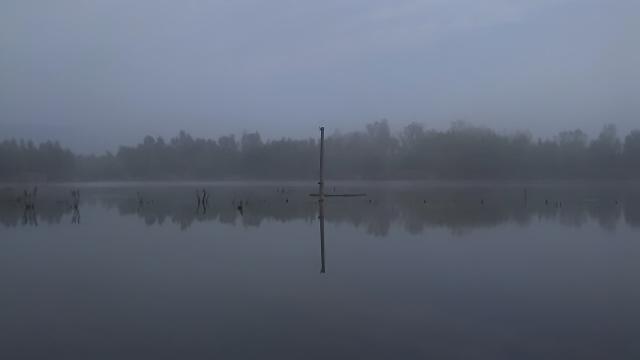
BROADCAST starts: SATURDAY 4 MAY at 06:00 (your location UTC+2)
REVEIL is a 24 +1 hour live radio programme, assembled and broadcast from a temporary station at Stave Hill Ecological Park in Rotherhithe. This is also the site of the longest running soundcamp. Real time streams are supplied by contributors around the world at daybreak. The primary feed is hosted by Wave Farm in the Upper Hudson Valley, New York, and aired by our UK broadcast partners Resonance FM / Extra in London UK and a collection of FM and netradio stations.
Streams come from a variety of locations and situations, at a time of day when many people are unaccustomed to be up and out, but sounds are vivid, especially in Spring. The Reveil broadcast makes room by largely avoiding speech and music, gravitating to places where human and non human communities meet and soundworlds overlap.
Each stream adds to and alters the loop.
REVEIL has become a habit and a practice of sharing sounds of places as first light arrives.
See the list of locations and streamer(s) and asociatives: streams.soundtent.org
Kozmic Meadows, Czech Republic
Streamers: Peter Cusack, Michal Kindernay, Magdaléna Manderlová, Lucie Páchová, Martin Režný, Tomáš Šenkyřík, Šárka Zahálková Broadcast time (your location UTC+2): SUN 04:40 - SUN 05:15 radio.aporee.org:8443/peterc
node9.lab Slaviky, Czech Republic
Streamers: Michal Klodner, Miloš Vojtěchovský Broadcast time (your location UTC+2): SUN 04:56 - SUN 05:32 radio.aporee.org:8443/mobilemic21
A backyard in Berlin Neukölln
Streamer(s): unosonic - udo noll URL: radio.aporee.org:8443/berlin_kreuzkoelln.mp3 Broadcast time (your location UTC+2): SUN 04:47 - SUN 05:26
Liberec-Radčice, Czech Republic
Streamer: Jan Krtička URL: liberec_v_rokli_liberec.mp3 Broadcast time (your location UTC+2): SUN 04:48 - SUN 05:25
House of Arts, Ústí nad Labem, Czech Republic, Czech Republic
Streamer(s): Jan Krtička
URL: locus.creacast.com:9443 Broadcast time (your location UTC+2): SUN 04:53 - SUN 05:29
Hranice KRA Chotěboř, Czech Republic
Streamer: Guy van Belle, The New Rural Development URL: (mobile_kra.ogg) Broadcast time (your location UTC+2): SUN 04:50 - SUN 05:26
Skaftfell Art Center Seyðisfjorður, Iceland
Streamer(s): Jan Krtička URL: seyðisfjorður_skaftfell.mp3 Broadcast time (your location UTC+2):SUN 04:40 - SUN 06:01 Coordinates: +65.261608°, -13.99790°
Krater, Ljubljana, Slovenia
Streamer(s): Brane Zorman, Urška Savič, Irena Pivka, Matej Tomažin URL: [animotmuzik]animotmuzik.ogg Broadcast time (your location UTC+2):SUN 05:09 - SUN 05:41 Coordinates: +46.067547°, +14.511281°
Mooste, Estland
Streamers: John Grzinich
and others
BROADCAST ENDS SUN 5 MAY 07:00 (your location UTC+2)
SPATIAL Sommer Lab Staňkovice
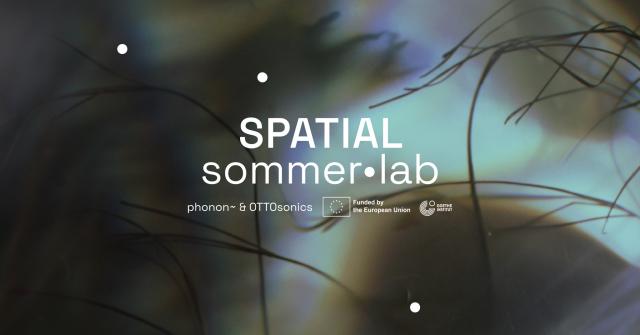
We invite you to the second edition of the Summer Laboratory of Spatial Sound in North Bohemia!
SPATIAL sommer lab take place from 5 to 29 July 2024 at the National House in Ústí nad Labem and at the cultural and residential centre
Löblhof & Artgrund in Staňkovice.
Thanks to collaboration with OTTOsonics, Tangible Music Lab, ZiMMT, IEM Graz, spæs - Lab Berlin, FUD a FF UJEP, SVITAVA - transmedia art lab,
we can offer quality educational content, open network of experts and artists and bring a unique program to the participants.
The SPATIAL consists of:
♨ a three-week residency for artists selected through an open call
♨ a symposium on spatial sound open to the public
♨ ambisonic concert MELUSINES presenting the outcomes of the residency on 27.7.
𝙎𝙋𝘼𝙏𝙄𝘼𝙇 𝙨𝙘𝙝𝙚𝙙𝙪𝙡𝙚
7.7. Listening to place: Staňkovice / Magdaléna Manderlová (workshop, Staňkovice, registration required);
8.7. Crafting sound in space / Jakob Gille(workshop, National House);
9.7. Ambisonics impulse response measurement and auralization / Manu Mitterhuber (workshop, National House, registration required);
10.7. Sound in gardens / Jan Krtička (workshop, Staňkovice);
11.7. Nothing to hear / Jan Burian (workshop, National House, registration required);
12.7. Phenomenological topology of localization within sonic environments / Martin Nitsche (lecture, National House);
17.7. Grapes – 3D audio control. A tool for creative live spatializing / Felix Deufel (hands-on session,Staňkovice, registration required);
18.7. Mazetools to motion / Jakob Gruhl (hands-on session, Staňkovice, registration required);
19.7. Out of the box: sound installations in 4 landscapes / Jiří Y. Suchánek (lecture, National House);
20.7. Spatial audio instruments / Enrique Tomás (lecture, National house, registration required);
22.7. Multichannel performance with digital devices / Francesco Corvi & Daniele Fabris (hands-on session, National House);
23.7. DIY hardware quadraphonic mixing / Jan Hrubeš (hands-on session, National House);
24.7. Ontology of noise / Vít Pokorný (discussion, National House);
27.7. MELUSINES - Ambisonics concert.
Löblhof is located approximately 20 minutes by car from Ústí nad Labem, for public transport look for connections to the stop 'Staňkovice, rozcestí; district Litoměřice.
Participation in the lectures is free of charge, although registration is required for some.
You can register by sending an email with the subject line "SPATIAL registration" to
𝙥𝙝𝙤𝙣𝙤𝙣.𝙘𝙧𝙚𝙬@𝙜𝙢𝙖𝙞𝙡.𝙘𝙤𝙢, mentioning which workshops and lectures you wish to attend.
We thank the Cultural Center of the city of Ústí nad Labem and Löblhof & Artgrund for their support and cooperation. The project is financially supported by the Ústí Region, the Ministry of Culture of the Czech Republic, Arts and Theatre institute within the SoundCzech program. This work was created with the financial support of the European Union.
The views expressed here can in no way be considered as the official position of the European Union.
more info:
KRAmp: Voda-La-Vida! - gathering
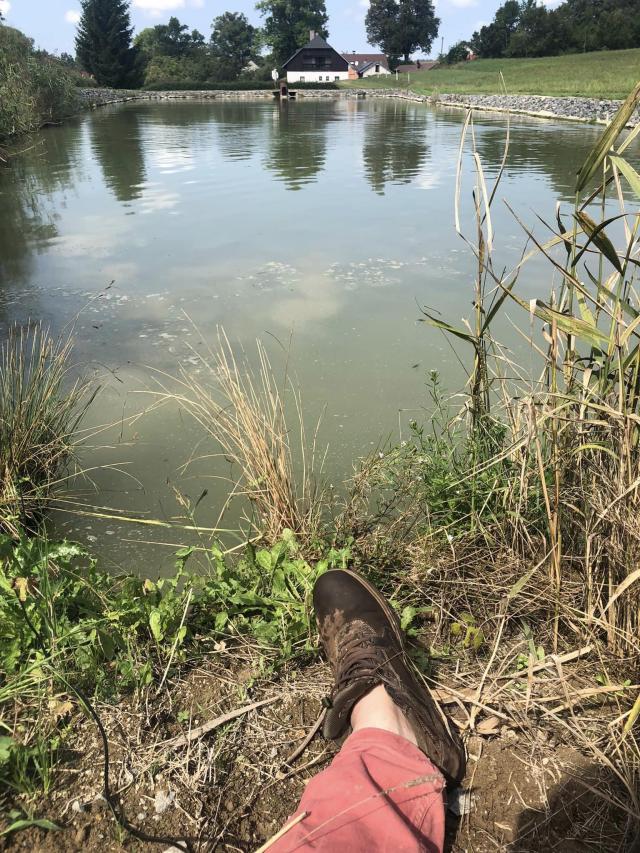
An international meeting KRAmp: Voda-La-Vida! about biodiversity through field recordings, both underwater and above. We invite you to participate in a program starting from exchanges and sharing of knowledge, techniques and equipment, to discuss advances in applied bioacoustics.
Mezinárodní setkání o biodiverzitě, poslouchání, terénním nahrávání, jak pod vodou tak nad vodou. Přijeďte a sdílejte zkušenosti, technické znalosti a vybavení, zůčastněte se rozhovorů o nových směrech třeba v oblastech jako je bioakustika, akustická ekologie. Během víkendu v chráněné zemědělské a přírodní oblasti Vysočiny nabízíme ubytování v kempu se zázemím v budově KRA. Těšíme se na vaši přítomnost a příspěvky: společné vegetariánské jídlo, společné procházky, společné rozhovory u ohně. Neformální a klidné prostředí je ideální pro sdílení a rozvíjení vašich aktivit a zájmů… Co vzít s sebou: stan, karavan, kolo, nebo spacák. Dejte vědět jestli se zůčastníte.
Připravily ve spolupráci:
KRA
CENSE
Zastávka194
KRA provides camping grounds and ruins for staying in a protected agricultural and natural area in the Czech Highlands (Vysočina). KRA team is looking forward to your visit and participation in the program. Share meals, walks, talks. There is a space for presenting, discussing, working on recordings.
Program
Sunday 18/08 - ARRIVALS
Evening: shared meal and gathering, inside or outside, according the actual weather conditions
Monday 19/08
10 - 12 AM SHARE YOUR IDEAS and SKILLS: participants explaining their approach or setups for (field) recording
13 -13 Lunch
14 - 16: Jonáš Gruska: On ultrasonic recording, listening, and DIY techniques
Jonas Gruska was born in Czechoslovakia and studied at the Institute of Sonology in Hague and at Music Academy in Cracow. His main focus is chaotic and polymetric rhythms, unconventional tunings, exploration of psychoacoustic properties of sound and field recording. He has created several site-specific sound installations, based on resonant properties of spaces and materials. Gave workshops on sonification, field recording, electromagnetic listening, and programming for artists. He is the creator of Elektrosluch – electromagnetic listening device. Long–time field recordist and lecturer. Currently interested in contrasts of biophonic and antrophonic environements in the city.
Tuesday 20/08
9 - 11 Miloš Vojtěchovský: hands-on workshop Wellness, Hygiene and Soda Bicarbonada or: DIY washing and cleaning which does not kill your own body, your mind and your field. - revised
The most comprehensive concept of "well-being" involves four dimensions: emotional well-being (subjective well-being), psychological well-being, social well-being and ecological well-being. Unfortunately, it turned out that the well-being factors can be in contradiction to each other.
Miloš Vojtěchovský is a curator, art historian, and audiovisual artist. In 1992 he founded the Hermit Foundation, later the Center for Metamedia in Plasy Monastery. Together with Peter Cusack started up the ongoing project Favourite Sounds of Prague sonicity.cz. He curated the Czech section in the international networking project Soundexchange and co-curated the symposium and festival vs. Interpretation held in Prague, 2016 by the Agosto Foundation and the Frontiers of Solitude project - 2015 - 2017. Other projects include: Deep Space Gateway, Soundworms Ecology Gathering, 2017, and Architecture and the Senses, 2018.
11 -13 WALKS: field recordings with local guides in the (un)natural environment
13-14 Lunch
15 - 18 Joanna Wyrwa: Echoes of nature, or developing somatic and embodied relationships to audio making. "Canceled"
Joanna is PhD candidate at the University of Environmental and Life Sciences in Wrocław. The topic of her doctoral dissertation concerns the assessment of the soundscape of urban green areas in the context of spatial planning. Her research oscillates between the humanities and natural sciences, education, and social geog-raphy. I am the author of a sensory multimedia project “Sensescape of Low-er Silesia” and the president of the Foundation for Landscape.
[dolnyslask-sensescape.space](http://dolnyslask-sensescape.space/ pejzaz.space)
20.00 DISCUSSION EVENING
By the way, who is making sound art in the countryside?
CENSE: to be or not to be?
Wednesday 21/08: SLOW DEPARTURES
Questions, don't hesitate to email: hinterland@kra.land
We start the days with a collective breakfast and planning. And gather late afternoon at the salad-soup-bar for socializing and sharing experiences.
Participants / organizers:
Givan Béla (bartok) - KRA Anne Wellmer, Den Haag Lenka Dolanová - Chotěboř, KRA Jonáš Gruska - LOM, Bratislava Ester - LOM, Bratislava Miloš Vojtěchovský - zvukac, CENSE Vítězslav Homolka - Butulab Jan Polívka, Butulab Mydla - SCPTU (Sonic Canine Planetary Trade Union)
Thanks to Lucie a František Pelouchovi from Zastráň Vegetable Farm for catering!!
Main organizer: Gívan Belá (fka Guy Van Belle was born in Belgium but moved to Central Europe after the milenium bug. Involved in experimental music since puberty, and retired from the arts since 2022, after a 22h homage to the first 20th century performing sound artist Arsenij Avraamov ('Symphony of Sirens', Baku 1922 - 100 years celebration) and Notker the Stammerer, ardent supporter of the now forgotten atekstalis genre and composer of the revolutionary polyphonic antifon Media vita in morte sumus (St. Gallen 912, 1010 years ago). Changed styles and definitions from Psycho-acoustic to Electronic to Digital to Multimedia to Interactive to Web/Network to Sound to Eko/Bio to Science to (finally) No Art. As a side hobby was organizing eko-techno-countryside residencies in Hranice/Vysočina (kra.land), running a very very local makerspace (buttulab.space), writing his memoirs calling it 'the biggest lies about the world and artists I can remember'. Was a founding member of the virtual off-grid online band Rural Development, the abstract dead metal band Digital Death & Afterlife, and the elektro-skiffle band Ostropest. Like Bela Bartok he considered field recordings the best representations of sound which is music. Because everything can then be recorded differently and still be authentic.
KRA – Kravín Rural Arts is situated in the Vysočina region of the Czech Republic – a hilly area of Železné hory (Iron mountains) – in a small village Hranice u Malče. KRA is establishing longer term programs with artists and other organizations in the countryside, interested in an ecological reconversion of the (media) arts. Apart from its own thematic lines, KRA is welcoming individual and group initiatives that are conform with its mission, and are interested in artistic-ecological research and development with a strong multidisciplinary nature. The future is the countryside, countrywide!
KRA = “floe” or “iceberg”, an allusion to ecology and climatic changes
KRÁ = “kaw” or “kaah” relates to raven as a symbol of art, playfulness and creativity. Ravens, among the few wild animals, make their own tools to play with. Raven in mythology are often a tricksters, disobeying rules and conventional behavior.
KRAVÍN (cowshed). Because it is to cows we are indebted for this place. … for the past actions and events you can go to: Yo-Yo, home of the infamous and irreplacable RurArtMap!
KRA partners include:
Zastráň Vegetable Farm
Central European Network for Acoustic Ecologies - CENSE
TO)pot - Festival of Radical Soundwalks - Ljubljana
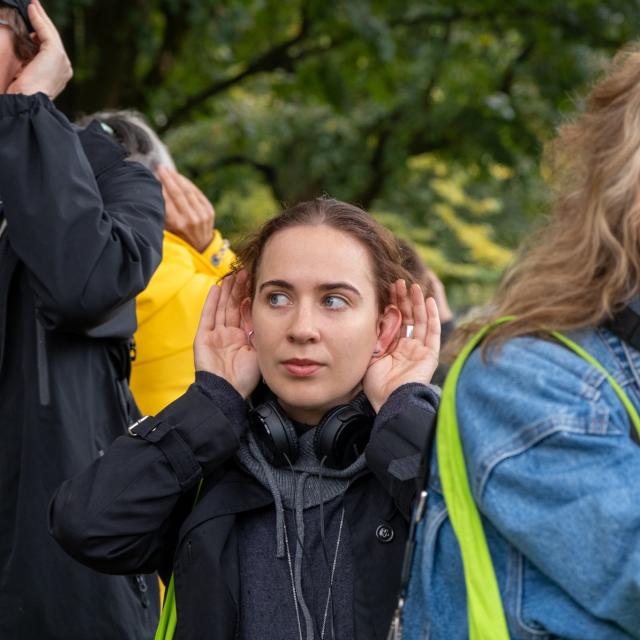
TO)pot, a festival of soundwalks, concerts, and reflections, brings together artists, theorists, and curious walkers to connect with spaces and more-than-human entities, transforming walking and listening into a spatial realisation of location. As a practice of grounding and attuning to the environment, walking becomes a radical attempt to decelerate the everyday pace of life.
Held during a unique time of the year, when the atmosphere clears and migratory birds change territories, the noisy starlings – now common city dwellers – fall silent, and plants enter their mature period. Amidst this backdrop, the festival offers, through selected artworks, a tapping into urban spaces and paths, highlighting their multi-temporality and thus offering the possibility of embodying space. TO)pot encourages a deeper reflection of how to live-with-spaces, encompassing all beings and entities.
Participants:
Augenmas • a l l j a • Colin Black • Maja Bjelica • beepblip • Nika van Berkel • Tetiana Khoroshun • Maria Magdalena Kozlowska • Rene Markovič • Spiro Mason • OR poiesis • Irena Pivka • plants • Karmen Ponikvar • Eduardo Raon • Urša Sekirnik • Jacek Smolicki • spaces • Sava šumi • urban animals • Tea Vidmar • zvukac • Brane Zorman • Tery Žeželj.
TO)pot event was organized by Brane Zorman / Irena Pivka / Matej Tomažin from www.cona.si.
Selection and introductory text: Irena Pivka Translation into Slovene, English and proofreading of festival texts: Melita Silič Cover image and design: Matej Tomažin Production: Brane Zorman, Irena Pivka, Matej Tomažin Coordination for Cukrarna: Alenka Trebušak Technical support: Brane Zorman, Andraš Šenica Pavletič, Martin Lovšin and the Cukrarna techical team, and the Cona support team Public relations: Matej Tomažin (Cona), Mojca Podlesek (Cukrarna ) Festival organised by: Cona, for the Steklenik Gallery Coproduction: Cukrarna Gallery / MGML
The pre-festival project’s Fent cua / While waiting partner is Emanat. The festival project’s If trees would cry, we would cry too and I walked for too long and I became a landscape partner is Bunker. The work gardenGOround is a part of the VITAL project. The co-producer of the premiere event Green Atrium of the City is the Museum of Architecture and Design Ljubljana. Research and paper presentation by Maja Bjelica is funded by ARIS through the research programme “Liminal Spaces” (P6-0279) and the research project “Grain of Salt, Crystallising Cohabitation” (J6-50196). The partner of the Festival Diary workshop is Radio Študent.
The programme of CONA is supported by the Ministry of Culture of the Republic of Slovenia and the City of Ljubljana, Department for Culture.
Miloš Vojtěchovský’s lecture was supported by The Arts Institute (AI) in Prague.
Images courtesy of Cona - Matej Tomažin
There was a meeting about the future of CENSE and the symposium planned in Ljubljana, September 2025 (Jacek Smolicki, Zvukac, Ida Hirsenfelder, Irena Pivka, Brane Zorman, Csaba Hajnoczy and Joanna Wyrva participated).
More info:
and
Open Call: Beyond Listening 2025: Walking-with changes
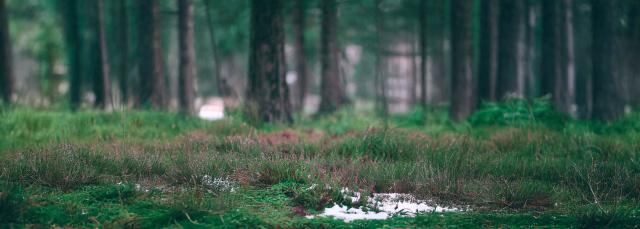
Open Call: BEYOND LISTENING 2025: WALKING-WITH CHANGES
23–26 SEPTEMBER 2025, LJUBLJANA
Deadline was: 10 Feb 2025
Building on the 2023 Beyond Listening: Agency, Art, and the Environment symposium in Budapest and the rich range of subjects discussed there, we invite you to submit a proposal in response to this open call for a follow-up event in Ljubljana (Slovenia) in 2025.
How can we escape from listening paradigms that are based on expansive, colonial, violent, and extractivist approaches? What can we learn from current ethical and political applications of acoustic ecology, acoustic anthropology, and bioacoustics? What can we, as sound artists, scholars, activists, and listeners, do beyond simply witnessing another wave of reports on declining biodiversity and the ongoing collapse of our planet’s systems? How can these ever more tangible transformations taking place on a planetary scale be addressed locally and collectively, beyond the act of listening?
Addressed in Budapest, these and similar questions remain relevant. Therefore, we invite scientists, philosophers, activists, artists, and others to continue listening-with these questions, rethinking them in a manner of being-with, and reposing them through walking-with, while focusing on changes that accompany our everyday lives, but also those that are less obvious and only surface as time passes.
By walking-with and listening to the “cultural turn” toward posthumanism we contribute to a shift in understanding humanity’s place within the world, challenging human exceptionalism and dominance. By walking-with and listening we engage in embodied practices that stimulate awareness of limited planetary resources and humanity’s destructive impact, from climate change to biodiversity loss. Such practices urge us to rethink the relationships with non-human life, technology, and ecosystems, advocating for an ethical shift and interdependent approach, to inspire coexistence for more sustainable futures.
Through changes in the environment, new concepts emerge that give meaning to the way we experience tuning and adjusting to the new conditions of being in the world. One of them is solastalgia. Unlike nostalgia, which refers to sadness due to the absence of home, solastalgia refers to the distress caused by environmental changes in one’s home environment. Glenn Albrecht, the philosopher who coined the term, describes it as “the homesickness you feel even though you are still at home.” Solastalgia is becoming an increasingly common phenomenon in a world facing ecological challenges, significantly impacting mental health and the sense of belonging. How does solastalgia manifest itself in acoustic environments and how can it inform sound practices and actions beyond listening?
Acoustic environments emerge through the complex activities of biological, anthropogenic, and geophysical processes. By paying attention to the practice of conscious listening (to soundscapes, but not exclusively), rather than focusing merely on the visual aspects and qualities of the environment, listeners can attain different kinds of insights and understandings of the surrounding environment. For example, through attentive listening we might be able to observe and understand more details about the relations between various actors, events, and species, and perceive how they change over time. Through embodied and situated listening we might also become more careful and critical observers of power relationships that orchestrate how we navigate our shared environments and negotiate our entanglement within them. We suggest that walking-with, as a way of being, collaborating, connecting, and co-creating with other spaces and environments, goes beyond mere physical movement—it involves presence, listening, and interacting with the stories, sounds, and textures of a place. It emphasises a collective and sensory experience, creating space for an ethical relationship with the world we live in. What modalities of listening- and walking-with can we engage with to inspire new or regenerate old but meaningful perspectives on environmental changes that affect all of us today?
The 2025 CENSE Symposium provides a transdisciplinary forum for sharing recent developments and fostering further exchange, collaboration, communication, and networking. While we pay special attention to Central Europe, the geopolitical range of topics remains open to the broader world.
We are looking for topics that address the potential of sonic ecology in these areas:
_ Walking-with changes: rethinking walking as a method of inquiry, approaching listening-with your feet, soundwalking;
_ Listening-with and beyond disciplines: employing the convergence of art, science, and technology in sonic ecosystems;
_ Staying-with solastalgia: experiencing distress induced by environmental change in our home environment;
_ Resonating-with lessons learnt from listening to the Anthropocene, addressing inequality, discrimination, and social justice;
_ Being-with other-than-human sonic environments (ecoacoustics and bioacoustics) and engagement with environmental activism;
_ Rethinking-with local and regional, historical and contemporary epistemologies and ethics of environmental awareness.
We welcome proposals for papers, presentations, peripatetic lectures, performative lectures, and other unconventional formats to be presented in person at the symposium. We especially encourage challenging, innovative—even provocative—contributions which go beyond traditional formats of papers and talks that dominate academic conferences and symposia. In the selection process, we will prioritise experimental, engaging, and hands-on proposals. We envision the symposium as a place for thorough and significant engagement with and dialogue about the issues that are in our collective interest.
We kindly invite you to submit your proposals through the application form available at this link. The description of the proposal is limited to 1300 characters with spaces. Make sure to add all the information we need to ensure all the requirements for your intervention are met (additional space is available at the end of the application form).
The deadline for applications is 10 February 2025.
Selected applicants will be notified by 15 March 2025.
Compared to the previous edition, the 2025 CENSE Symposium in Ljubljana is planned on a smaller scale. Therefore, the number of selected papers will be limited. Nonetheless, we believe that the symposium will provide a great opportunity to address pertinent themes and emerging challenges of sonic ecology and beyond, especially as it will be organised as part of the Festival of Radical Soundwalks TO)pot.
The 2025 CENSE Symposium has no participation fee. For presenters, access to all symposium and the festival events is provided free of charge. Please note that presenting participants are responsible for covering the costs of their attendance, such as travel costs, accommodation, and meals. Presenters will be provided with an invitation letter.
Contact: symposium@cense.earth
The CENSE Symposium Beyond Listening 2025: Walking-with Changes (Ljubljana, Slovenia, 2025) is produced by CONA Institute, co-organised by the Science and Research Centre Koper, Institute for Philosophical and Religious Studies, and facilitated by the Cross-European Network for Sonic Ecologies.
Symposium’s programme board:
Scientific committee: ELENA BISERNA, JACEK SMOLICKI, MAJA BJELICA
Organising committee: IRENA PIVKA, IDA HIRŠENFELDER, MAJA BJELICA
Symposium’s advisory board: Csaba Hajnóczy, Miloš Vojtěchovský, Brane Zorman, Petra Kapš
The Cross-European Network for Sonic Ecologies (CENSE) is a network of diverse voices from the fields of arts, science, and activism. The network works towards an increased awareness of developments in the social and cultural spheres of Central Europe (and beyond) with a particular focus on environmental transformations and their wide-ranging effects. CENSE was established in 2018 during an international conference in Budapest. Since then, three further conferences have taken place: in the Czech Republic Murmurans Mundus in 2019, in Poland in 2020, and in Hungary Beyond Listening: Agency, Art, and the Environment in 2023.
CONA, Institute for Contemporary Art Processing is an NGO from Slovenia. Its main activities are the production and promotion of new media and sound art in connection with nature, the environment, and sound, with the goal of socially and ecologically responsible cultural collaboration. The Festival of Radical Soundwalks TO)pot gathers artists, theorists, and walkers to bring them closer to walking and listening as a spatial acting-out of the place and the body; as practices of reading, creating, grounding, immersing, being acted upon and acting in the environment; as ways of experiencing our myriads of entanglements and interdependencies with other human and non-human beings and the world.
The festival is produced by CONA, financed by the Ministry of Culture of the Republic of Slovenia and the City of Ljubljana, Department for Culture. It is hosted by Cukrarna, a partner of the festival TO)pot.
The Science and Research Centre Koper(ZRS Koper) works on an interdisciplinary basis, involving humanities, social and natural sciences, with special emphasis given to research in the specific environments of the Mediterranean and the Upper Adriatic region. Its Institute for Philosophical and Religious Studies focuses on contemporary philosophy, social and environmental ethics, comparative religion, digital theology, and feminist studies, and engages in a variety of collaborations across the fields of philosophical and religious studies.
ZRS Koper is collaborating at the symposium within the framework of the basic research project “Grain of Salt, Crystallising Cohabitation: Salt-making as Experiential Environmental Wisdom” (J6-50196) and the research programme “Liminal Spaces: Areas of Cultural and Societal Cohabitation in the Age of Risk and Vulnerability” (P6-0279), which are financed by the Slovenian Research and Innovation Agency (ARIS).
Support by
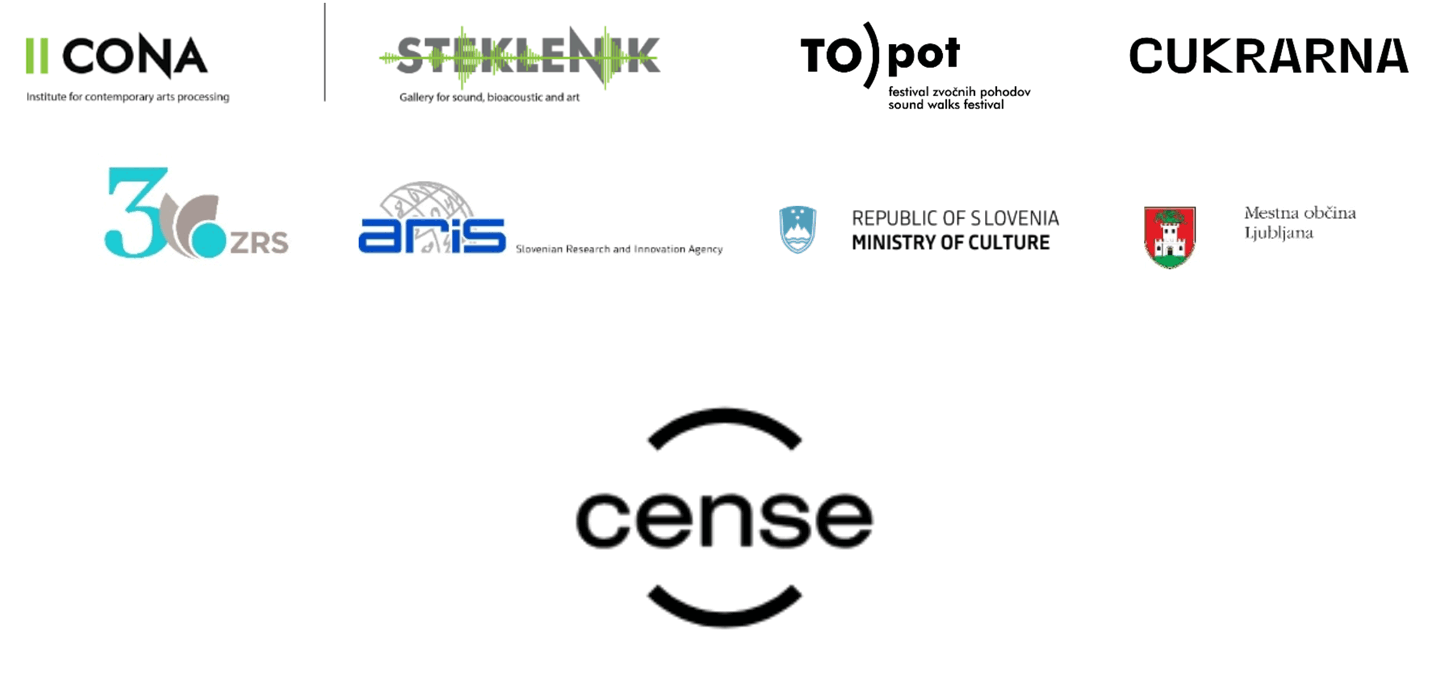
SOUNDCAMP / REVEIL 2025

CENSE invites and supports the upcoming SOUNDCAMP / REVEIL
Reveil is a collaborative sound and transmission project that circles the Earth on live audio streams at daybreak every year. The last broadcast 2025 featured over 100 streams from a wide range of continents, environments and situations. You are invited to join for the next 24+1 hour loop in 2026. Starts in London, Saturday 6am
You can listen to the dawn chorus internet stream or/and listen at daybreak without technology. You hear milions bird songs together with many people and other beings around the globe and simultaneously.
List of CENSE related streams and locations, open microphones for Reveil 2025
Sunday May 4th 2025 - Sunrise
Ireland
Streamer(s) Unisol (Slavek Kwi)
location: Soundctuary Cappaduff, Mountshannon, Clare
Latitude: +34.4346°
Longitude: +35.8362°
garden associated with tree dominated area surrounding, not far from large lake Lough Derg.
about location with many examples of recordings:
here
about human interaction with surrounding environment, including WSi (weather sensitive installation): here
about synchronicity concept:
here
uni.Sol_special: “REVEIL 2025”
The act of LISTENING - as tuning to a particular state of mind - seems the key for “true connection” between entities of this realm. In that sense it seems rather irrelevant if we are listening to the same sonic reality and if we are using some technological tools or extrasensory communication. uni.Sol_ participate regardless of location, opening the portal of omni-connection for a duration of 2 hours starting from the Atlantic side of Ireland Saturday 3rd May just before sunrise at 5:00 AM. Sharing recordings for the purpose of observing synchronicity is optional, however very welcome. Feel free to send recordings here: uni.solar.event@gmail.com
here
Sweden
Streamer(s): EKOTON (Jacek Smolicki)
location: Stockholm, Lidingö
Latitude: +59.3772147960482°, Longitude: +18.117328213462912°
This stream takes you to the edge of the forest on Lidingö island in Stockholm. It is a particularly interesting and vibrant kind of a local ecotone, a transitory zone where several different ecosystems meet.
Estonia
Streamer(s): John Grzinich, EKA teachers and students
location: Ahja River Valley, Põlva County
Latitude: +58.10729394696085° Longitude: +27.067280733428685°
A Sound Camp for students of the Estonian Academy of Arts will be held in the Ahja River valley near Taevaskoja from Saturday to Sunday, May 3rd and 4th. The camp is by a double-arched stone bridge that crosses the river and is surrounded by a patchwork of mixed forest and cultivated farmland. (streaming Sunday early morning)
Germany
Streamer: Peter Cusack
location: Fauler See, Berlin
Coordinates: +52.554499°, +13.493975°
Broadcast time: SUN 04:49 - SUN 05:27
The Fauler See is a small lake surrounded by woodland that has been a nature reserve in Berlin since 1933. A good variety of birds can be heard, both woodland and wetland species. The Berlin city roar is always in the background.
Streamer: Udo Noll / radio.earth and Bauhaus University Weimar
Location 1 - Island of Koos
coastal flooding mire, mashes, 10 kilometres northwest of Greifswald
Solar powered station by Udo Noll / radio.earth and Bauhaus University Weimar, dept. for sound studies and acoustic ecology.
location 2. - Backyard in Berlin Neukölln
location 3. - A garden in Kirchmöser Ost, Brandenburg
Bohemia
Streamer: Jan Krtička
location 1. Liberec-Radčice
Latitude: +50.80506357040138° Longitude: +15.070941219334436°
The stereo microphone is placed on the roof of the family house, which is located on the outskirts of the city of Liberec.
locus.creacast.com:9443/liberec_v_rokli_liberec.mp3
location 2. - House of Arts, Ústí nad Labem
Latitude: +50.6664880198452° Longitude: +14.013172970467144°
Stereo mic placed on the west facade of the House of Arts gallery in Ústí nad Labem
locus.creacast.com:9443/usti_nad_labem_duul.mp3
Streamer: Frank Herbrand
(no cense member)
Dolní Poustevna
50° 59' 43.4" N, 14° 18' 43.2"
URL: karlincam.fherb.de:8000/karlinsound/live.mp3
(continuous stream on LS server)
Dolni Poustevna is a small village new Czech German borders Stream provides sound for BirdNetPi, BirdWeather and friends of Karlin. www.karlincam.cz
Design, installation, operation, sound preprocessing and maintenance: (herbrand@gmx.de)
Streamer: Michal Klodner (not a cense member)
location: Livinglab Slaviky
(continuous stream on aporee)
Livinglab as a multidisciplinary place brings new methods, not possible by single research walks or in full-scale labs. Instead observation of subjects in artificial conditions there are characteristic features of co-creation, experiential learning, prototyping involving communities and inclusive social space. The warm and hospitable limestone area of the Czech karst is the most important karst area in Bohemia.
Streamer: Tomáš Šenkyrík
Location 1. Brno — Lužánky
49° 12' 18" N, 16° 36' 36.7"
continuous stream
Park Lužánky, Ponava Cafe & Radio
locus.creacast.com:9443/brno_luzanky.mp3
opearated by Tomáš Šenkyrík, Vit Kalvoda, Udo Noll
Location 2. - Rusava, Czech Republic
Coordinates: +49.340557°, +17.676233°
Broadcast time: SUN 04:47 - SUN 05:21
URL: (tomas_senkyrik.mp3)
Streamer(s): Guy van Belle, Gollo Foellmer, Dom Leroy
location: Hranice/Chotěboř
Coordinates: +49.763776°, +15.692146°
The USB-C [The Underwater Skiffle Band Collaboration]
Broadcast time: SUN 04:53 - SUN 05:28
cast.multiplace.org/WaterStreamsDawn
Streamer(s): Martina Valášková (Muzeum of Prague, sonicity support)
location: Tiché údolí, Roztoky ais a nature reserve, located between Prague and the town of Roztoky, A deep listening session, small group recording activities, discussions with ornithologists and fellow participants about the role of sound in biodiversity research. Breakfast at the end of the session.
Coordinates: +50.148258°, +14.375099°
Broadcast time: SUN 04:56 - SUN 05:32
roztoky_tiche-udoli.mp3
Nonstreamer: Zvukac location: rocky mountain range above Únětice and Tiché údolí, Prague listening and looking session to local roaring airplains and singing birds
Streamer: Michal Kindernay
location: Skryje, Křivoklátsko,
Coordinates: +49.968728°, +13.772122°
No stream URL
Broadcast time: SUN 05:00 - SUN 05:35
Streamer: Martin Lauer
Latitude: +50.756337°, Longitude: +15.248367° A serene site by a cottage on the edge of a forest
(https://streams.soundtent.org/2025/streams/utc2_-6fc2b0b6-f73c-4f4b-894e-36011df41880)
Slovakia
Streamer(s): Fero Király, Eva Vozárová, zdruzenie.ooo
Diamantová street, Košice, Slovakia, Europe
URL: košice_ooo.mp3
Broadcast time (your location UTC+2): SUN 04:35 - SUN 05:09
Coordinates: +48.714486°, +21.223742°
https://streams.soundtent.org
Jonáš Gruska no location yet, no URL
Poland
Streamer: Dorota Blaszczak
Nowe Zalubice,
Latitude: +52.47202417482955° Longitude: +21.1595605947854°
A forest and meadow ecotone in a neighborhood of summer houses, with some villages, a highway and train tracks in a distance.
URL: https://streams.soundtent.org
Hungary
nonstreamer:Csaba Hajnoczy
a live act with Terep Project and musicians based on the Reveil, improvising with the broadcasted sounds. from 6 pm to 8 pm CEST, in the room at MOME. https://csabahajnoczy.com/
Romania
Nonstreamer: Anamaria Pravicencu Bucarest Listening session in park (http://www.semisilent.ro)
USA
Streamer: *Eric Leonardson** CHICAGO-CAMPSHERWIN
Reveil radio event is produced since 2012 by Soundcamp, last years usually in collaboration with Locus Sonus and the Acoustic Commons / network.
Listen to the collage from the sounds from 2020
To ask, please be in touch for next year: contact@soundtent.org
Thank you for your interest and support!!
Cense Cooperative
Dawn Chorus Reveil on Bandcamp
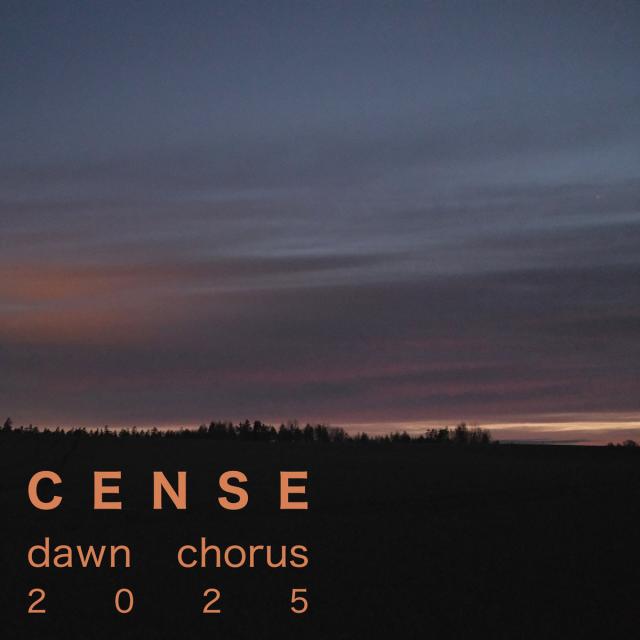
These broadcast recordings were made by several CENSE members during the annual Reveil Dawn Chorus radio event on May 5th, 2025. The event is a 24 hour continuous broadcast that mixes live audio from environments around the planet. Reveil was initiated and organized by a group of sound artists and activists known as the Soundcamp Collective. They collaborate for many years with numerous institutions, public radio stations and initiatives around the globe, including the Locus Sonus art collective of the University of Aix-en-Provence or radio aporee.org. The Locus Sonus and aporee provide a technical system consisting of open microphones and a streaming servers, securing the means to live-stream from various places around the globe.
Members of CENSE have taken part in this years Reveil project and generously contributed their recordings from live streams. On this edition, you hear the similarities and differences between the dawn choruses of Romania, Czechia, Slovenia, Germany, Estonia, Ireland, Poland to name a few.
We would like to thank all who woke up very early in the morning to make recordings, edit and provide their contributions for this CENSE compilation#2. The works selected were edited and mastered by John Grzinich and thanks to zvukac for continued narrow casting, Grant Smith and others from Soundtent to maintain the project.
(Cover photo by John Grzinich)
List of recordings:
Anamaria Pravicencu - Cismigiu Gardens, Bucharest 10:01
Bostjan Perovšek - Hills around Cerkno, 05:36
Dorota Blaszczak - Nowe Zalubice#1, before Reveil, 08:18
Dorota Blaszczak - Nowe Zalubice#2, 03:44
Guy van Belle - WaterStreamsDawn, live stream Part 1, 07:55
Guy van Belle - WaterStreamsDawn, live stream Part 2, 08:06
Jan Krtička - Liberec-Radčice, 11:05
John Grzinich - Otteni Veski, Dawn Chorus, 11:20
Cmiter - Tiché údolí, Roztoky, Prague. 06:31
Martin Lauer - Cabin by a Creek, Jiřetín pod Bukovou, 04:50
Michal Kindernay - Sounds of a Garden, Skryje, 13:24
Peter Cusack - Fauler See#1, Berlin, 04:33
Peter Cusack - Fauler See#2, Berlin, 04:33
Slavek Kwi - Soundctuary Cappaduff, 08:26
Tomáš Šenkyřík - Forest Dusk, Rusava - Hrklávka, 07:57
LINK TO THE ALBUM: Cense Dawn Chorus-2025
(recordings are free to download, and you can purchaise - support the Cense Project, if you like)
The compilation from CENSE Reveil 2021 was reedited and republished here:
TO)pot Festival / Beyond Listening Symposium 2025

3–27 Sept 2025, Ljublana, Slovenia
Locations: Cukrarna Gallery, Sečovlje Salina Nature Park, City Museum of Ljubljana and public spaces.
The Festival of radical soundwalks TO)pot, features soundwalks, concerts and critical reflection, and brings together artists, theorists and curious walkers in dialogue with spaces, their temporalities and more-than-human entities. The festival’s subtitle, Walking-with Changes, points to the potential of walking and listening as practices that foster a deeper understanding of place and its shifting constant.
Through attentive listening, walkers are invited to adopt a critical approach to the environments they inhabit – or, in the context of migration, are still learning to inhabit – and to attune themselves to both local and global landscapes.
The 6th CENSE international Symposium - Beyond Listening 2025 is embedded within the broader framework of the TO)pot festival. The CENSE Symposium is produced by Cona Institute, co-organised by the Science and Research Centre Koper, Institute for Philosophical and Religious Studies, and facilitated by the Central European Network for Sonic Ecologies.
FESTIVAL CO-CREATORS
Piotr Armianovski ● Jaka Bombač ● Nikola Drole ● Lina Eržen ● Anna Friz ● Tadej Grum ● Tetiana Khoroshun ● Anna Khvyl ● Neža Knez ● Felisa Ko ● Zala Kramperšek ● Maša Milčinski ● Eva Mulej Vrabič (Oka) ● Boštjan Perovšek ● Ajda Pirtovšek ● Martyna Poznanska ● Brane Zorman
SYMPOSIUM CO-CREATORS
Sara Anjo ● Maria Balabas ● Maja Bjelica ● Pia Brezavšček ● Cha Caillat ● Ádám Darázs ● Kristine Diekman ● George Edmondson ● Mary Edwards ● Arthur Enguehard ● Darko Fritz ● John Grzinich ● Csaba Hajnóczy ● Ida Hiršenfelder (beepblip) ● Bálint János Kiss ● Eric Leonardson ● Hugo Lioret ● Kevin Logan ● Juan José López Díez ● Ben Pagac ● Ivan Penov ● Carina Pesch ● Karmen Ponikvar ● Saška Rakef ● Mersid Ramičević ● Ján Solč̌áni ● Rok Šturm ● Mike Thompson ● Madina Tlostanova ● Georgios Varoutsos ● Eva Vozárová ● Joanna Patrycja Wyrwa
Friday 26 September
9 a.m. Meeting of the Central European Network for Sonic Ecologies, members & friends, 120 min.
2 p.m. "Listening ahead" - Meeting of the Central European Network for Sonic Ecologies members & friends, 120 min
in projection hall of City Museum of Ljubljana,
As part of the TO)pot festival, Cona, in collaboration with the Science and Research Centre Koper (ZRS Koper), is co-organising this year’s CENSE (Central European Network for Sonic Ecologies) symposium: Beyond Listening 2025: Walking-with Changes. The event brings together more than 30 scientists, theorists, artists and authors, selected through an open call. The programme committee has curated the symposium into three distinct formats: panel discussions, peripatetic lectures and listening posters. The symposium forms a core part of the festival’s theoretical strand, highlighting the significance of acoustic ecology and walking as a method of inquiry and engagement. Continuing its tradition, Cona is also organising field trips for in-situ listening and sound recording. This year, these excursions are enriched by a full-day visit to the Se.ovlje Salina Nature Park, which will also host part of the symposium programme.
This year’s TO)pot festival presents three premieres of soundwalks produced by Cona in 2025 Bodies of Water by Eva Mulej Vrabi (Oka) and Jaka Bomba., Following by Neža Knez and VRTATYS’ by Tetiana Khoroshun and Felisa Ko – as well as tremolo, a sound event by Brane Zorman and Boštjan Perovšek.
Symposium’s programme board: Scientific committee: Elena Biserna, Jacek Smolicki, Maja Bjelica Organising committee: Irena Pivka, Ida Hiršenfelder (beepblip), Maja Bjelica Symposium’s advisory board: Csaba Hajnóczy, Miloš Vojtěchovský, Brane Zorman, Petra Kapš
Symposium in the Field: Walking and Listening in the Sečovlje Salina Nature Park, the whole-day experiential happening of the symposium is supported and implemented by the company SOLINE, d.o.o. / the Sečovlje Salina Nature Park, Maritime Museum “Sergej Mašera” Piran and Muzofil Association.
The CENSE Symposium is produced by Cona Institute, co-organised by the Science and Research Centre Koper, Institute for Philosophical and Religious Studies, and facilitated by the Central European Network for Sonic Ecologies (CENSE)
The CENSE Symposium Beyond Listening 2025: Walking-with Changes is financially supported by the Slovenian Research and Innovation Agency (ARIS) through the research project “Grain of Salt, Crystallising Cohabitation: Salt-Making as Experiential Environmental Wisdom” (J6-50196), implemented at the Science and Research Centre Koper.
CONA Institute for Contemporary Arts Processing Office and studio: Trg prekomorskih brigad 1 1000 Ljubljana info(at)cona.si
